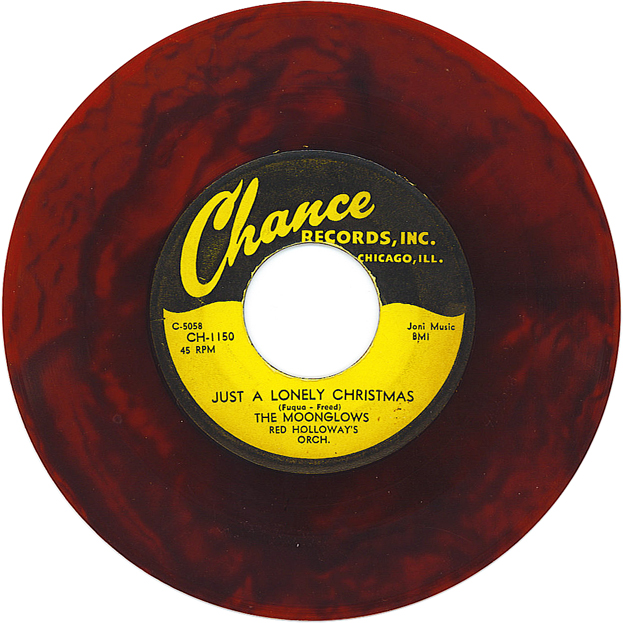
Revision note: We've provided more accurate background on Kitty Stevenson, whose Vitacoustic sides were acquired by Art Sheridan in 1952 (but not released on Chance). We've updated our listing for "Everything I Have Is Yours" by the Four Shades of Rhythm, which we can now also identify as a track originally recorded for Vitacoustic (even though we know only a Sensation matrix number for it). We have added some information about Art Hoyle, who worked with Schoolboy Porter, and about Don Ragon, whose band appeared on one Chance pop release. Courtesy of Big Joe Louis, we have a little more information about Chance 5001 by the Southern Clouds and Chance 5009 by the Boyer Brothers. We have added some material on Buddy DiVito, whose "Take My Heart" (released for a hot minute in 1951, on Tower 1508), may have been reissued on Chance 3015. DiVito had also made a single for Sharp in 1952, during that label's decline phase. We are able to say a tiny bit more about Henry Green, who was definitely a gospel performer. We are still upgrading our biographies of Lucy Reed (Chance 3006 and 3019) and Elaine Rodgers (Chance 3001). There are a few Chance releases we need to know more about, such as Chance 1100 by Arnold Jones, and Chance 5004 and 5005 in the gospel series. In the 3000 pop series, we'd still like to know for sure whether the Four Bits (Chance 3003) were the comedic quartet from South Florida... We'd also like to know who Jack Nelson was (Chance 3004; he later recorded for Stepheny), but we've come a long way.

Chance Records, like Parrot, United, and Aristocrat, was an independent Chicago label that pioneered in recording the new African-American sounds that swept the city after World War II: the electrified Mississippi blues and the doowop harmony groups. Chance cut 360 known sides from September 1950 through October 1954. In addition, Chance purchased or licensed at least 44 sides. We know of 94 releases on Chance, accompanied by 1 on its very short-lived tributary Meteor and 9 on its later subsidiary Sabre.
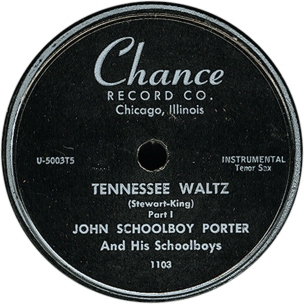
Although the blues and doowop garnered Chance a place in history, the company recorded pop, jazz, and gospel, and this discography is designed to profile those aspects of the label as well. The jazz sides were by the Wally Hayes Combo aka Calumet City Boys aka The Chanceteers, John "Schoolboy" Porter, the Jimmy Binkley Jazz Quintet, Chubby Jackson, Conte Candoli, Johnny Miller, and Remo Biondi. Schoolboy Porter recently got a limited-edition 10-inch LP from Japan; otherwise, just two of the jazz sides have been reissued.
The bulk of Chance's output was in the R&B field, which reflected the knowledge amassed by the label's founder and owner, Art Sheridan. Sheridan (born July 16, 1925 in Chicago) had been running a distributor and a pressing plant, where the preponderance of his work was with African-American-oriented product. The main Chance 1100 series, the temporary Meteor 100 series, and the Sabre 100 series concentrated on blues, jazz instrumentals, doowop groups, and solo R&B stylists. The company also ran a Chance 3000 series for pop (with 21 releases) and a Chance 5000 series for gospel (for which we know 10 releases).
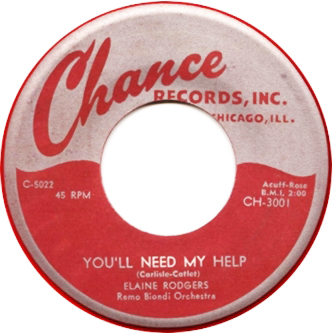
Most Chance recordings were done at Universal Recording Corporation (which was the source of the two main Chance master series: one starting in the U1800s and obviously shared with other labels; the other an exclusive series that began at U5000 or C5000, prefix not handled consistently). Some recordings were picked up from other sources and some were recorded at other studios in town. We know, for example, that the first Homesick James Williamson session was recorded at RCA Studios.
Our basic source for this work is a roughly chronological list of matrix numbers, artists, and titles provided by Art Sheridan to the French discographical researcher, Marcel Chauvard (1926-1968). We have thoroughly checked and considerably amplified his listing, but without M. Chauvard's work our discography would not have been possible. As often happens when working from company files, Sheridan sometimes supplied titles that were not used on the labels. When there is a disagreement, Sheridan's title appears in square brackets after the title that ended up being used. Occasionally Sheridan's matrix numbers disagreed with those that appeared on the labels; such numbers are also shown in brackets.
The Chance label officially opened for business in September 1950. Its headquarters were initially in the offices of Sheridan's American Record Distributors, located at 2011 South Michigan Avenue in Chicago. Art Sheridan had started American Record Distributors in December 1949, along with Evelyn Aron, who sold her share in Aristocrat to Leonard and Phil Chess (Cash Box, December 17, 1949, p. 16). Sheridan also operated a pressing plant called Armour Plastics. In March 1950, his pressing operation expanded by absorbing the remnants of Egmont Sonderling's Master Records (see our Old Swing-Master page). In July, Sheridan acquired the plating plant from Sonderling's mastering operation (Billboard, July 8, 1950, p. 19). Sonderling was shifting his holdings out of the record business and into radio stations.
The first Chance label (on 78s) was black, with a silver rim and silver print. This was plain-looking, but serviceable, and Sheridan kept it until November 1952 (through Chance 1121). When Chance 45s eventually hit the market—the company was in no big hurry—they used a plain blue background and silver print. Because Chance made a late move to 45 rpm, nearly all of the company's 45s would appear with later label designs.
The company initially kept an extremely low profile. So low, we're inclined to wonder what was going on. In its first year and a half in business (September 1950 to the beginning of March 1952), Chance Records was mentioned all of four times in Billboard—and once in Cash Box. Art Sheridan had been in the business for a little while by then, and his initial partner in distribution, Evelyn Aron, had gotten a lot of ink out of both trades while she ran Aristocrat.
In any event, on December 16, 1950, Billboard announced that "Steve Chandler, local realty agent, has started Chance label. First r. and b. releases are by John (Schoolboy) Porter, tenor saxman, and his trio" (p. 16). (The very next item, not so coincidentally, was about Patti Page getting hastily re-booked into the Chicago Theater.) This was the only trade magazine notice Chance would get in 1950. It came three months after the company had opened, when it already had four releases out, one of them a cover of Patti Page's new hit. No ads. No records submitted for review. No mention of Art Sheridan. Who was Steve Chandler?
Chance's very first session had featured one Arnold Jones, who to judge from the titles he cut was a ballad singer. We can say no more, as Jones' solitary release on Chance 1100 is amazingly scarce and in 22 years at RSRF we have yet to hear it. Sales were evidently not militating for the release of the other two sides that Jones had recorded.
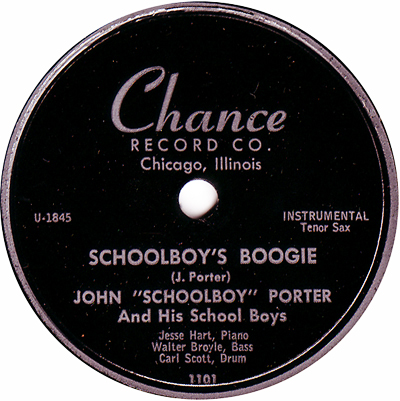
What really got the label started was its second session, consisting of four instrumentals by tenor saxophonist Schoolboy Porter. John A. Porter was a 24-year old native of Gary, Indiana, who had served for 2 1/2 years in the Navy during World War II. In the summer of 1947 he joined the Cootie Williams Band in Indianapolis and toured the Eastern states. Service with Williams helped him develop into a formidable honker (unfortunately, Porter didn't stay long enough to get onto a recording session, so we can't line his solos up against the work of "Weasel" Parker and "Gator Tail" Jackson). In 1948, he enrolled in the Midwestern College of Music, where he stayed for a year. After gigging around with some other bands in the Midwest, Porter was brought to the label by Gary deejay Jesse Coopwood.
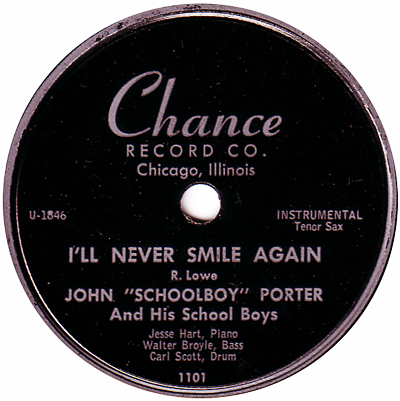
Schoolboy's first Chance release, an instrumental of the Tommy Dorsey / Frank Sinatra song, "I'll Never Smile Again," was something of a local hit in the fall of 1950. It was backed with "Schoolboy's Boogie," a number not in need of further explanation. Porter was backed by a rhythm section, consisting of Jesse Hart's rather florid piano, Walter Broyle's bass, and Carl Scott's drums. Studio reverb was laid on during his solos—more heavily on the ballads, as was the custom at the time. "Kayron" was a driving bop number on which Schoolboy showed off his jazz chops; "Deep Purple" was an affecting ballad performance.
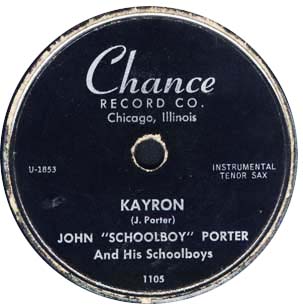
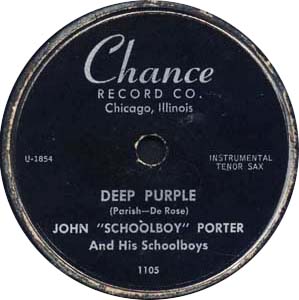
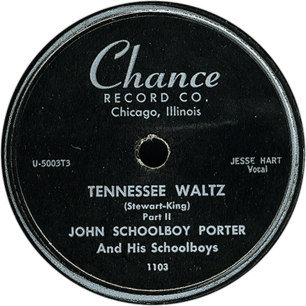
On November 15, Chance brought the same combo back to whip out a two-sided release of "Tennessee Waltz." Periodically a song would send the entire recording industry into a gold rush; "Tennessee Waltz" was the latest. The song has already been a Country and Western hit for Pee Wee King, who wrote the music to it, recorded it for RCA Victor in December 1947, and got it release in January 1948; then for Cowboy Copas, whose single on King was released in March 1948. More than 2 years later Erskine Hawkins' band, with Ace Harris singing the lyrics, cut an R&B version (Coral 60313 was listed as a new release in Billboard on October 14, 1950, p. 44). In turn, pop singer Patti Page, then in her third year with Mercury, was in the studio in mid-October to make a rush version of Mabel Scott's "Boogie Woogie Santa Claus" for the Christmas trade. Needing a B side even quicker, Page's manager and Mercury's East Coast A&R man noticed the Erskine Hawkins release. Mercury 5534 was rocketed into release at the beginning of November, becoming a monster hit on the strength of its B side. Mercury's advertising campaign was so hasty that the first display ad for the single give the wrong catalogue number. Patti Page's "Waltz" was #1 in the charts well past the New Year, selling well over a million copies. In January 1951, the no longer seasonal "Boogie Woogie Santa Claus" had to be replaced. On subsequent pressings of Mercury 5534, the B side was a brand-new recording of "Long Long Ago."
Lots more renditions of "Tennessee Waltz" would given priority recording, mastering, pressing, and distribution over the next few weeks. Some of the cover singles sold in the hundreds of thousands. Without a network that extended beyond American Record Distributors, Chance would have to be content with local sales. Still, Porter's "Tennessee Waltz" sold some 10,000 copies; Armour Plastics couldn't press that many in time, so part of the work was entrusted to RCA Victor's custom pressing operation in Chicago (such copies bear an extra matrix number on each side in RCA's E0 series). Said Sheridan, "That was the era when the saxophone solos and the saxophone copies of popular tunes were very popular. Patti Page had a big hit with 'Tennessee Waltz,' and it was just a normal thing to put out an instrumental on a pop hit as soon as you heard one that seemed to be going somewhere." Sheridan hedged his bet by including a square vocal by Schoolboy's pianist Jesse Hart on the B side.
Claude McLin, who'd scored a hit for Chess in August-September 1950 with his sax solo version of "Mona Lisa," also cut "Tennessee Waltz." But even though Chess had a lot better distribution than Chance at this stage in the game, Porter's version trounced McLin's at the cash register.
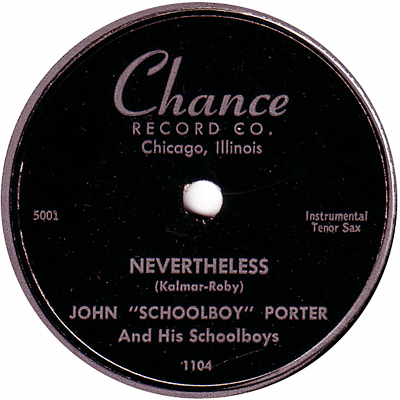
Three more sides were cut at the session. "Nevertheless" is a well-done ballad, and "Walk Heavy" got its name because Schoolboy played baritone sax on it; judging from this outing on the big horn, he could have given Leo Parker a run for his money. In all, Porter would be responsible for 4 of the 6 initial releases on the label: Chance 1101, 1103, 1104, and 1105.
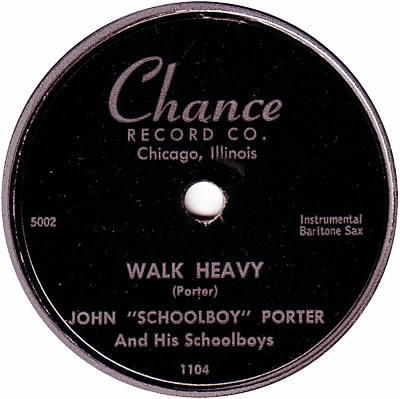
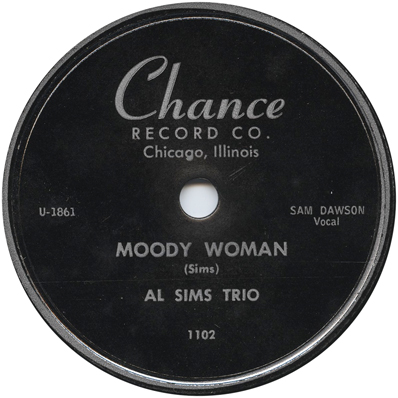
Between the first and second Schoolboy Porter sessions, the company recorded two sides on the Al Sims Trio. Released on Chance 1102, both were uptown blues featuring an excellent vocalist named Sam Dawson. "I Wonder, Baby," a proto-rock-and-roll number, also features a two-chorus guitar solo. Sam Dawson was a guitarist, and presumably did the honors himself; did he leave any other recordings behind? "Moody Woman" is in the Charles Brown vein. Good as the results sound to us today, the sales must have been disappointing, because Sheridan (or was that Chandler?) didn't call Sims and company back.
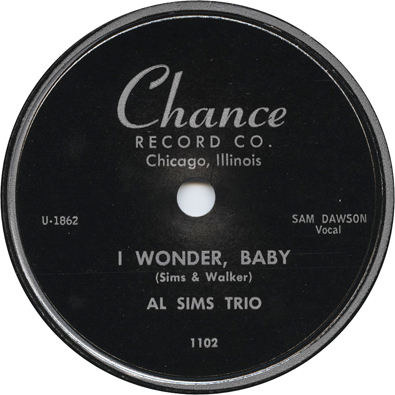
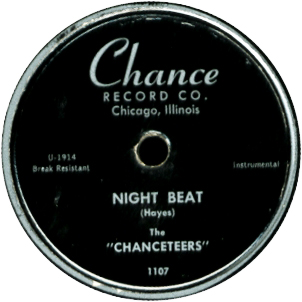
The remainder of the label's early recording activity consisted of a coupld of big sessions featuring singer Clyde Wright and a jazz group (usually a quintet) led by Wally Hayes. Sheridan (or was that "Chandler"?) referred to the group by several names. On Chance 1106 and the first pressing of Chance 1107, the group was credited as the Wally Hayes Combo. (Our thanks to Richard Reicheg for alerting us to the Hayes variant of 1107.) Chance 1106 by Clyde Wright and the Wally Hayes Combo eluded discographical attention for 60 years; obviously it was pressed just once. On Meteor 100, a release nearly as rare, the group became the Calumet City Boys. Marcel Chauvard took down a "Copwood Session," a reference to the Gary deejay, Jesse Coopwood, who may have produced it. Going by the titles (because several of the items have never been released), we think the "Coopwood" items were mostly instrumentals by one of Wally Hayes' groups.
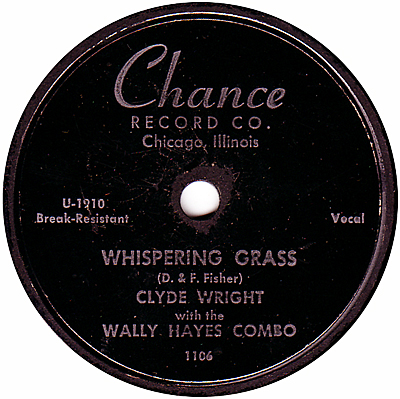
In April 1952, as the Chance label was being resurrected, Chance 1107 reappeared, first on 78 rpm (where it is much more common than the first pressing) and after a while on 45. The same titles, with "Hayes" still given as the composer on both sides, were now credited to "The Chanceteers." Publicity during the next three months claimed a major spot on the company's talent roster for The Chanceteers. But only the retreaded Chance 1107 and one side of Chance 1112 (released in March 1952, after already appearing on Meteor 100) were the only ones to use the name for the Wally Hayes Combo. To maximize confusion (and differentiate the records from those that been made with non-Union musicians), Schoolboy Porter's June 1951 group was called the Chanceteers on Chance 1111, probably released in October 1951, and on the side of Chance 1112 on which the group accompanied Clyde Wright.
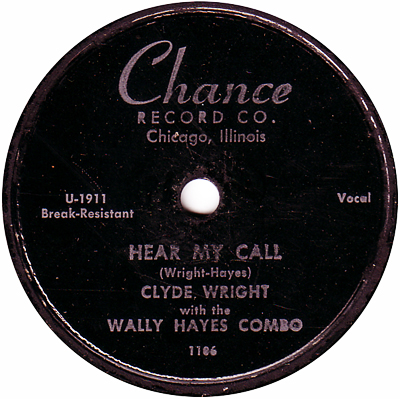
We wish we could say more about the Wally Hayes Combo, a solid group that may also have included some who weren't paid up with the Union. Wallace Hayes was a drummer who had been active in the South Side clubs since 1945 or 1946, and would continue on the Musicians Union Local 208 contract lists through 1955. In 1946, he had William Huddleston (the future Yusef Lateef) playing tenor saxophone in his group, but there is a sore lack of information about the other musicians who worked with him. The combo he led for these studio dates included an excellent alto saxophonist, who is prominent on both sides of Chance 1106, 1107, and one side of 1112, along with piano, guitar, and bass. It would be nice to be able to name them, but the trail is stone cold. On one issued side (maybe too on some still unissued), trumpet and tenor sax were added.
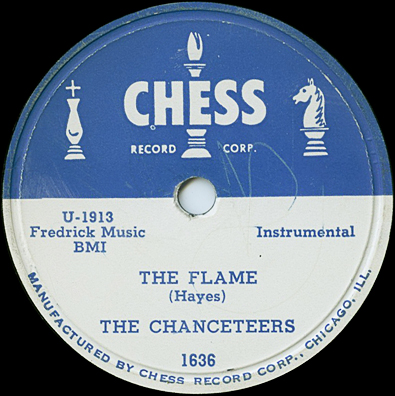
Why it was singled out for such an honor we don't know, but Chance 1107 was reissued in 1956 as Chess 1636, under the Chanceteers name. We have no evidence of further Chance material being picked up by the Chess brothers—in this transaction or in any other.
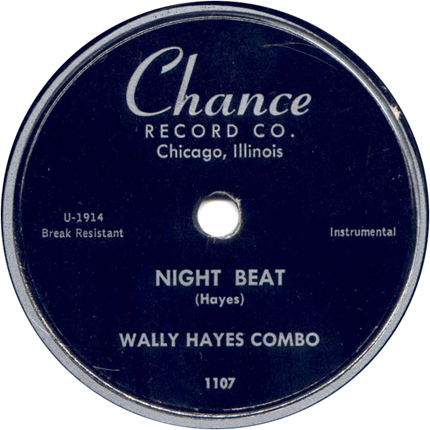
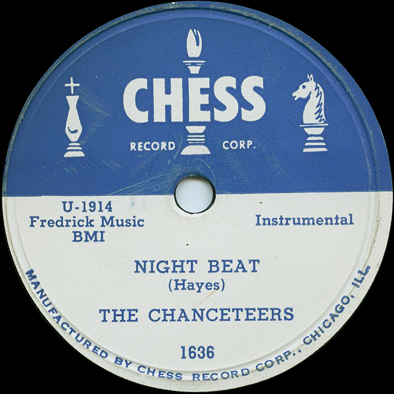
The matrix number on "I'm Nobody's Trick," a blues sung by Clyde Wright, brings up more questions. Sheridan wrote down 2016, which was the number on Meteor 100. But Chance 1112, the March 1952 release that coupled the number with a side on which Wright sang with Schoolboy Porter's band in July 1951, shows U2105 on the label. (It's still 2016 in the trailoff...) Chance 1112 was one of the first products of Sheridan's revival, garnering a review in Cash Box on March 22, 1952 (p. 22).
Yet on "Trick" Wright is obviously backed by the same band that can be heard on Chance 1106 and 1107, and we've listed the side with the other Wally Hayes items. We suspect the "Nobody's Trick" matrix number was purposely altered for Chance 1112. If the renumbering helped to erase the recording trail, so much the better...

Meteor 100 is a 78 that was rediscovered by Bob Buchholz. It has a silver on blue Meteor label. There is no connection with the silver on red Meteor label operated by Lester Bihari (which, just to confuse matters, would license some Al Smith sides from Chance in 1953). This Meteor label is laid out just like an early Chance label (silver rim, same type face in the logo) except it's blue instead of black. "I'm Nobody's Trick" carries 2016. The other side, "Club 21," carries matrix 2017 and was never issued on Chance. Both sides of the Meteor are credited to the Calumet City Boys (abbreviated as "Cal City Boys" in the list Sheridan gave to Chauvard). Neither Meteor 100 nor Chance 1112 has composer credits at all.
"Club 21" throws in a reference to State Street but the main function of this Swing number is to talk up the strip joints of … Calumet City. A couple of further oddities: the vocalist is not Clyde Wright, and the alto saxophonist is joined up front by an excellent trumpet player with bop tendencies and a tenorist out of the Lester Young school. We wonder who the tenor player was, as the possibilities were fairly finite on the Chicago scene at the time. The horns and the bass all get to solo.
The much better known Lester Bihari Meteor label out of Memphis (which would be carried by Sheridan Distributors in Chicago) was launched in November 1952, and its first releases were advertised in the trades in December. By then Sheridan had long since decided to drop his own Meteor logo, after one release. The release date on Meteor 100 remains uncertain but obviously it was before Chance 1112 came out. Our best guess is the second half of 1951.
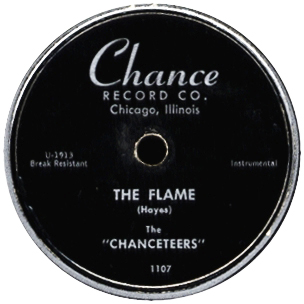
Chance was just starting: the company's total output for 1950 was 25 tracks. For whatever reason, the company was said to be Steve Chandler's, not Art Sheridan's, and coverage in the trades was limited to one delayed announcement, in Billboard, that the company had opened.
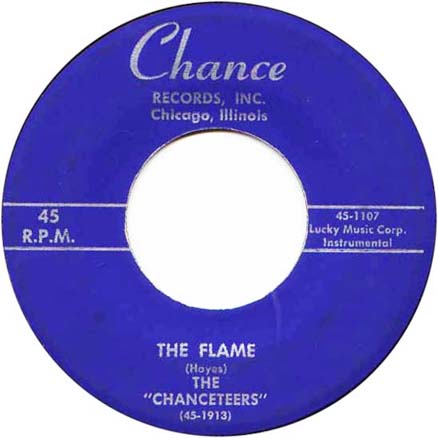
| Matrix | Artist | Title | Release Number | Recording Date | Release Date |
| *U1823 | Arnold Jones | Some Time | Chance 1100 | prob. August 1950 | prob. September 1950 |
| *U1823 [sic] | Arnold Jones | Wilderness | unissued | prob. August 1950 | |
| *U1824 | Arnold Jones | Yesterdays | Chance 1100 | prob. August 1950 | prob. September 1950 |
| *U1824 [sic] | Arnold Jones | Dark Eyes | unissued | prob. August 1950 | |
| *U-1845 | John "Schoolboy" Porter and His School Boys | Jesse Hart, Piano | Walter Broyle, Bass | Carl Scott, Drums | Schoolboy's Boogie | Chance 1101 | prob. September 1950 | September 1950 |
| *U-1846 | John "Schoolboy" Porter and His School Boys | Jesse Hart, Piano | Walter Broyle, Bass | Carl Scott, Drums | I'll Never Smile Again | Chance 1101 | prob. September 1950 | September 1950 |
| *U-1853 | John "Schoolboy" Porter and His Schoolboys [some copies: John Porter, His Tenor Sax and His Orchestra] |
Kayron | Chance 1105 | prob. September 1950 | March 1951? |
| *U-1854 | John "Schoolboy" Porter and His Schoolboys [some copies: John Porter, His Tenor Sax and His Orchestra] |
Deep Purple | Chance 1105 | prob. September 1950 | March 1951? |
| *U-1861 | Al Sims Trio | Sam Dawson Vocal | Moody Woman | Chance 1102 | October 1950 | late 1950 |
| *U-1862 | Al Sims Trio | Sam Dawson Vocal | I Wonder, Baby | Chance 1102 | October 1950 | late 1950 |
| *U5000 | John Porter | High Tide | unissued | November 15, 1950 | |
| *5001 | John "Schoolboy" Porter and His Schoolboys | Nevertheless | Chance 1104 | November 15, 1950 | December 1950 |
| *5002 | John "Schoolboy" Porter and His Schoolboys | Walk Heavy [Wig Deal] |
Chance 1104 | November 15, 1950 | December 1950 |
| U1855 *U5003T3 (T5 on label) E0-0B-13019-1 A A (in wax on some copies) |
John Schoolboy Porter and His Schoolboys | Tennessee Waltz Part I | Chance 1103 | November 15, 1950 | November 1950 |
| U1856 *U5003T5 (T3 on label) E0-0B-13020-1 A (in wax on some copies) |
John Schoolboy Porter and His Schoolboys (Jesse Hart Vocal) | Tennessee Waltz Part II | Chance 1103 | November 15, 1950 | November 1950 |
| U-1910 [*No Number] |
Clyde Wright with the Wally Hayes Combo | Whispering Grass [Green Grass] |
Chance 1106 | December 1950 | Early 1951 |
| U-1911 [*No Number] |
Clyde Wright with the Wally Hayes Combo | Hear My Call [No It Wasn't Right] |
Chance 1106 | December 1950 | Early 1951 |
| *U1913 | Wally Hayes Combo The Chanceteers |
The Flame [The Heat] |
Chance 1107 | December 1950 | Early 1951 April 1952 |
| *U1914 | Wally Hayes Combo The Chanceteers |
Night Beat | Chance 1107 | December 1950 | Early 1951 April 1952 |
| *No Number | [Jesse] Coopwood Session | Man of Parting | unissued | Dec. 1950 | |
| *No Number | Coopwood Session | Red Sails in the Sunset | unissued | Dec. 1950 | |
| *No Number | Coopwood Session | The City... | unissued | Dec. 1950 | |
| *U2016 U2105 on label |
Calumet City Boys Clyde Wright and The Chanceteers |
I'm Nobody's Trick | Meteor 100 Chance 1112 |
c. December 1950 | 1951? March 1952 |
| *U2017 | Calumet City Boys | Club 21 | Meteor 100 | c. December 1950 | 1951? |
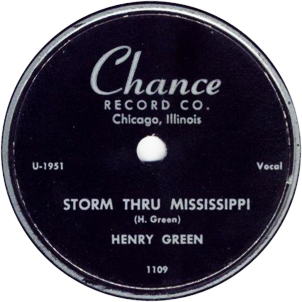
Chance sputtered and almost went out in 1951. The company did record some titles during June and July on blues man Henry Green, plus more by Schoolboy Porter and Clyde Wright, but its total studio output came to a meager 11 sides.
After its peculiar, delayed announcement in Billboard, the company held off sending in singles for review until March 1951. Chance 1101, 1103, and 1105 were announced as new releases on March 10, 1951 (pp. 26-27). Except for Chance 1105, where we have no confirmation of an earlier date, these were obviously not new releases, and Billboard didn't review them. What followed in Billboard wasn't exactly favorable.
The company got into serious trouble in May, when the American Federation of Musicians, at the behest of its Chicago Local 208, revoked Chance's recording license for using non-union musicians on Schoolboy Porter's first session, the one that produced "I'll Never Smile Again." No union contracts for these sides were ever turned in to the AFM office. Billboard ("Petrillo Nixes Art Sheridan's Disking License," May 19, 1951, p. 13; the story was dated May 12) related that Sheridan "had okayed the use of his franchise by Steve Chandler, who cut the disks and had them pressed by Sheridan's Armour Plastics pressery." According to Sheridan "Chandler claimed that he used boys who had union cards, but who, at the time of the sessions, were not paid up members. As a result, he held back the contracts and the union took action."
The magazine reported that the revocation of the license was the "first such action locally in a long time." This we have no trouble believing. Some of the other record companies we have covered at RSRF were called in front of Local 208: Chess for recording in the back room at 4750 South Cottage Grove, Parrot/Blue Lake for recording two-tune sessions, United for using one musician on a session who wasn't current with his Union local. None of the others was ever hit with such sanctions.
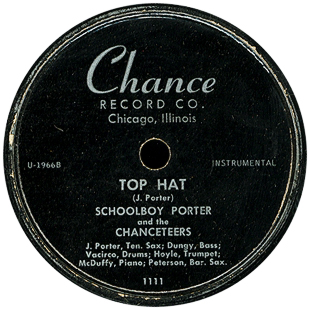
When Robert Pruter talked to him in 1992, Sheridan amazingly said he had no recollection of a person named Steve Chandler or recalled any AFM problems. Said he, "It could have happened, but I don't recall having a difficult time with the AFM." Sheridan has said about operating the company, from management to producing, "I did it all in the beginning." Billboard, which mentioned Chandler in December 1950 and again on this occasion, gave no indication of actually talking to him—perhaps because he didn't exist. Besides which, Sheridan had taken out the recording license for Chance. Why would he start a new record company to turn over to another operator?
What if Art Sheridan realized in December 1950, by which time Schoolboy Porter had made two sessions with cats who weren't straight with the Union, that the local sales on Chance 1103 were making his company visible enough to invite attention from a Union local? Hence the delayed announcement using someone else's name? The complaint and the investigation took a while. In the May 19, 1951 article, Sheridan claimed he'd heard nothing till late April, which was when the AFM caught up with him (one wonders how many letters had been addressed to Steve Chandler).
For that matter, we doubt Henry Green was a member of the Union when Sheridan recorded him on June 5, 1951. Judging from what he cut for Chance, he was considered a gospel performer. He could have avoided joining. Only two of Green's sides were released, on Chance 1109, another rare entity today. "Strange Things" sees portents of the apocalypse; "Storm through Mississippi" is about divine wrath being visited on the "mighty, mighty sinful town" of Tupelo. Accompanied only by his electric guitar, Green was roughly halfway stylistically between Blind Willie Johnson and Pops Staples, though not as intense a performer as either. Chance 1109 has gotten decent coverage on YouTube, where a comment from 2014 indicates that he was then living in Illinois, at the age of 99 (see https://www.youtube.com/watch?v=NSNcUKgk6Zg). It would be nice to know more.
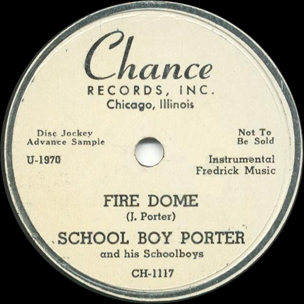
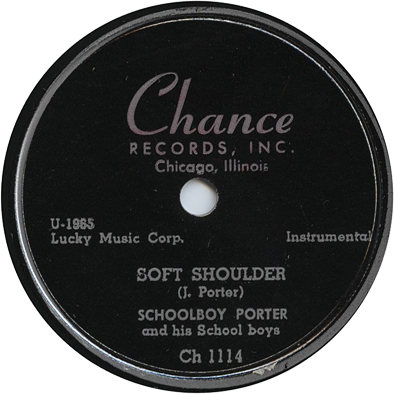
Although the Billboard story made the revocation appear immediate, time was left to get in another Schoolboy Porter session. Porter had been on the road; in April he was working the Ebony Room in Cleveland, in Les Fisher's All Stars. Fisher, a drummer, had put together a quintet with Schoolboy and an alto saxophonist in the front line, plus piano and bass and two vocalists, Aretta LaMarr and "Curley" McClau ("'Cinderella' Band Takes over Cleveland by Storm," Cleveland Call and Post, April 28, 1951, p. 18; the singers got most of the ink, but "Schoolboy Boogie" did rate a mention.)
The studio band for the July 1951 session at Universal consisted of trumpet, baritone sax, piano, bass, and drums. Porter's non-Union rhythm section was not invited back. The label of Chance 1111 provides the names of the new band members.
Art Hoyle (who was also from Gary, Indiana) played trumpet. Arthur Hoyle was born in rural Oklahoma in 1930. He got his first trumpet as a present for his eighth birthday. He moved to Gary with his mother in 1943 and began playing locally when he was 15. He spent 4 years in the Air Force, where met John Gilmore (Gilmore served from 1948 to 1951). An ardent bebopper, Hoyle went on to work in Sun Ra's Arkestra (1955-1956). Hoyle left the Arkestra to tour with Lionel Hampton, spent some time with Lloyd Price, then returned to the Chicago area. For many years, he was active as a musician, appearing on many recording sessions in the 1960s and 1970s. He also did voiceovers for commercials. Art Hoyle died on June 4, 2020, at the age of 90 (see https://www.legacy.com/obituaries/post-tribune/obituary.aspx?n=arthur-hoyle&pid=196306766).
Floyd Dungy, an Indiana native, subsequently played bass on two early sessions for Vee-Jay, with blues singer Pro McClam in September 1953, and with McClam and trumpeter/singer Floyd Valentine in June 1954.
The pianist, Eugene McDuffy, was originally from downstate Illinois. He would be much better known—after he changed his name to Jack McDuff and took up the Hammond B3 organ.
Mr. McDuffy gets nice piano solo on the hard bop blues "Rollin' Along" and a briefer outing on the low-down slow blues "Soft Shoulders," but otherwise the sides are Schoolboy all the way. Singer Clyde Wright, on his second and last session for the label, does his Andrew Tibbs impression on "I May Be Down," which features spirited riffing and a heated solo by the leader.
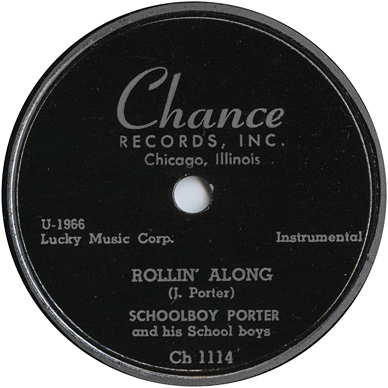

The session data for 1951 confirm that the label didn't record again for 5 or 6 months, and didn't use Union musicians again for 8 months. Apparently the revocation went into effect toward the end of July. Art Sheridan, his phantom frontman "Chandler," and Chance Records would remain on the Union's "unfair practices" list for the rest of the company's history. Sheridan kept his status of persona non grata with Musicians Union Local 208 long after Chance had closed its doors.
Knowing that Chance wouldn't be back until the fall, maybe wouldn't be back at all, Schoolboy Porter joined Lionel Hampton's big band for a spell. In the fall of 1951 he replaced R&B honker Morris Lane, who had gone off to form his own band. This must have been on an emergency basis; according to a 1958 item in the Chicago Defender, Porter had to learn the band's entire book on short notice, with few opportunities for rehearsal.
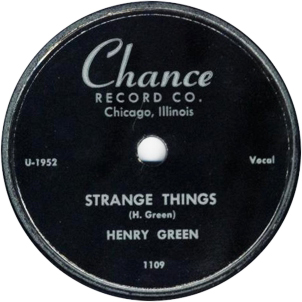
| Matrix | Artist | Title | Release Number | Recording Date | Release Date |
| *U-1951 | Henry Green | Storm thru Mississippi [Storm thru Tupelo] |
Chance 1109 | June 5, 1951 | 1951 |
| *U-1952 | Henry Green | Strange Things [Strange Things Happening] |
Chance 1109 | June 5, 1951 | 1951 |
| *U1953 | Henry Green | Jesus Is Going to Make Up | unissued | June 5, 1951 | |
| *U1954 | Henry Green | No Need to Run | unissued | June 5, 1951 | |
| *U1965 | Schoolboy Porter and his School Boys | Soft Shoulders [School's Blues] |
Chance 1114 | July 25, 1951 | April 1952 |
| *U1966 | Schoolboy Porter and his School Boys | Rollin' Along [Tojo's Boogie] |
Chance 1114 | July 25, 1951 | April 1952 |
| *U-1966B | Schoolboy Porter and the Chanceteers | J. Porter, tenor sax; Dungy, bass; Vacirco, drums; Hoyle, trumpet; McDuffy, piano; Peterson, baritone sax | Top Hat [Question Mark] |
Chance 1111 | July 25, 1951 | October 1951 |
| *U1967 | Schoolboy Porter and the Chanceteers | J. Porter, tenor sax; Dungy, bass; Vacirco, drums; Hoyle, trumpet; McDuffy, piano; Peterson, baritone sax | Stairway to the Stars | Chance 1111 | July 25, 1951 | October 1951 |
| *U-1968 | School Boy Porter and his Schoolboys | Sentimental Journey | Chance 1117 | July 25, 1951 | August 1952 |
| *U1969 | Clyde Wright and The Chanceteers | I May Be Down | Chance 1112 | July 25, 1951 | March 1952 |
| *U-1970 | School Boy Porter and his Schoolboys | Fire Dome [Land of the Misch.] |
Chance 1117 | July 25, 1951 | August 1952 |
It's unclear to us now, but around January 1952, after several months of no recordings, Chance may have slid temporarily into dormancy. Chance finally started getting serious attention from the trades in late February 1952, but the publicity that followed usually made it look like a new company. Maybe it was a new company, from Art Sheridan's point of view; Chandler's ghost was exorcised at last.
In the first four months of 1952, studio activity concentrated on gospel acts—the Heavenly Wonders, Southern Clouds, Golden Tones, and Naomi Baker—for a new 5000 series. We know little about these performers. There was a pragmatic rationale for the change of genre: a record company did not need permission from the Musicians Union to record gospel singers. Not until 1956 would Local 208 begin cracking down on the non-Union keyboard players who often played on gospel sessions, and even then the vocalists were under no obligation to join.
Except that they probably sang unaccompanied, we can say nothing about the Heavenly Wonders, because their sides have never seen release. Hayes and Laughton can only cry "No details."
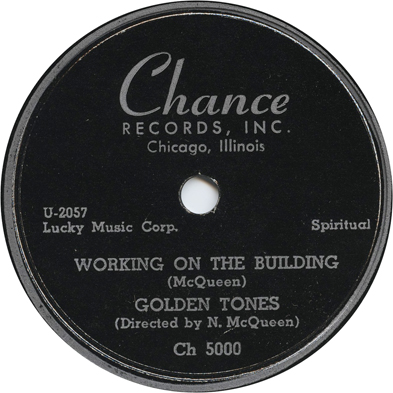
Could the Golden Tones have been the same group that appeared at the Rhumboogie Café (on a bill headlined by Dinah Washington) in April 1946? Almost certainly not—at least 8 different gospel groups that have left traces on record were called the Golden Tones.
According to Hayes and Laughton, this group of Golden Tones, making its first trip to a studio, consisted of Robert Barner, James Trusk, and Robert Fitzpatrick, all singing lead at various times, with accompaniment by Loy Oliver, tenor, Wilbert Webster, baritone, and George Taylor, bass. The group was perfect for a company in trouble with the Union because it performed a capella. Norman McQueen was a DJ, then in his 50s, who had sung in a gospel group when he was younger. He thought he could help the Golden Tones, all much younger, improve their style, which he considered too smooth. He lined up the Chance session and directed the group at the session, also taking a tenor lead on "God Is Love." Despite the strong performances on Chance 5000, the group did not record again for nearly a decade. A later, smaller edition of the group, featuring James Trusk and Loy Oliver, recorded four sides for St. Lawrence in 1965 and a couple more for Halo in 1965 or 1966; these included accompaniment on the organ and a rhythm section.
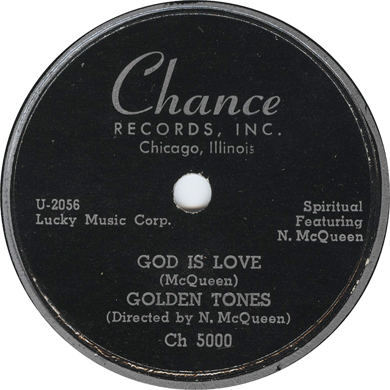
The Southern Clouds were another a capella group. According to Hayes and Laughton, they consisted of Henry McLaughlin, Douglas Price, and Barney Pool, who all sang lead at one time or another, Jonas Bobo, tenor, H. Bankhead, baritone, and J. D. Price, bass. They laid down four sides, probably in January 1952; two were released in June on Chance 5001, which we do hope to hear some day, and two were left unissued, identified on Sheridan's list by fragments of their titles.
Although the Southern Clouds were an entirely different group, they too were under the wing of Norman McQueen, as we learn from the label to "Sit Down Servant." We are indebted to Big Joe Louis for the label copy on this very rare release.
Chance 5001 was reviewed in Cash Box on June 7, 1952 (p. 28), and in Billboard on June 14 (p. 66; the 78 was listed in the same issue on p. 62).
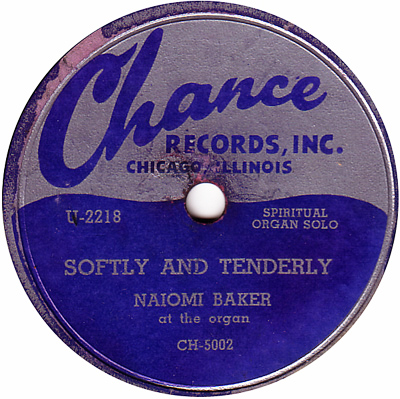
We actually know something of Naomi Baker's doings in Chicago during the early 1950s. She was an organist. We expect she joined the Union because she did not do all of her performing in churches. Indeed, Local 208 posted her "indefinite" contract with radio station WSBC on February 16, 1950. On May 4, 1950 she posted an indefinite contract with the Church of God in Christ; another indefinite contract with the same church posted on February 15, 1951. There is enough evidence of activities in Chicago to dispel a couple of notions: that her February 1952 sides were recorded in Los Angeles, or that she sang on them. The the labels to Chance 5002 and 5006 both read "Spiritual | Organ Solo" and 5003 says "at the Organ." Her name is spelled "Naomi" on the Local 208 contract list (we admit this is a less than infallible source), "Naiomi" on the labels to her first two Chance releases, and "Naomi" on the labels to the third.
At the time, gospel organ instrumentals weren't terribly common. Chance had some hopes for her sides, because the company released all four from her first session. Sheridan waited, however, until he had the green light from the AFM again. Chance 5002 was reviewed in Billboard (Nobember 22, 1952, p. 30); "Love Lifted Me" was described as "bright and lively" and as a "jazzy spiritual item." Cash Box ran its review on the same date (p. 22). Baker occasionally played piano with one hand and organ with the other, as passages from 5002 and 5003 indicate. The company brought Baker back for a second session, but she didn't catch on the way Maceo Woods would soon be doing for Vee-Jay.
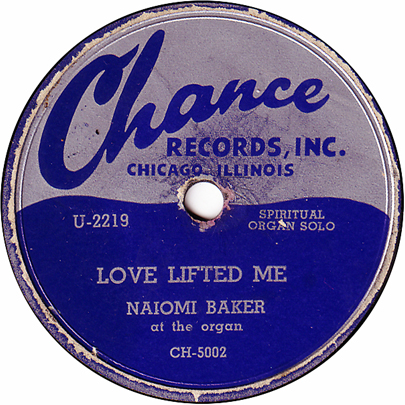
Chance was a 78-only label until the summer of 1952. And like the Chess brothers, Sheridan assumed that 45-rpm jukeboxes wouldn't carry gospel records and that gospel buyers wouldn't own the latest playback equipment. So even after his other series switched over, there would be no 45s in the Chance 5000s.
Although the company had to wait until May for new sessions with Union musicians, it was now actively seeking visibility. In March, it put out Chance 1112, one side of which featured Schoolboy Porter's band (without crediting them on the label). In April, it released Chance 1114, with "Soft Shoulder" and "Rolling Along" from the same session of July 1951 (see the ad and the review in Cash Box, April 19, 1952; Billboard caught up with the record in May, with a listing on May 10, p. 35, and a review on May 17, p. 46).
There was also some kind of pact with Bud Brandom, of Frederick and Brandom Music. Sheridan was dipping a toe into the pop market, which was Brandom's number one interest (and Joe Brown of JOB already had a business connection with Brandom). The only Chance release after 1114 to revert to the old no-publisher procedure was Schoolboy Porter's 1117. Derived from Porter's 1951 session, we figure 1117 was actually planned around the same time as 1112 and 1114. In the end, Chance 1119, fresh from Schoolboy's 1952 session, was pushed to the head of the queue and 1117 allowed to lag a month or two behind it. The production copies of the 78 for 1117 carry no publisher credits on either side. On the DJ copy of the 78 (Sheridan had just started doing DJ copies, a practice he didn't stick with for long), the standard "Sentimental Journey" still has no publisher listed but Porter's "Fire Dome" shows "Fredrick" Music. (If there was a 45 for 1117, we haven't spotted it.) Chance 1120 and 1121 also carried credits to Frederick Music.
At year's end, Sheridan shifted over to Joni Music, which would be the house publisher for the rest of his company's existence.
In March or April 1952, Art Sheridan also snapped up two blues releases from now-defunct Chicago independents. He picked up a single by "Delta Joe" (Sunnyland Slim) and Baby Face Leroy Foster that had been out for a hot minute on Joe Brown's Opera label. Chance 1115 doesn't seem to have sold much, but Sheridan would be making further transactions with Joe Brown.
Sheridan also resuscitated the two sides that Little Walter Jacobs had cut in 1947 for Ora Nelle, with Jimmy Rogers and Othum Brown in the back of a Maxwell Street record shop. A "Little Walter J." single was out in May (reviewed in Cash Box, May 31, 1952). It had been recorded for OraNelle in 1947, and posed no Union issues (at least none that were ne); one side was actually by Othum Brown. Art Sheridan got Chance 1116 into circulation before Little Walter's breakout solo release on Checker 758, though of course he would spring for a a big ad in Cash Box while it was riding high in the charts (November 1, 1952).
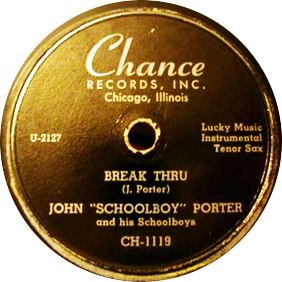
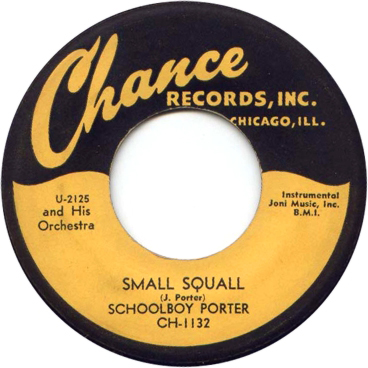
Chance's term of banishment must have been for one year, ending April 30, 1952. Secular recording promptly resumed on May 1, with—what else?—a John "Schoolboy" Porter session. (It turned out to be his last for the label.) On "Junco Partner," "Break Thru," "Small Squall,"and "Lonely Wail," the band consisted of trumpet, baritone sax, organ, bass, and drums. There are solos on "Break Thru" from a fat-toned trumpet player (Art Hoyle again) and bebopping baritonist (Mr. Peterson, whatever his first name was); the organist has a brief solo that suggests Bird and Diz at the roller rink. The organ playing on "Junco Partner" is hipper. This is the same band that Porter recorded with on July 25, 1951, except Eugene McDuffy (still not yet known as Jack McDuff) was playing the organ. His encounter with Jimmy Smith wouldn't come for another three or four years… The final Schoolboy release, Chance 1132, paired two solo vehicles for the leader (with a little help from McDuffy). "Lonely Wail" is a variant on "After Hours," while "Small Squall" paraphrases the old boppers' vehicle, "Cherokee."
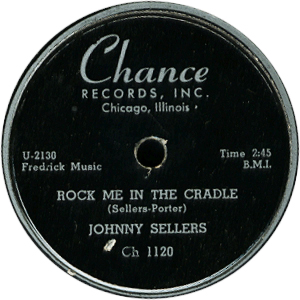
Joining in on the session was vocalist Johnny Sellers. He was the same man who recorded gospel songs (along with some secular material) as Brother John Sellers for Chicago in 1945, and gospel only for Miracle in 1946 and 1948. John Sellers was born May 27, 1924 in Clarksville, Mississippi. While in the South he performed in minstrel shows, but in Chicago by the early 1940s Sellers was singing gospel with Mahalia Jackson. By the time he signed with Chance, he had also recorded blues for the RCA Victor label in 1947 (backed by Willie Dixon), and for King Records in 1951.
Unfortunately for Chance, Schoolboy Porter was getting tired of the uncertain income from performing. With the Korean War still on, there were plenty of job openings in the military. Cash Box mentioned his departure on June 21 ("Rhythm & Blues Ramblings," p. 14), stating that Chance had "lost" him to the Navy. Maybe that was the plan, but Porter ended up in the Air Force. (He might have consulted his bandmate, Art Hoyle.) Schoolboy Porter did just one more studio session that we know of. On August 21, 1952, presumably while on leave, he accompanied Roosevelt Sykes for United—on guitar. If Sykes hadn't called on him by name during a solo, we wouldn't know he was there.
In 1958, Defender writer Al Close caught up with Staff Sergeant John Porter at McGuire Air Force Base, outside of Trenton, New Jersey ("Ex-Hampton Musician Now Air Force Great," December 6, 1958, p. 18). Porter was a member of the 750th Air Force Band. For two years he had also been leading a quintet called the Crew Chiefs; he had also taken up the trombone, which enabled the group to alternate between a tenor sax/trombone and a Jay and Kai front line. According to Close, Porter had participated in the original Air Force "Tops in Blue" show, which toured bases in Korea, Japan, and elsewhere in the Far East.
An Air Force career man with almost 9 years of service (including a 2 1-2 year stint in the Navy) Porter prefers the secure income of the Air Force to the sometimes topsy turvy economy of the civilian world of music and entertainment.
A decade or so later, Porter was stationed at Luke Air Force Base in Arizona (he is identified as a member of the 541st Air Force Marching Band, in a photo taken in 1975: http://www.afmusic.org/images/541st%20AF%20Band%201975-lg.jpg. On his retirement from military service, he settled in Phoenix.
According to Allan Chase, who played with him on one or two occasions between 1978 and 1981, Porter was for a time a member of a band called Pendulum, which was led by drummer Lewis Nash, with Prince Shell on piano and Tom Golden on bass. An item in Billboard (Al Senia, "Hines Next for Arizona Series," October 11, 1980, p. 66) mentioned a free outdoor event on September 14, kicking off the annual jazz series for the Scottsdale Center for the Arts. In front of 3,500 fans, a "freestyle jam session" was mounted by "12 top Phoenix area jazz musicians" including Prince Shell, Charles Lewis, John "Schoolboy" Porter and John Hardy. Of Porter's standing on the Phoenix jazz scene, Chase's assessment was:
Schoolboy was by far the most sophisticated of several good African-American tenor players with military ties around Phoenix […]. Schoolboy could really play changes and had great authority and a big sound. Maybe there were traces of Don Byas, Lucky Thompson, that sort of thing: post-Hawkins with harmonic sophistication, into Gene Ammons and maybe some R&B. (email communication, October 6, 2003)
Guitarist John Ehlis, who enrolled in Mesa Community College in 1983, encountered Schoolboy Porter a little later. According to an online biography of Ehlis (see http://www.jazz.com/encyclopedia/ehlis-john-anthony), "Tenor saxophonist John 'School Boy' Porter is remembered for his colorful personality and getting down to the 'feel' of the tune."
A radio broadcast from KMCR in 1983 was reportedly recorded, with School Porter (too old by then to be a schoolboy), Prince Shell, Curtis Stovall, Tom Goodwin and Ted Goddard, Jr.
School Porter was still performing occasionally in the Phoenix area in 1991, according to the Arizona Republic. He died in 2012.
As part of Sheridan's multi-stage relaunch, he temporarily moved Chance to 2009 South Michigan Avenue, next door to American Record Distributors. Billboard readers were told the company "has been formed" and was releasing sides by Schoolboy Porter, the Chanceteers, and James Williamson. More importantly, "label now has set 15 distributors and, after setting a West Coast rep, will offer national distribution" ("Chance Label New Chi Firm; Disks Released," Billboard, June 14, 1952, p. 70). Chance's annual directory, published on June 28, gave just 5 distributors for Chance, so Sheridan must have ramped up in a hurry. Less than two months later, Sheridan dissolved American Record Distributors, which he had been running since December 1949. American had carried 12 labels at times, but was now down to Chance, Aladdin, and a couple of Aladdin's subsidaries (Cash Box, June 28, p. 70).
Sheridan reorganized the firm as Sheridan Distributors, Inc., with headquarters at 1151 East 47th Street ("Sheridan Changes Firm Name—Moves Quarters," Cash Box, August 2, 1952, p. 26). Chance made the move as well, bringing the distribution arm and the Chance label into closer proximity to the South Side's "record row." An ad in Cash Box (August 2, 1952), showing the new address, announced Chance 1117 (more from the July 1951 Schoolboy Porter session, possibly a release planned earlier and delayed), Chance 1120 (John Sellers), and Chance 1121 (James Williamson); it also reminded everyone that the company was handling JOB 1007 by Eddie Boyd.
Chance 1123 was released on 45 as well as 78, as Chance made sure buyers knew (e.g., the company ad in Cash Box, November 29, 1952). Simultaneous release on 78s and 45s appears to have started with Chance 1122 (recorded in Detroit by John Lee Hooker—for 1122 you should consult our section on Purchased Masters). Around this same time, a couple of older items, such as Chance 1007, were belatedly pressed on 45s.
Sheridan was a late entrant to the format wars, not getting involved with 45s till his June relaunch. This put him months behind the Chess brothers, who had some 45s out before the end of 1951.
Subsequently most Chance (and, when they arrived, Sabre) releases would appear in both formats. But the Chance 5000 gospel series never went to 45s. An occasional later item in another series (such as Chance 3003, Chance 1158, or Chance 3021) never saw release on 45 either.
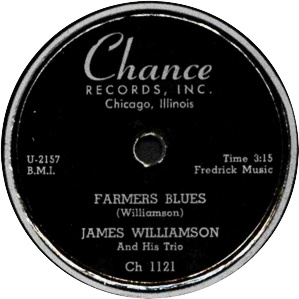
On June 12, the company did its first recordings on a downhome bluesman, the bottleneck guitar player and singer James Williamson, who would become known as "Homesick James." These sides were recorded at the old RCA Victor Studio at 230 South Michigan, and not at the ever reliable Universal, which is why there is a different master number series. (One source of puzzlement: two sides have matrix numbers in the U series—these were applied to material from the first Williamson session later on—but not in the original matrix number series. It is possible that these are retitlings of material that is already listed with matrix numbers in the 100 series.) Joe Brown, who would lease or sell sides to Chance when he lacked the finances to put them out on his JOB label, brought James Williamson to Sheridan.
Williamson was born John William Henderson on May 3, 1914, in Somerville, Tennessee. He played on Beale Street in Memphis during the 1930s. He first moved to Chicago in 1937, recording a little for RCA Victor and playing some local clubs. He returned to Memphis during the war years, but in the early 1950s settled again in Chicago. Williamson played a bit on Maxwell Street, and toured with the Elmore James band. His first session was not a great success musically; there wasn't enough rhythm support to keep him and pianist Lazy Bill Lucas on the same page. Just one single came out on Chance from this session, and Williamson would have to wait till his next, much-improved outing in January 1953 to earn his nickname. The first reasonably comprehensive release from this session had to wait till 1977, when P-Vine Special, licensing them from Sheridan, put out a whole LP of Williamson's Chance tracks in Japan. Williamson later recorded for Prestige, Delmark, Earwig, and lastly Icehouse (in 1997). He died on December 13, 2006, in Springfield, Missouri.
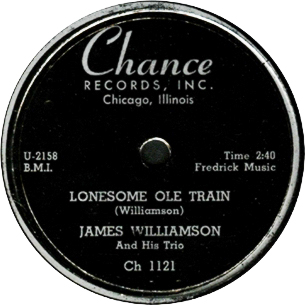
Not long after Chance was officially reactivated, Ewart Abner, Jr. joined the firm. Abner was born the son of a minister in Chicago on May 11, 1923. Related Sheridan, "At the time I met Abner he had graduated from college as an accountant. In those years a black man had a hell of a job trying to get a position as an accountant. He became our accountant in the distributing business and in the record plant, and ultimately for a while ran the pressing plant. After we closed the pressing plant, Abner became very much involved in Chance. In those years Leonard and Phil [Chess] were their own producers and A&R men and I was my own producer and A&R man. Abner was basically the finance man, in the sense of being the accountant guy, bookkeeping and so forth." Eventually, Abner would become the president of Chance, though it was Art Sheridan who talked to the trade papers and signed most of the checks.
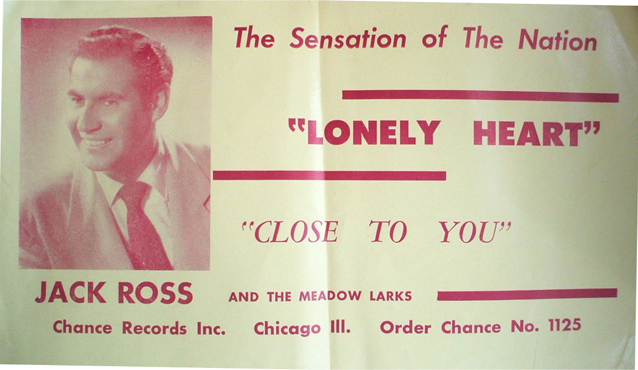
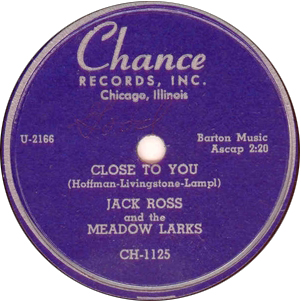
Most likely in August, Sheridan put together a pop session for a singer named Jack Ross. Ross, whose real name was Jack Rosen, was born on July 4, 1923, on a ship in New York Harbor as his parents were immigrating from Europe. He began singing with bands in high school and after graduating toured various small clubs in the Midwest. During World War II, Ross sang for several years with the USO. After the war, he worked for radio stations in Chicago. He was on the staff at WGN and had a show on the ABC network called "Black Night." Around the time of his Chance session, he was doing "The Jack Ross Show" for WIND. During this period, Ross also worked as a model in TV commercials and print ads in Chicago.
A vocal quartet called the Meadowlarks, also active on Chicago radio, were brought in for the session. The next year, they would appear again on the first Buddy DiVito session (see below), and one of the group's members, Elaine Rodgers, would receive a solo outing with Chance. The Meadowlarks, originally 3 male vocalists and one female, came together in Chicago, in 1948 or 1949, to do radio work. Maury Jackson, who had been on WBBM from 1946 through 1948 with Gloria Van and the Vanguards (also known, when a different company was sponsoring the show, as Cinderella and Her Fellas) was one of the original members. He met Elaine Rodgers when she auditioned, and they married not long afterward (see http://articles.chicagotribune.com/2012-03-21/news/ct-met-jackson-obit-20120321_1_jazz-quartet-lombard-popular-jazz). By 1949, the Meadowlarks were appearing regularly on WBBM (scripts with speaking parts for Elaine Rodgers have survived for shows they did on May 26 and June 10, 1949, both with Charlie Agnew's band) and on CBS network radio. Their show, "The Life of the Party," ran Monday through Friday, 3:15 to 3:30 each afternoon. Later they did some work for WGN.
The group got occasional studio work. They appeared on a side by Jerry Murad's Harmonicats (released on 78 as Universal 156, when that label had a deal with London, so the single also appeared on 45 as London 30,002). The London single came out in December 1949, the Universal probably a little earlier. In 1950 (the Chicago Cubs officially adopted the song on June 16), they cut "Come on You Cubs, Play Ball!" for a short-lived Chicago company called North-American, run by former Vitacoustic executive George Tasker. The band was directed by Bernhard "Whitey" Berquist of Geneva, Wisconsin, who had composed the tune in 1937. Berquist did a lot of radio work for NBC, most commonly on the Farm and Home Hour, but he'd conceived the Cubs number with a Swing band in mind, and that's what he led for the date.
The Meadowlarks appeared on one or two of the four legendary sides that Lurlean Hunter made for an obscure label ironically named Major (April 1951); the Majors got reissues on JEB (August 1951), which unfortunately might have been even more obscure. The group also got onto one side of a Ralph Marterie single ("You Better Stop Telling Lies about Me," Mercury 5657, reviewed in Cash Box, June 16, 1951, p. 8).
At some point (the Cubs fight song definitely still featured the original lineup), the Meadowlarks become a quartet of two female and two male singers. We're not sure which edition of the group accompanied Jack Ross, but in 1953 and 1954 the Meadowlarks were Maury Jackson, Marie Renaldo, Elaine Rodgers, and Bob Bleznick. Their movements, when they were not recording, are hard to trace because they had chosen such an obvious name for a "bird group." These Meadowlarks had no connection with, say, Don Julian and the Meadowlarks, who recorded for Dootone in 1955.
One of the composers of "Lonely Heart" was Al Trace, a veteran leader of "sweet" bands and studio orchestras in Chicago (see below for a Chance session that Trace directed). Two sides, out of the four recorded, appeared on Chance 1125 in October 1952. Jack Ross kept the session tapes, including the two unissued sides.
In later years, Ross moved to Florida. He continued to sing at clubs and events well into his 70s. He also made an acting appearance on an episode of "America's Most Wanted." (Our thanks to Darril Wilburn, who provided us with a brief bio of Jack Ross in an email of May 19, 2006; by that time, Ross had retired.)
1125 is a transitional release in a couple of ways: in a few months Sheridan would be opening a separate Chance 3000 series for pop records, and he was experimenting with his label design. What had been a silver on black label was changed for this one release to silver on dark blue. After Chance 1125 the silver on dark blue color scheme would be retained but the graphics would be completely redesigned.
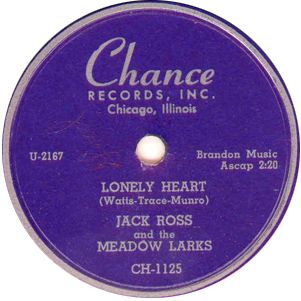
In September 1952, Sheridan got an R&B education at a local radio station. Said he, "Jesse Coopwood was a deejay at WWCA in Gary. I did a stint on his station when he went on vacation, because I wanted to learn what it was like to be a disc jockey. I did three months out there, and it was quite an experience. I learned a lot."
The last quarter of 1952 saw robust recording activity, starting with the eight-side session by Johnny Sellers and a Four Shades of Rhythm session in the early fall. And Chance completed its transition to the now celebrated silver on blue label design (which looks great, and falls easily on the scanner).
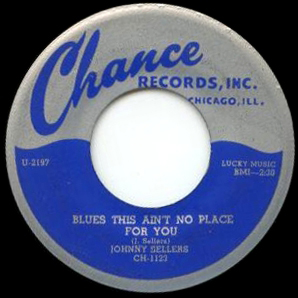
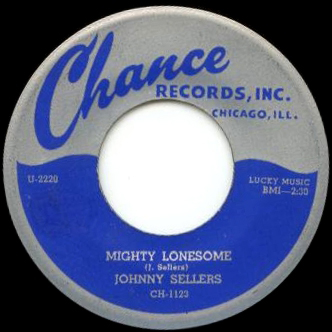
John Sellers' second session was a marathon—eight sides in September, all blues. With Schoolboy Porter away in the military, Sellers was now backed by the band of local trumpet player William Little (1912-1991), who as King Kolax had a 35-year career on the Chicago scene. To a far greater extent than Kolax, who would drop out of the accompaniments if the singer or recording director found him too obtrusive, the star of the band on these outings was smooth tenor saxophonist Dick Davis (1917-1954).
Four sides ended up being released, on Chance 1123 and 1138. Chance 1123, "Mighty Lonesome" b/w "Blues, This Ain't No Place for You," got a big advertising push from the company: ads in Cash Box on November 8, 1952 (p. 9) and November 29 ("Available on 45's as well as on 78's"). It showed up again as one of four Chance and JOB releases in a holiday ad (Cash Box, December 27, 1952).
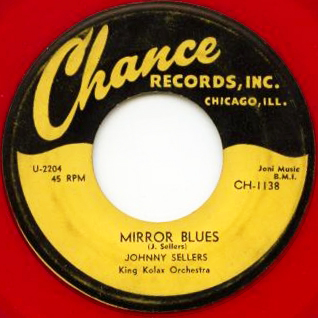
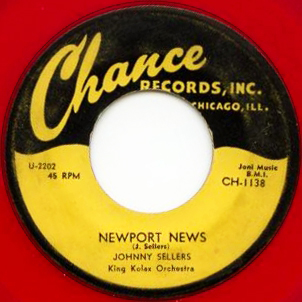
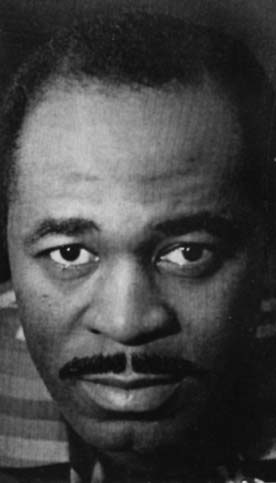
After his Chance sessions, Sellers moved to New York and became involved in the folk club scene. He built a career on a similar model to Big Bill Broonzy, Josh White, and the Reverend Gary Davis, presenting a repertoire that melded folk, blues, and gospel. He made LPs for Vanguard (1954), UK Decca (1957), and Monitor (1959). Sellers died on March 27, 1999, in New York.
The Four Shades of Rhythm were a vocal/instrumental combo that had originated in Cleveland, Ohio, in 1945. The group had been playing in Chicago on and off since 1946 and made their first recordings there for Vitacoustic, in two sessions in December 1947. In March 1949, Old Swing-Master released two sides that had been cut for Vitacoustic and impounded by United Broadcasting Studios when that company went under; the Four Shades had a local hit with the "My Blue Walk" and "Baby I'm Gone." These two tracks are probably the same ones listed here. (Apparently the deal did not include their other sides for Vitacoustic, four of which had appeared on Vitacoustic 1005 and Old Swing-Master 33.)
The Four Shades continued to play and tour, using Chicago as their base of operations. Around the end of 1949, Oscar Pennington was replaced on guitar by Claude Williams. Williams was replaced in his turn by Adam Lambert, formerly of the Cats 'n Jammer Three and the Bill Samuels Trio, when Samuels broke up the trio in 1950. In 1951, bassist Eddie Meyers left the group; he was replaced by veteran bass player Booker Collins, who became available when the Floyd Smith Trio broke up. In 1951, Adam Lambert was replaced for a spell by Emmett Spicer, best known for his prior service in Prince Cooper's trio. Not long after Booker Collins joined the group, the Shades cut no fewer than 16 sides at C. H. Bomgardner's Custom Sound Recordings in Evanston, a suburb north of Chicago (see the Appendix for these). Ranging up to 5 minutes in length, the sides were just semi-professionally recorded and never commercially issued, but they give today's listeners the only comprehensive view of the group's repertoire.
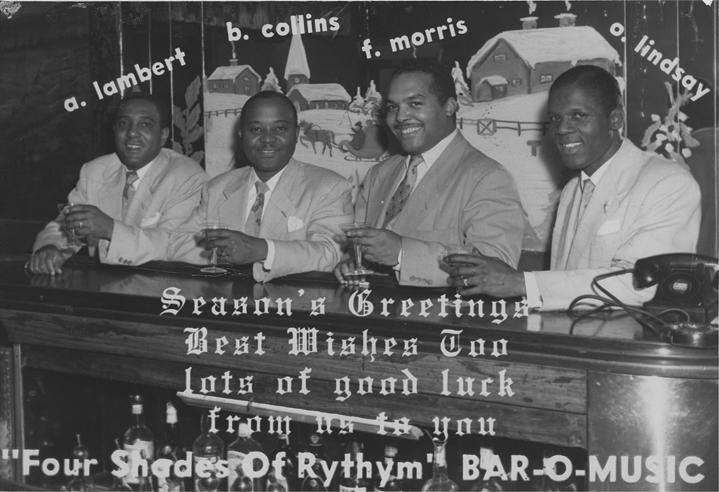
Floyd Morris briefly took over the piano bench after Ed McAfee left the group, and Adam Lambert returned. By the time the Four Shades of Rhythm recorded for Chance the group had changed pianists again. The quartet now consisted of Oscar Lindsay (lead vocals, cocktail drums), Adam Lambert (guitar), Booker Collins (bass), and Ernie Harper (piano). The newest member was a veteran of the Four Blazes who had been playing solo from 1948 through 1951. Lindsay was the only member to have been with the group in Cleveland.
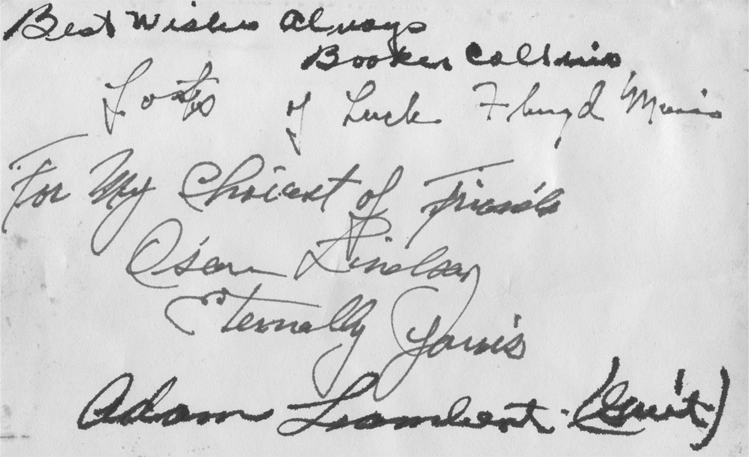
The group recorded a ballad, "Yesterdays" and a jump tune, "So There." for Chance. It appears the unissued side "Everything I Have Is Yours" was acquired from Old Swing-Master. We do not know the original Vitacoustic master number, which came from one of two or three sessions in December 1947. Bernie Besman was partnering with Vitacoustic on its R&B series and he applied his own matrix numbers before dealing 13 sides by the Four Shades to Modern (which never did anything with them). Their single, Chance 1126, was released in November. Whatever it pulled in by way of sales (it is very rare today), the company did not see it as worthy of further promotion. Chance 1126 received a single company ad in Billboard (November 8, 1952, p. 48). A week later, the company ad was for Jo Jo Adams' Chance 1127, and 1126 did not resurface in other company ads that we've seen.
The Four Shades of Rhythm continued to perform after their Chance session. The group's last recording was done for Tommy Jones' Mad label in 1957. A 1960 remake of "A Hundred Years from Today" for Apex was a vehicle for Oscar Lindsay with strings and chorus; it used the Four Shades of Rhythm name, but the group no longer existed.
In October and November, there was extensive session work using the Al Smith orchestra. Al Smith was able to step in because Chance needed a new house ensemble; Schoolboy Porter was going wherever the Air Force sent him.
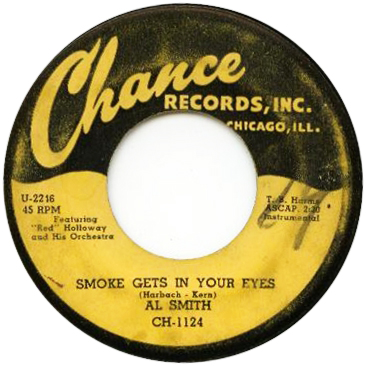
Albert B. Smith was born in rural Bolivar County, Mississippi, on November 23, 1923. After a stint in the Merchant Marine, he arrived in Chicago in 1943. In 1945 he put together what has been called a "bebop" band, but sensing how the commercial winds were blowing, he broke it up in 1952 and founded the R&B unit that can be heard on these sides. Al Smith had no great chops on his chosen instrument; drummer Charles Walton said, "He held the bass... OK, he played the bass—but he didn't tune it first." Many other musicians have slighted his instrumental prowess, while paying tribute to his adeptness at landing gigs and cutting deals. For the kind of money that Smith could pull in, the best musicians in town were eager to work with him.

Al Smith's job was usually to back a vocalist or a vocal group; he didn't get a lot of releases under his own name. But Chance 1124, which was one of four releases featured in a Cash Box ad (December 27, 1952), was under Al's name. It coupled an instrumental ("Slow Mood") with a not-quite-instrumental of "Smoke Gets in Your Eyes" (Bobby Prince added an uncredited falsetto vocalise.
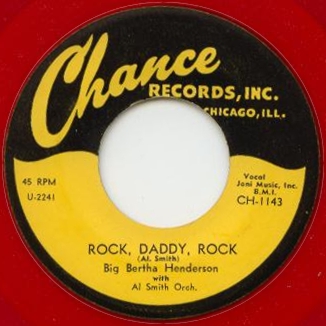
For the session with singer Big Bertha Henderson, whose "house-rockin'" appearances were advertised at Club Evergreen and Martin's Corner in the fall of 1952, Smith brought along two of the best tenor saxophonists in town, James "Red" Holloway (1927-2012) and Oett "Sax" Mallard (1915-1986). His rhythm section was filled out by Billy Wallace on piano, William "Lefty" Bates (1920-2007) on guitar, and Leon Hooper on drums. For the Bobby Prince session, he brought Red and Lefty back, along with Eddie Johnson (1920-2010) on tenor, the indispensable McKinley "Mac" Easton (1914-1986) on baritone sax, and Clarence "Sleepy" Anderson on piano. About Bertha herself, we know hardly a thing. In December 1953, Herman Lubinsky, during a two-week excursion to the South, signed her to Savoy; a release (as Big Bertha) promptly followed (Billboard, December 12, 1953, p. 18). Some correspondence with her that was preserved in the Savoy files gives a home address in New Orleans.
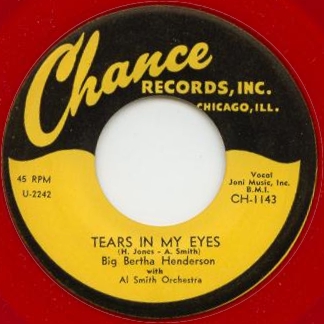
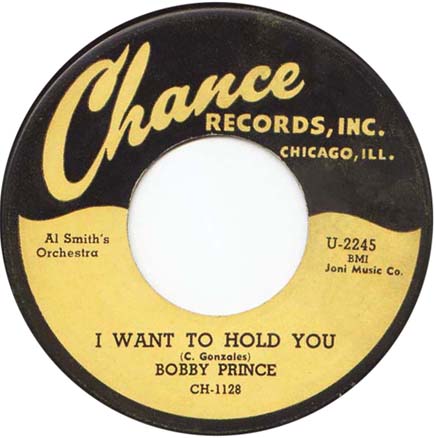
Bobby Prince, whose real name was Charles Gonzales, started in show business around 1948, when he joined the Hot Lips Page band in Cincinnati as a singer. He stayed with Lips for about a year and then went solo. He launched his recording career in 1950, recording some sides for Philadelphia-based Gotham. His most notable recording for Gotham was a rousing jump, the self-penned "Hi-Yo Silver." Gotham 234 was released in June 1950 (it appeared on the list of records received by Billboard on June 24, p. 32). The session was produced in Chicago by J. Mayo Williams, who, for the time being, had wound up his Harlem/Chicago/Southern operations and was taking some time off before starting up a new Ebony operation.
In November 1952, billed at Joe's Deluxe Club (6323 South Parkway) as "golden voice jump-blues vocalist," he was still performing as Charles Gonzales. He apparently entered the recording studio with the Al Smith band as Charles Gonzales and left it as Bobby Prince. Chance 1128, "Tell Me Why Why Why," seemed to garner the singer some acclaim when it was released in January 1953, and Chance pushed the single with some of the largest trade ads in the label's history (for instance, in Cash Box on February 7, 1953). Bobby's unannounced appearance on "Smoke Gets in Your Eyes," which he scats in a spooky falsetto while Eddie Johnson decorates the melody, is also memorable. Chance would make considerable use of Prince's compositional talents, using four of his songs for Flamingos sessions.
Toward the end of the year, Sheridan added the famed gospel group, the Pilgrim Jubilees, to his roster. In fact, they made their first appearance on record for Chance (as the Pilgrim Jubilee Singers). This particular version of the group consisted of Elgie C. B. Graham (lead), Cleave Graham (alternate lead), Clay Graham (tenor), Monroe Hatchett (baritone), Major Roberson (baritone), and Kenny Madden (bass). The Grahams were all brothers. According to Alan Young's book, The Pilgrim Jubilees (Jackson: University Press of Mississippi, 2001), the Pilgrim Jubilees were formed in 1944. The group broke up in the late 1940s, but according to Young it was reconstituted in Chicago in 1952. Young lists the recording date for the Chance sides as January 1953 (noting how their session fits right in between the Bobby Prince and the Lou Blackwell in the matrix series, we have revised that to November or December 1952). Young also says the label mistakenly lists "Just a Closer Walk with Thee" as "Just a Walk with Thee"; we'll take his word for it, but it would be nice to see a copy of Chance 5004. Elgie Graham took the lead on "Happy in the Service of the Lord" and Cleave Graham sang lead on "Just a."
They went on to record (as the "Pilgrim Jubilee," soloist identified somewhat ambiguously as "C. Graham") for the N. B. C. label, which wasn't what you're surely thinking; the initials stood for Northern Brightrecord Corporation. Probably in the second half of 1953, the Pilgrim Jubilee Singers cut "Angel" and "Lord, I Have No Friend Like You" for release on N. B. C. 2003 (Young's book says it was 1954). Arthur Crume was added on guitar. There may have been some business connection between Chance and the twin gospel microlabels, N. B. C. and C. H. Brewer, which shared an address at PO Box 560, Chicago 90 Illinois. Several of the known releases on C. H. Brewer show matrix numbers in the U-3100s. JOB, which was allied with Chance from mid-July 1952 through the middle of October 1953, later released a single by the Norfleet Brothers that carried NBC matrix numbers and also appeared on C. H. Brewer. And the Kelly Brothers' single on C. H. Brewer was recorded in May 1956, amidst actvity for the Abco label of which Joe Brown was co-owner. Bo Sandell, who alerted us to the connection, also notes that the N. B. C. and C. H. Brewer labels look a lot like the labels that Chance used.
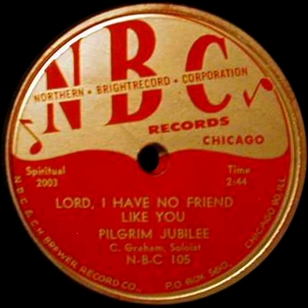
The Pilgrim Jubilees enjoyed a long career thereafter; they went on to record for Specialty (1955), Nashboro (1957-59, 1976-79), Peacock (1959-75), Savoy (1980-84), and finally for the Mississippi-based Malaco (1987-2000). Any of their records for any of these labels will be much easier to find than their one single on Chance.
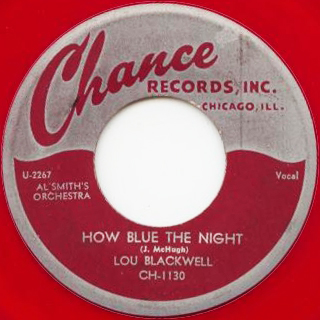
Al Smith also backed lounge singer Lou Blackwell. By this time, Blackwell had a right to feel snake-bit. He had cut a never-issued session for Aristocrat in August 1949; a never-issued session for Chess in May or June of 1951; and two more tracks, unreleased till the 1990s, during Tab Smith's second session for United on October 24, 1951.
On what appears to have been Lou Blackwell's final session, Al Smith put together a larger band, probably consisting of Paul King (trumpet), Red Holloway (now on alto sax), Sax Mallard (tenor), Mac Easton (baritone), Billy Wallace or Clarence "Sleepy" Anderson (piano), and Leon Hooper (drums). Blackwell finally got a record released, Chance 1130.
The impending release got a blurb in Sam Evans' column in Cash Box (November 29, 1952, p. 21). Evans compared Blackwell to Billy Eckstine, but also noted that "Man has about eight sides that have never been released." The single come out on 78 and 45 rpm (blue-label 78; red-label 45, as though Sheridan was anticipating his pop series) in February 1953. It was reviewed in Cash Box on February 28 (p. 22).
The other sides from Lou Blackwell's Chance session shared their fate with everything he had done previously. They are still unreleased today.
We still know little about the Skippy Brown release. The late George Paulus described Brown as an uptown blues singer. The record got a tepid review in Billboard (February 21, 1953, p. 54). For "So Many Days," the comment was "Both the chanting and the material are fairly mundane. Most attractive ingredient is the bop-sounding ork background."
The composer credits to both sides were shared with one "Williams." Brown's only other known recording was done in 1954, for an eccentric 10-inch LP of Christmas songs that came out on J. Mayo Williams' tiny Ebony label. We infer that Brown recorded the single for Mayo Williams, who sold or leased the masters to Chance.
Now that we've been able to hear Chance 1129, we can report that Skippy Brown was a female singer with a rather heavy alto voice who preferred blues. She was accompanied by trumpet, alto sax, two tenor saxes, piano, bass, and drums. "So Many Days" includes a trumpet solo and and, yes, an alto sax solo by someone who knew his Charlie Parker. "Tale of Woe" uses a lot of words, so it has a piano intro consisting of one arpeggio, and no room for solos.
The only newspaper notices we've found for Skippy Brown came from a single run at the Flamingo Room of the Hotel Charles in Decatur, Illinois. She was part of a revue featuring a comedian named Lee Norman (the "Magnificent Idiot") and dancers (the dance lineup turned over about halfway through the run). The revue started in mid-November 1953 and appears to have continued through New Year's. The first ad (The Decatur News, December 4, 1953, p. 20) identified her as a "Popular Recording Artist." As did several ads that followed. Only the very last display ad (The Decatur News, December 19, 1953, p. 9) referred to Skippy Brown's release on Chance. Well, they got it in.
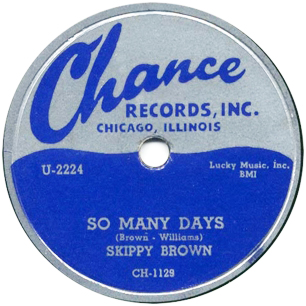
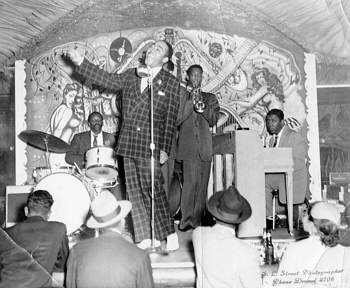
October also saw a session with uptown blues singer and man of many tail coats Jo Jo Adams, backed by the band of bebop trumpeter Melvin Moore, who had previously recorded for Sunbeam and for his own GloTone label. At this time, Adams and Moore were ensconced at the Flame Show Bar (809 East Oakwood), billed as "The Jo Jo Show, starring Dr. Jo Jo Adams, Bennie Pittman, Laura Watson, Melvin Moore's Band." Besides singing his specialties nightly, Adams served as MC at the Flame, telling many dirty jokes.
Jo Jo Adams was born in Alabama, somewhere around 1918, and died in Chicago in 1988. Originally a dancer, he broke in at the Club DeLisa and made his first recordings with Floyd Smith's group for the Hy-Tone label in December 1946. He followed up with 6 sides for Aladdin in 1947, which were recorded in Los Angeles with the Maxwell Davis band, and 6 more for Aristocrat, which were done in Chicago in 1947 and 1948 with Tom Archia's All Stars. Though he enjoyed a run of several years at the Flame and would remain on the scene well beyond that, he would record just one more session, for Parrot in 1953.
Chance 1127 was advertised in Billboard on November 15, 1952 (p. 62) and reviewed in the issue of December 20, 1952 (p. 30). It was one of four Chance and JOB releases advertised in Cash Box on December 27, 1952. Adams was a reliable blues shouter, albeit somewhat stereotypical in his routine, which often featured the same tune with different partly improvised lyrics. These two sides with the band he had been working with every night are his very best, well articulated rhythmically and jumping with vitality. Moore's nimble trumpet contributions are ably assisted by Harold Ousley on tenor sax, Dave Young on baritone (his usual instrument was tenor, and he was probably added just for the studio date), Eddie Baker on piano, Sylvester Hickman on bass, and Earl Phillips on drums. The horns mostly riff, but Harold Ousley, who was making his first appearance on record, adds an intense solo to "I've Got a Crazy Baby."
Most likely Al and company also backed R&B singer "Chubby" Newsom (she was not chubby, her last name was regularly misspelled as "Newsome," and her band was often billed as Chubby and Her Hip Shakers). Thanks to Marv Goldberg's research, available at http://www.uncamarvy.com/ChubbyNewsom/chubbynewsom.html, we know that the singer was born Velma Celestine Williams, on January 27, 1920, in Wilburton, Oklahoma. She was the daughter of Leona Williams and Dan Latham. In January 1937, before she turned 17, Velma Williams married Carl Allen Newsom, Jr., in Oklahoma City. By 1940, Velma Newsom was living in Detroit and separated or divorced from Carl Newsom (she would be married at least three more times). She began getting gigs in Detroit, as Velma Newsom, in 1941. In August 1944, still in Detroit, and on her second marriage, she started going as Chubby Newsom (just why, we don't know). Into 1948, she performed in Detroit, or in Indianapolis, or Buffalo, or Dayton, Ohio. Not long after she arrived in New Orleans, in October 1948, Paul Gayten took in her act and got her signed to DeLuxe, leading to her first recording session, which took place in New Orleans in November 1948. Her first DeLuxe single featured "Hip Shakin' Mama," which became her signature number; it was also released on Miltone under a deal then in force. "Hip Shakin'" was all about her dance moves, not her body type. In 1949, she went on a long tour with Roy Brown, another DeLuxe artist. She got two further singles on the label. But when Dave and Jules Braun left DeLuxe in August 1949 and joined Fred Mendelsohn to form Regal, Chubby Newsom was one of the DeLuxe artists they took with them. Newsom made two sessions in New York for Regal, resulting in three releases before the company folded in October 1951. She also appeared on an airshot, from Birdland with Miles Davis, that was commercially released many years later. From April 1951, a live broadcast with Paul Gayten's band at a New Orleans club was recorded and retained by Fred Mendelsohn; it eventually got a release on a P-Vine Special LP. As with some other Regal artists, the Braun brothers and Mendelsohn made sure that Newsom did not go back to DeLuxe (now completely controlled by Syd Nathan) when Regal closed, but she wasn't picked up by another company. In October 1952, she supposedly signed with RCA Victor, but if she cut anything for Victor, it was never released—and in December she was cutting instead for Chance.
December is our estimate, at least, of when the Newsom session took place. We figure that Al Smith's band was on it, but we haven't heard any of the sides and don't know the personnel. On January 10, 1953, Cash Box (p. 19) noted that Chubby Newsom was working The Orchid Room in Kansas City. The blurb also noted that she was "formerly with RCA Victor, and now out on Chance record." She'd recorded for Chance, all right, but the trades were generally careful not to announce a record as released until it actually had been. Was something planned and then pulled back at the last minute? In fact, the very next item in Cash Box's Chicago coverage declared that "an early package being talked about for spring promotion will include Al Smith and his band, with Chubby Newsome and Charles Gonzales. The latter will hit the record stands under the name of Bobby Prince." The Bobby Prince reference was to Chance 1128, which really was being released. The notice reinforces our surmise that Al Smith's band was on Newsom's four tracks. But, for whatever reason, Chance never released anything by Chubby Newsom.
In June 1953, Newsom teamed with Alberta Adams, whom she knew from years on the Detroit club scene, to form a duo called the Bluzettes. Chess recorded Alberta Adams as a solo artist, but didn't pick up the Bluzettes. The Bluzettes (largely) kept together through March 1955. Chubby Newsom's last record was a single cut around February 1957 for the Winley label. It had a rock and roll sound, courtesy of a band led by David Clowney (soon to be better known as Dave "Baby" Cortez). Her last advertised gig that Marv Goldberg has been able to locate was in Kansas City in 1962. Eventually (around 1980) she moved from Detroit to Kansas City. Velma C. Newsom died at the Shawnee Mission Medical Center in Kansas City, on September 13, 2003. She was 83, and most probably had not sung professionally since she was 42.
As the end of the year approached, Chance picked up a session by Jack Teter, a musician with a long and varied history. He was the only Chance artist who had distinct prewar and postwar recording careers.
John J. Teter was born on January 6, 1902, near Granger, Missouri. His first instrument was the banjo; he got his start playing barn dances in the Ozarks with a blind fiddler. He soon discovered that audiences liked his smooth tenor voice. In 1926, Jack Teter was in Minneapolis/St. Paul, Minnesota, where he appeared on local radio. In 1927, he was working with a band in Superior, Wisconsin. In 1929, he joined Bill Carlsen's Orchestra, a Milwaukee dance band, playing the banjo and singing; he would be based in Milwaukee for the rest of his life. Early in 1930, the Carlsen band recorded in Grafton, Wisconsin, for Paramount. Teter was called back in February 1930, where he cut two tracks with a "hillbilly" trio whose other members were Frank Welling and John McGhee. In April 1930, he cut two pop songs as a solo act; he was now playing guitar. The 1930 sides appeared both on Paramount and its dime-store subsidiary, Broadway. As the company was on its last legs, Teter did two more sessions for Broadway, in March and June 1932, including versions of "Just Friends" and "All of Me."
Teter went to work for WTMJ, the Milwaukee radio station, eventually getting his own 15-minute show called "The Song Doctor"; he also directed talent contests. For instance, the Racine Journal-Times (August 14, 1934) had Jack Teter's Playboys doing a half hour show on WTMJ at 11:30 on Wednesday mornings. From 1934 to 1936 Teter led the Isle of Dreams Orchestra, whose instrumental lineup, from the reports we have, points to the polka-Swing hybrid then prevalent in Wisconsin.
Nearly 17 years after his last trip to the studio, Teter signed with a new small Chicago label called Sharp. Operated by James Martin, a record distributor who in those days catered to white record buyers in the Midwest, Sharp opened for business on May 1, 1949. Sharp's model was to sign artists who Martin knew were in demand from his local experience. So Martin picked up Lee Monti and the Tu-Tones, a group that had been dropped by Aristocrat and then by Universal, but whose records on both labels had moved well for him. Teter, who had not been recording at all, joined Monti in the first cohort of artists that Martin signed (Billboard, April 30, 1949, p. 17).
A few months earlier, Teter and his trio (Bob Prouty, piano, and Bob Eberhardt, bass) had scarcely rated a mention in Billboard. The one sentence they got, noting that they had worked the summer at Devi-Bara's Dude Ranch, by the shores of Devil's Lake near Baraboo, Wisconsin, and were now at Tutz's Cocktail Bar in Milwaukee, appeared in the Burlesque column (December 13, 1948, p. 53). The writer thought that Teter played the accordion...
That all changed when Jack Teter hit it big on the Billboard chart with his first new record, a version of the venerable “Johnson Rag”. The first Sharp releases (S1 through S3) came out in July (S1 and S3 were listed in Billboard on July 23, 1949, p. 32). "Johnson Rag" was initially on Sharp S2 (getting a tepid review in Billboard on August 6, 1949, p. 105), but demand for the record helped Sharp get a deal with the London label. London was new to the United States (it was a subsidiary of British Decca) and on an aggressive quest to expand its market. "Johnson Rag" would enjoy far wider distribution as London 501. Billboard reviewed the London on September 17, 1949 (p. 109), still not expecting much from the "light innocuous style," but by November 26 (p. 26), "Johnson Rag" was number 19 on the pop charts.
To Teter's regular trio (with Prouty doubling on Solovox), the first Sharp session added a drummer. What caught attention, besides the group's unerring fusion of 1920s jazz with Western Swing, was Teter's decision to put vocals to the rag. The flip, "Back of the Yards," was more sentimental. On December 29, 1949, "Johnson Rag" and a second Teter single were included in the very first batch of 45s that London shipped to retailers ("London Joining 45 Parade," Billboard, December 31, 1949, pp. 12, 30). On January 28, 1950, "Johnson Rag" was #12 on the Billboard pop charts (p. 26), and a disk jockey in Milwaukee was boasting how he already knew, back in August 1949, how far it was going to go. In its annual survey of "Top Selling Popular Artists over Retail Counters," Billboard (July 15, 1950, p. 83) put Teter at number 30, between Arthur Godfrey and Ray Bolger. He made this list entirely on the strength of "Johnson Rag." Jack Teter was 47 years old and he finally had a hit record.
Though he wouldn't have any more hits, Teter cut a second session for Sharp in 1949 and at least one further in 1950. The idea was to redo old songs, most often from the 1920s, usually with some jazz content. A different "trio" (now with an excellent, and unfortunately unidentified, clarinetist in place of the drummer) performed numbers like "Kansas City Kitty" (Sharp S-20), "Paddlin' Madelin' Home" (Sharp S-15), and "Stompin' at the Savoy" (Sharp S-37) with a genuine jazz sensibility. In 1951 Teter became part owner of the White Pub, a Milwaukee club that regularly featured his trio alternating with Bob Kames at the organ (Billboard, May 19, 1951, p. 18). When Jimmy Martin hosted a cocktail party in Chicago for singer Teresa Brewer, Teter was deemed important enough to be in attendance, along with Jim Lounsbury and assorted other DJs and juke box operators (Cash Box, March 3, 1951, p. 11).
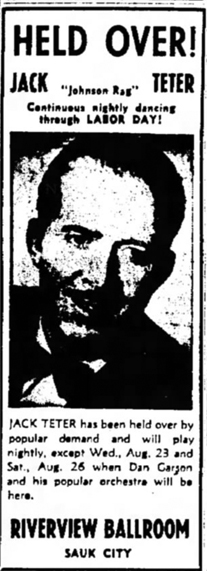
But in April 1951 Teter's contract with Sharp ran out; then at the end of July, Sharp's licensing deal with London expired and Jimmy Martin took Sharp out on its own ("Sharp Records Sets Up National Distribution, Cash Box, August 4, 1951, p. 13). The London-less venture, despite the 14 other distributors Martin had lined up, didn't have a network big or reliable enough. (After a few months, Sharp would sign a new licensing deal with MGM, but it would not lead to more hits. The company lost the MGM deal and folded in 1953.)
As soon as Teter was free, he did a session for a tiny Chicago-based company called Radiant (the tiny successor to a tiny company from Sheboygan, Wisconsin called Disc Jockey, which focused on Country and polka bands in its home state). We don't actually know whether anything from it was released on Radiant, but a single came out in May 1951 on Rondo, a once-prominent indie now in sharp decline. With Sharp still releasing singles from the trio's long sessions in 1949 and 1950, and Rondo only somewhat better able than Radiant to promote its records, Rondo 290 slipped out virtually unnoticed. Meanwhile, Teter took some time off from performing at the pub (Billboard reported, November 17, 1951, p. 49, that he had guitarist Dick Yehl and vocalist Pat Shealy filling in for him with the trio), then hit the road with his trio. Billboard reported on January 26, 1952, p. 44, that they were working in the Dakotas, with some West Coast dates lined up for March.
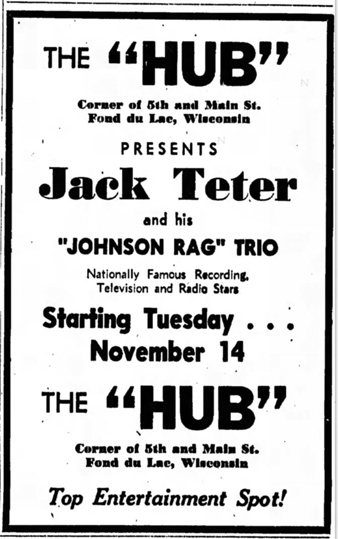
We had thought Teter's Chance session was made for Art Sheridan. But in 1952 Jack Teter was out of Radiant, which had morphed again, into a company again based in Sheboygan and now called Polkaland, with a focus not hard to guess. Teter moved along to the Milwaukee-based Demo label, which was owned by a producer named Angelo Ferlano—note the composer credit on "Going Around in Circles." (Ferlano had wanted to call his company Dubonnet—its first release, by one Johnny Dee, was mentioned in Billboard on May 19, 1951 (p. 18)—but quickly changed it because there was already another indy by that name.) In 1952 and 1953 Teter made three singles for the small company: Demo 1009, 1010, and 1030. Demo did some of its recording in Chicago, but it lacked distribution outside its city of origin. Hence, its first Teter single was licensed to Chance, the second would be licensed to Brunswick, and the third would have been licensed to, well, any bigger company, had Ferlano been able to attract its interest.
On Demo 1009, later issued as Chance 3000, the trio was augmented with a rhythm guitarist (unless Teter overdubbed himself). Teter went with Western Swing on this occasion and featured his excellent lead guitar work. "Going Around in Circles" was a good vehicle for Teter but would have fared better without some corny piano and Solovox from Bob Prouty. (After it had lost its following elsewhere, the Solovox held on in polka bands—Johnnie Bomba released "Solovox Polka" as late as February 1957). On "I'm the Guy," it was the group vocals and the celeste that provided the countervailing sap.
With "In the Mood" appearing on Demo 1010 and Brunswick 80222, there is one matrix number left from this session, whose fate remains unknown to us. The RCA Victor-based matrix numbers indicate that the sides were recorded in 1952, and we suspect Demo got a substantial jump on releasing them; Chance did not put them out till June 1953.
The next month Demo 1010, with another track from the 1952 session and one from a 1953 session, was reissued on Brunswick, a much bigger label hoping for another hit (Billboard reviewed Brunswick 80222 on July 4, 1953, p. 47). The last Demo, 1030, was cut in 1953 and was strictly local. His days as a hit-maker now behind him, Teter kept his following in Milwaukee. In 1954, his trio had a 15-minute show on WTMJ-TV, at 6:15 on Friday evenings (Janesville Daily Gazette, April 8, 1954, p. 10). In 1967 Raynard, a Wisconsin-based company, put out an LP on Jack Teter, consisting of released sides and additional unissued material from the Sharp sessions. Jack Teter died in Milwaukee in December 12, 1987.
For information on Jack Teter, we are indebted to Cary Ginell ("'Get Hep & Get Happy': Milwaukee's Jack Teter," ARSC Journal, 38(2), Fall 2007: 194; email communications, May 8 and 9, 2016) and to Alex van der Tuuk ("Jack Teter: The Isle o' Dreams," ParamountsHome.Org, posted January 23, 2006 (http://paramountshome.org/index.php?option=com_content&view=article&id=80:jack-teter-the-isle-o-dreams&catid=45:new-york-recording-laboratoriesartist&Itemid=54).
When they finally appeared in June 1953, the Teter sides were used to launch the new chance 3000 pop series. The 3000s came equipped with red and silver labels to complement the blue and silver that the 1100s were carrying.
We know of 68 new recordings for Chance in 1952, plus the two it got from Demo. The company was building up steam.
| Matrix | Artist | Title | Release Number | Recording Date | Release Date |
| ? | The Heavenly Wonders | Where Can I Go? | c. January 1952 | ||
| ? | The Heavenly Wonders | Detour | c. January 1952 | ||
| *U-2056 | Golden Tones (Directed by N. McQueen) | Spiritual Featuring N. McQueen | God Is Love | Chance 5000 | prob. January 1952 | April 1952 |
| *U-2057 | Golden Tones (Directed by N. McQueen) | Spiritual Featuring N. McQueen | Working on the Building | Chance 5000 | prob. January 1952 | April 1952 |
| U-2110 *U2112 |
Southern Clouds (Under Direction of N. McQueen) | Sit Down Servant | Chance 5001 | prob. January 1952 | June 1952 |
| *U-2111 | Southern Clouds | Sing to the Power of the Lord | Chance 5001 | prob. January 1952 | June 1952 |
| *No Number | The Southern Clouds | Strolling Along | prob. January 1952 | early 1952 | ? |
| *No Number | The Southern Clouds | These Are... | prob. January 1952 | early 1952 | ? |
| *U-2218 | Naomi Baker at the organ | Softly and Tenderly | Chance 5002 | February 25, 1952 | November 1952 |
| *U-2219 | Naiomi Baker at the organ | Love Lifted Me | Chance 5002 | February 25, 1952 | November 1952 |
| *U-2220 2220-1 in vinyl |
Naiomi Baker at the organ | What a Friend I Have in Jesus | Chance 5003 | February 25, 1952 | late 1952 or early 1953 |
| *U-2221 | Naiomi Baker at the organ | Have You Any Time for Jesus | Chance 5003 | February 25, 1952 | late 1952 or early 1953 |
| *U2098 to U2107 | Unused | Matrix | Numbers | ||
| *U-2125 | Schoolboy Porter and His Orchestra | Small Squall | Chance 1132 | May 1, 1952 | March 1953 |
| *U-2126 | Schoolboy Porter and His Orchestra | Lonely Wail | Chance 1132 | May 1, 1952 | March 1953 |
| *U-2127 | John "Schoolboy" Porter and his Schoolboys | Break Thru | Chance 1119 | May 1, 1952 | June 1952 |
| *U-2128 | John "Schoolboy" Porter and his Schoolboys | Junco Partner | Chance 1119 | May 1, 1952 | June 1952 |
| *U-2129 | Johnny Sellers | Josie Jones | Chance 1120 | May 1, 1952 | August 1952 |
| *U-2130 | Johnny Sellers | Rock Me in the Cradle | Chance 1120 | May 1, 1952 | August 1952 |
| *No Number | T-Bone Walker | See | Purchased | Sessions | |
| 101-1 | James Williamson | Johnnie Mae | unissued | June 12, 1952 [RCA Studios] |
|
| 101-2 (*U2232) | James Williamson | Johnnie Mae | (P-Vine Special [J] PLP-706) | June 12, 1952 [RCA Studios] |
|
| 102-1 (*U-2157) | James Williamson and His Trio | Lonesome Ole Train | Chance 1121 | June 12, 1952 [RCA Studios] |
August 1952 |
| 102-2 | James Williamson Trio | Lonesome Ole Train | (P-Vine Special [J] PLP-706) | June 12, 1952 [RCA Studios] |
|
| 103 (*U-2158) | James Williamson and His Trio | Farmers Blues | Chance 1121 | June 12, 1952 [RCA Studios] |
August 1952 |
| 104 | James Williamson Trio | Farmer's Blues | unissued | June 12, 1952 [RCA Studios] |
|
| 106 | James Williamson Trio | Farmer's Blues | unissued | June 12, 1952 [RCA Studios] |
|
| *U2234 | James Williamson Trio | Little Women | unissued? | June 12, 1952 [RCA Studios] |
|
| *U2235 | James Williamson Trio | Come Back to Me | unissued? | June 12, 1952 [RCA Studios] |
|
| 107 | James Williamson Trio | Whiskey Headed Woman | (P-Vine [J] PLP-706, Charly CDGR 146) | June 12, 1952 [RCA Studios] |
|
| 108 | James Williamson Trio | Williamson Boogie | unissued | June 12, 1952 [RCA Studios] |
|
| 109 | James Williamson Trio | Williamson Boogie | unissued | June 12, 1952 [RCA Studios] |
|
| 110 | James Williamson Trio | Williamson Boogie | (P-Vine Special [J] PLP-706) | June 12, 1952 [RCA Studios] |
|
| *No Number | Jack Ross | Home Girl | unissued | c. August 1952 | |
| U-2166 [*No Number] | Jack Ross and the Meadow Larks | Close to You | Chance 1125 | c. August 1952 | October 1952 |
| U-2167 [*No Number] | Jack Ross and the Meadow Larks | Lonely Heart | Chance 1125 | c. August 1952 | October 1952 |
| *No Number | Jack Ross | There You Go | unissued | c. August 1952 | |
| *U-2197 | Johnny Sellers | Blues This Ain't No Place for You | Chance 1123 | September 1952 | November 1952 |
| *U2198 | Johnny Sellers | Too Many Heartaches | unissued | September 1952 | |
| *U2199 | Johnny Sellers | The Jay Bird Story | unissued | September 1952 | |
| *U-2200 [U-2220 on label] |
Johnny Sellers | Mighty Lonesome | Chance 1123 | September 1952 | November 1952 |
| *U2201 | Johnny Sellers | Christmas Time Blues | unissued | September 1952 | |
| U-2202 [U2204 on list] |
Johnny Sellers | King Kolax Orchestra | Newport News | Chance 1138 | September 1952 | June 1953 |
| *U2203 | Johnny Sellers | The World | unissued | September 1952 | |
| U-2204 [U2202 on list] |
Johnny Sellers | King Kolax Orchestra | Mirror Blues | Chance 1138 | September 1952 | June 1953 |
| U-2224 | Skippy Brown | So Many Days | Chance 1129 | c. September 1952 | February 1953 |
| U-2225 | Skippy Brown | Tale of Woe | Chance 1129 | c. September 1952 | February 1953 |
| *U2228 | Four Shades of Rhythm | Yesterdays | Chance 1126 | September or October 1952 | November 1952 |
| *U2229 | Four Shades of Rhythm | So There | Chance 1126 | September or October 1952 | November 1952 |
| *U-2241 | Bertha Henderson with Al Smith Orch. | Rock, Daddy, Rock | Chance 1143 | October 1952 | September 1953 |
| *U-2242 | Bertha Henderson with Al Smith Orchestra | Tears in My Eyes | Chance 1143 | October 1952 | September 1953 |
| *U-2243 | Bobby Prince with Al Smith's Orchestra | Tell Me Why, Why, Why | Chance 1128 | October 1952 | January 1953 |
| *U2244 | Al Smith & His Orchestra | For Eternity | unissued | October 1952 | |
| *U-2245 | Bobby Prince with Al Smith's Orchestra | I Want to Hold You | Chance 1128 | October 1952 | January 1953 |
| *U-2246 | Al Smith Featuring "Red" Holloway and His Orchestra | Smoke Gets in Your Eyes | Chance 1124 | October 1952 | December 1952 |
| *No Number | Jo Jo Adams | Upstairs | unissued | October 1952 | |
| *No Number | Jo Jo Adams | Mr. Horn | unissued | October 1952 | |
| *No Number | Jo Jo Adams | Tears in My Eyes | unissued | October 1952 | |
| *No Number | Jo Jo Adams | Boogie Vocal (???) | unissued | October 1952 | ? |
| *U2251 | Dr. Jojo Adams | Melvin Moore's Orchestra | Didn't I Tell You | Chance 1127 | October 1952 | November 1952 |
| *U2252 | Dr. Jojo Adams | Melvin Moore's Orchestra | I've Got a Crazy Baby | Chance 1127 | October 1952 | November 1952 |
| U-2253 | Al Smith Featuring "Red" Holloway and His Orchestra | Slow Mood | Chance 1124 | October 1952 | December 1952 |
| *U-2263 | Pilgrim Jubilee Singers | Happy in the Service of the Lord | Chance 5004 | November 1952 | prob. early 1953 |
| *U2264 | Pilgrim Jubilee Singers | Just a Walk with Thee | Chance 5004 | November 1952 | prob. early 1953 |
| *U2265 | J. [Lou] Blackwell | Blackwell's Blues | unissued | November 1952 | |
| *U2266 | J. [Lou] Blackwell | Blues(???) | unissued | November 1952 | |
| *U-2267 | Lou Blackwell | Al Smith's Orchestra | How Blue the Night | Chance 1130 | November 1952 | February 1953 |
| *U-2268 | Lou Blackwell | Al Smith's Orchestra | I'm Blue without You | Chance 1130 | November 1952 | February 1953 |
| *U2275 | Chubby "Hip-Shakin'" Newsom | Great Day in the Morning | unissued | December 1952 | |
| *U2276 | Chubby "Hip-Shakin'" Newsom | Chubby's Story | unissued | December 1952 | |
| *U2277 | Chubby "Hip-Shakin'" Newsom | Shades of Midnight | unissued | December 1952 | |
| *U2278 | Chubby "Hip-Shakin'" Newsom | Always Come Home | unissued | December 1952 | |
| *No Number | Kitty Stevenson | See | Purchased | Sides | |
| *No Number | Howard McGhee | See | Purchased | Sides | |
| E2-CB-5680 | Jack Teter & His Trio | Going Around in Circles | Chance 3000 [Demo 1009] |
1952 [prob. RCA Studios] | June 1953 |
| E2-CB-5681 | Jack Teter And His Trio | In the Mood | [Demo 1010] | 1952 [prob. RCA Studios] | |
| E2-CB-5683 | Jack Teter & His Trio | I'm the Guy [Demo 1009] |
Chance 3000 | 1952 [prob. RCA Studios] | June 1953 |
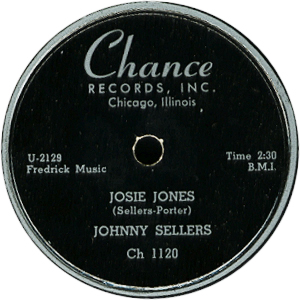
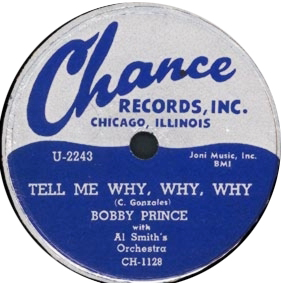
Chance opened 1953 with an ambitious downhome blues recording program. On January 12, 17, 23, and 31, the label ran four marathon sessions with J.B. Lenoir, Sunnyland Slim, Johnny Shines, Big Boy Spires, Johnny Williams, James Williamson (including his famed "Homesick Blues"), Little Hudson Shower, and Floyd Jones. Many of these artists were actually recorded by Joe Brown, whose own label was JOB. Brown, born June 16, 1904 in Oklahoma, had started his first record company (the short-lived Opera label) in 1947. In 1949, he and James B. Oden (St. Louis Jimmy) opened JOB, which was devoted to recording downhome bluesmen. After several fits and starts, including a short-lived alliance with Chess in 1951, JOB produced one notable hit in 1952: Eddie Boyd's "Five Long Years." Chance had begun distributing JOB in July 1952, and it was the nationwide distribution from Chance that made the hit possible.
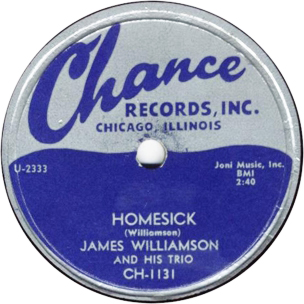
Some of the blues artists from the January 1953 sessions showed up on Chance instead of JOB, and Sheridan would distribute and market both labels through the channels he'd established. Sheridan said of Brown, "He recorded in some strange places. He would go out and record things, but didn't have the money to distribute them. So he'd sell the master or sell it with part of the royalty coming back."
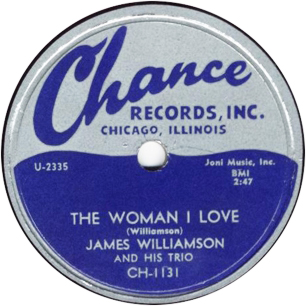
In any case, it is not surprising that some Chance product was appearing on other labels. With 183 sides cut in 1953, the company was recording more music than it could handle...
The January 12 session was probably produced by Brown under the aegis of Art Sheridan (who may have partly financed the date), and Brown received distribution and marketing in exchange for Chance retaining the masters. For example, the May 1953 Chance trade ads included promotional announcements for George Green (Chance 1135), The Flamingos (Chance 1133), and J.B. "Lenore" (JOB 1012).
J. B. Lenoir (pronounced, and often misspelled, "Lenore") was born March 5, 1929, in Monticello, Mississippi. He came to Chicago in 1949 and made his entry into the city's vibrant blues scene through Big Bill Broonzy. Lenoir made his first session for Brown in late 1950; all four sides were leased to Chess. Further sessions in 1951 and 1952 came out on JOB unaided. "The Mojo" is an outstanding performance that features Lenoir's boogie riffs on guitar, Sunnyland Slim's subtle keyboard, and J.T. Brown's rambunctious rocking sax. Lenoir would later garner a reputation as a topical blues singer when he recorded "Eisenhower Blues" for Parrot in 1954, though "Mamma Talk to Your Daughter" was his hit for the label. From 1955 through 1958, he recorded for Checker.
While the J. B. Lenoir sides from January 12 were of immediate interest to JOB, which released three of them, the remaining five items languished until 1964, when Art Sheridan and Ewart Abner put them out on a Constellation LP. There were two vocals by Sunnyland Slim, both among his better performances from the early 1950s, plus an instrumental ("Bassology") that was in his book during the period. The final two sides featured strong vocal performances by Johnny Shines, but even the wild lyrics to "Livin' in the White House" ("I don't need no pilot to chauffeur me in no jet... I'm in a hurry so I'll have to travel space cadet") couldn't tempt Joe Brown to do anything with them. He put his marbles on Shines' work from the January 23 session instead.
Two tracks from January 17 featured guitarist Johnny Williams (with Big Boy Spires on guitar, P. T. Hayes on harmonica, and "Duke" on drums); they were not released until the 1970s. Williams was born in Alexandria, Louisiana, on May 15, 1906. He was raised first in Houston and then deep in Delta blues territory, in Belzoni, Mississippi. His uncle played with Charlie Patton, and Williams got to know Patton, Jim Jackson, Howlin’ Wolf, and other legendary Delta bluesmen. Williams began performing in the late 1920s, arriving in Chicago in 1938. During much of the 1940s Williams played house parties, while first working in the defense industry and then in the Oscar Mayer factory at Division and Sedgwick. After World War II, he fell into the Maxwell Street scene, performing most often with Johnny "Man" Young.
During 1947, Young and Williams and a very young Little Walter were playing at the Purple Cat (2119 West Madison) on the city’s West Side. Williams says he joined the union so he could play there. That year, Young and Williams also recorded their first record for OraNelle, a tiny label owned by Bernard Abrams of the Maxwell Radio and Record Store. Young drew the vocals on "Money Taking Women," and Williams sang "Worried Man Blues." In December 1948, Williams cut two sides for Planet with Johnny Young on mandolin and Snooky Pryor on harmonica.
Williams' session for Chance was his third, and turned out to be his last. He stopped performing blues in 1959 after a conversion experience and entered the Baptist ministry. He reappeared on the scene in 1968 when he attended Little Walter’s funeral. Johnny Williams died in Chicago on March 6, 2006.
Johnny Shines was an outstanding bottleneck guitar player and impassioned vocalist, influenced by the great Robert Johnson with whom he traveled in the 1930s. His "Brutal Hearted Woman," significantly supported by Big Walter Horton's harp work, was described as "brilliant" in Mike Rowe's Chicago Breakdown. Shines was born April 25, 1915, in Frazier, Tennessee. He moved to Chicago in 1941. His recording career preceding this January date had not been auspicious. First there was an unreleased session with Columbia (1946). Then there were two songs for Chess (October 1950) that he recorded with Muddy Waters' band; they were scheduled for release on Chess 1443 but never appeared, though they later became a mainstay of reissue programs. Most recently, there'd been a classic four-song session for JOB in April 1952, producing another classic in "Ramblin'," on the unfortunately super-rare JOB 116. The session of January 23, with Horton on harmonica and Al Smith on bass, producing JOB 1010, his first single with more than 100 pressed, would be the last for Shines until he resurfaced on Vanguard in 1965. Incidentally, U2340, which went unreleased at the time, was given the title "Gonna Call the Angel" when it was first issued (in Japan in 1977). But as the late Steve Franz pointed out, in the first line Shines actually sings "I'm gonna call the county jail." Bit of a difference...
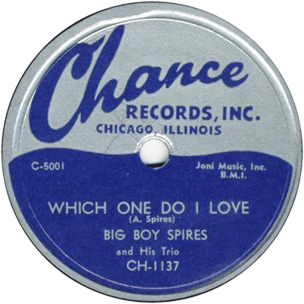
Arthur "Big Boy" Spires, born in Natchez, Mississippi on February 24, 1912, had the sonorous voice of a Son House, but lacked the rhythmic precision. During this period he was working Chicago clubs with his Rocket Four, which included Eddie El on second guitar. With the rhythm section that Chance provided to regulate his wayward guitar—Johnny Williams on guitar, P. T. Hayes on harmonica, and "Duke" (possibly Tide) on drums—he was effective on record. Spires had previously cut a session for Checker in March 1952. He would do another in December 1954 in Al Smith's basement for United (this was left unreleased till years later). Spires made a still largely uneleased session for Testament in 1965, subsequently being forced to give up the guitar by advancing arthritis; he died in Chicago on October 22, 1990.
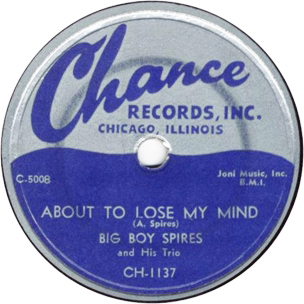
A final joint session with JOB (one that we overlooked in previous editions of this discography) took place on January 31 and produced JOB singles by guitarists Little Hudson Shower (born 1919) and Floyd Jones (1917-1989). Shower, unfortunately, never made another commercial recording session; he retired from playing the Chicago area clubs in 1964. Jones is best known for his "Dark Road," a 1951 recording for the Chess brothers (this in turn was a remake of his earlier recording for JOB).
Although the January sessions seem to have exhausted Brown and Sheridan's joint blues recording budget, the JOB-Chance alliance remained in force through mid-October.
The blues artists that Chance recorded were among the best on the bar-band scene, but the company's productions didn't quite measure up to what Chess and United were putting out. In Chicago Breakdown Rowe commented, "There is little evidence that Art or his general manager Ewart Abner took anything like the pains that Len Chess did with his blues artists." Chance, in fact, would become better known for its vocal group releases.
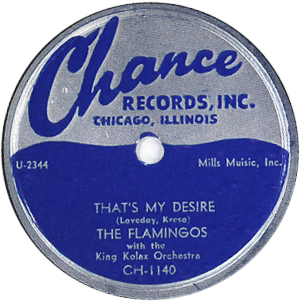
In January, manager Ralph Leon brought to Chance its first vocal group, the Flamingos. Members were Sollie McElroy (lead), cousins Ezekial (Zeke) Carey and Jacob (Jake) Carey, and cousins Johnny Carter and Paul Wilson. Existing discographies mention no personnel beyond the singers and the bandleader, King Kolax. We can hear deep-toned tenor saxophonist Dick Davis soloing with authority on "If I Can't Have You," "Someday, Someway," and "Hurry Home Baby." Kolax was often elusive on his vocal accompaniments; here he sneaks his tightly muted trumpet into the riffs on "If I Can't Have You." His presence on "That's My Desire" and "Hurry Home Baby" borders on the subliminal. The rhythm section in this excellent band consisted of Prentice McCary (piano), "Cowboy" Martin (bass), and Little Gates (drums). Though Chance would use the Kolax band again, this was their only doowop session.
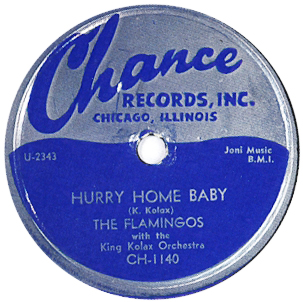
In March, the label put on the street "Someday, Someway" b/w "If I Can't Have You." Although the midtempo "Someday, Someway" was the superior side, by June the flip was doing well in several regional markets, especially in Detroit and Philadelphia. In July, Chance released "That's My Desire" b/w "Hurry Home Baby," from the same session. "That's My Desire," an excellent version of the Frankie Laine hit from 1947, was racking up strong regional sales by August.
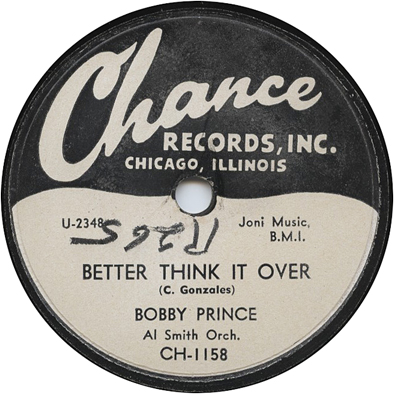
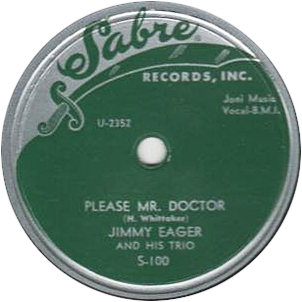
The company rounded out a very busy month with a marathon session on January 29. In any case, Al Smith's full band (Smith, bass; Red Holloway and Cliff Davis, tenor saxes; Mac Easton, baritone sax; Horace Palm, piano and organ; William "Lefty" Bates, guitar; Alrock "Al" Duncan, drums) jammed some instrumentals; then they backed R&B singer Bobby Prince; finally, Al's rhythm section worked behind the legendary Tampa Red. The company put out the Tampa Red releases as by Jimmy Eager and His Trio; Tampa's contract with RCA Victor wouldn't expire till the end of 1953.
Red had made a pretty loud statement in a Cash Box item from January 10, 1953 (p. 20): Tampa Red continues to write and record good blues for the RCA people. The performer feels that in certain locations his records are not getting the air play necessary to make for a bigger royalty check. With youngsters coming out of left field and climbing fast into the $500 to $700 a week, it has a tendency to make the old timers think they should be getting a bigger take." If Red wasn't already thinking of moonlighting for Chance, Art Sheridan just had to read his weekly Cash Box and extend an offer. Tampa Red further disguised his identity by giving all guitar work on the sides to Lefty Bates. However, the composer credits on each side went to Hudson Whittaker (Tampa Red's real name). Chance held the "Jimmy Eager" material for the initial release on its new Sabre label, in July.
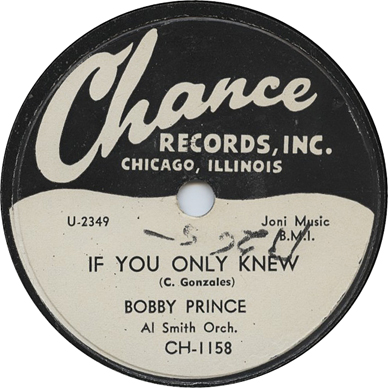
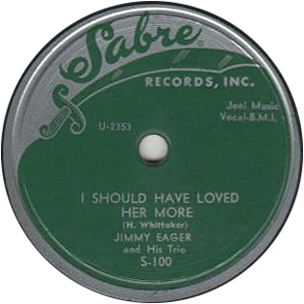
More Bobby Prince tracks might have been expected to see release around the same time, but they ended up being held till the Chance label's last months. Prince wasn't waiting on them. As soon as his contract with Chance ran out, he signed with RCA Victor (where he made two sessions, one with a band led by Lefty Bates and one with a band led by Norman Simmons). With the release of Prince's first RCA single in November 1953, Sheridan must have felt he'd missed his window. Chance 1158 ended up as one of several underpromoted new releases in August 1954. To our knowledge it was pressed on 78 only, at a time when DJs were moving to playing 45s over the air—and those who weren't already were being pushed to. And after a year with RCA Victor, Prince was recording for MGM (with another Norman Simmons band) and hardly noticing what had happened to his second Chance release.
Bobby Prince regularly performed in Chicago clubs, most notably fronting Red Holloway's Band at Club Evergreen (1322 North Clybourn) in 1954. From 1955 through 1957, he regularly worked as the MC at Roberts Show Lounge (6622 South Parkway); his comments to a Chicago Defender writer, about how hard it was getting to find a good shake dancer, are priceless.
Two Al Smith instrumentals, despite exciting tenor sax work, were dealt in the fall of 1953, around the time Sheridan would have been getting serious about releasing more from the session, to Lester Bihari's Meteor label, which Sheridan distributed in Chicago. They appeared on Meteor 5013 in October. After a period of inactivity, Meteor released them again as 5026 in December 1956, using different titles the second time around. (It might have been the unintentionally wild organ playing by Horace Palm, who rarely strayed from his piano, that convinced Sheridan to unload the items.)
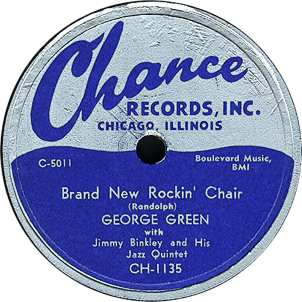
In February, Chance did a session with the Jimmy Binkley Jazz Quintet (tenor sax, piano, bass, drums, and congas/bongos). According to Allan Roberts, Jimmy Binkley was a pianist in the Erroll Garner tradition. We once gave April 1930 as his approximate date of birth. Though it was not widely known until his obituary was published, James H. Binkley was born on March 1, 1923, on the West Side of Chicago. Jimmy Binkley was on the Chicago scene in the late 1940s, but worked only sporadically as a leader in Local 208's area; for instance, when he did a 3-day stint at Club Maramba (best known for its bar-walking tenor saxophonists) in early April 1950 (contract accepted and filed by Musicians Union Local 208 on April 6). On October 19, 1950, he posted an indefinite contract at the Caldonia Club; in December he showed up at Joe's Rendezvous (indefinite contract posted on December 7; another indefinite followed on March 15, 1951, and still another on April 5). In August 1951, he moved to Club Evergreen (whose indefinite contract with Jimmy "Binkly" was accepted and filed by Local 208 on August 16, 1951). He was at the club for a long time, judging from a photo and blurb in the Defender for May 1, 1952 (p. 23).
In June 1952 Binkley showed up at Joe's Rendezvous again (indefinite contract accepted and filed on June 19, followed by another on August 21). In late September, Binkley took up at the Brass Rail in the Loop (indefinite contract posted on October 2, followed up by one for another 4 weeks on December 4). Jimmy Binkley also got his first recording opportunity in 1952. He cut four sides for Aladdin in Chicago: Aladdin 3193 (released in July 1953) consisted of "Night Lite" b/w "Hot Smoke" under his own name, and on Aladdin 3194 (probably released that same month) his band backed blues singer Harold Burrage on "Sweet Brown Gal" b/w "Way Down Boogie." These featured the booting tenor sax work that was usually included on Binkley's recordings, but not always on his nightly gigs.
In February 1953, he was at the Capitol Lounge (2 week contract posted on February 19; a 3-week extension was posted on March 5). Probably done while he was at the Capitol Lounge, the Chance session was Binkley's second recording opportunity.
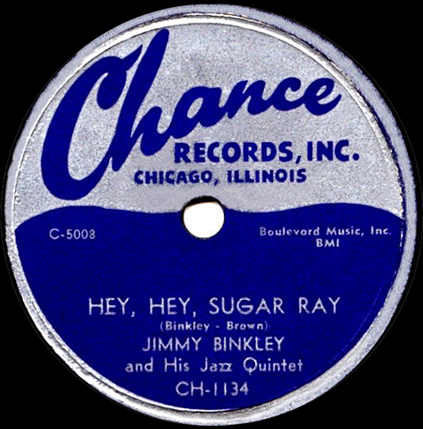
The only performer besides the leader to be identified on the Chance labels is the drummer, George Green, who also contributed uptown blues vocals to two sides. (Binkley himself led the singing on "Hey, Hey, Sugar Ray.") However, the only instrumental on the date, "Midnite Wail," is credited to Binkley, Harris, and Mitchell. So we figure that Dave Mitchell was the tenor saxophonist on the date, and Tommy Harris, usually a drummer, contributed the additional percussion. (Otherwise, the band wouldn't have been a quintet). It's also possible that Eldee Young was the bassist (see below).
The Binkley session was one of the few that Sheridan actually recalled, perhaps because he claimed some input into it. Said he, "I remember writing 'Finance Man.' We did a session with three other tunes and we were short a side. In the old days you would do four sides, and it wasn't uncommon then to write a blues on the spot, so I wrote 'Finance Man.'" Sheridan obviously remembered the recent Willie Mabon hit, "I Don't Know," because he lifts certain patterns directly from it. Bill Putnam, the decidedly non-blues-oriented proprietor of Universal Recording, got cut in on the composer credits.
After their Chance session, Binkley's group spent a lot of time on the road. In June the Jimmy Binkley Blue Notes were at the Piccadilly in Green Bay, Wisconsin. Ads (Green Bay Press-Gazette, June 15, 1953, p. 23; June 19, p. 13) show a quartet with a female bass player—apparently Betty Dupree had joined the group for a while. Binkley, whose recording deal with Chance may have been a one-off, also got a release in on Dot. The matrix numbers on Dot 1183 are from RCA Victor and indicate 1953 recordings. The publisher indicates that the record was originally made for a small Indianapolis-based company called Note. We will be running into Note again.
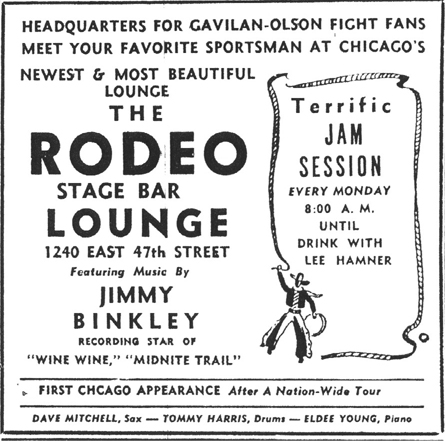
In January 1954, Jimmy Binkley cut one more single with a trio (it sounds to us like the same bassist and drummer) for the Chess brothers: "Boogie on the Hour" b/w "Wine, Wine, Wine" (Checker 789) which featured his own vocals. This got a fair amount of promotion, but did not become a hit. On February 2, Jimmy "Binkly" and His Orchestra were in Akron, Ohio, as part of a package tour with the Flamingos, Danny Overbea and Della Reese (Akron Beacon-Journal, February 1, 1954, p. 10). A week later, the Jimmy Binkley Quintette was at the Terrace in East Saint Louis, Illinois, on a bill with Bull Moose Jackson (St. Louis Post-Dispatch, February 9, 1954, p. 13A). On March 18, 1954, Binkley posted a contract for 2 weeks at the Rodeo Inn (1240 East 47th Street). The Rodeo boasted (in a Defender ad that ran on April 3) that this was his "First Chicago appearance after a nation-wide tour." It also mentioned one of his Chance sides and one of Checker sides—and got both titles wrong. The other members of the group were identified on this occasion as Dave Mitchell, tenor sax; Eldee Young, bass (not piano, as stated in the ad); and Tommy Harris, drums. In the meantime, George Green was appearing elsewhere as a singer.
Back on the road, Binkley did four days (including a Sunday matinee) with Sarah Vaughan at the Apache Inn in Dayton, Ohio (Dale Stevens, "Sarah Vaughan Opens Here Thursday; Medith Dallas Antioch Standout," Dayton Daily News, June 14, 1954, p. 14). He resurfaced in Chicago at Squeeze's Rendezvous (contract for 2 weeks with options posted on September 16, 1954). At the end of November, Jimmy Binkley and the Blue Notes were back at the Terrace in East St. Louis (St. Louis Post-Dispatch, November 30, 1954, p. 6C). On December 14, they were back at the Piccadilly in Green Bay (Green Bay Press-Gazette, December 10, 1945, p. 10; December 20, 1954, p. 32).
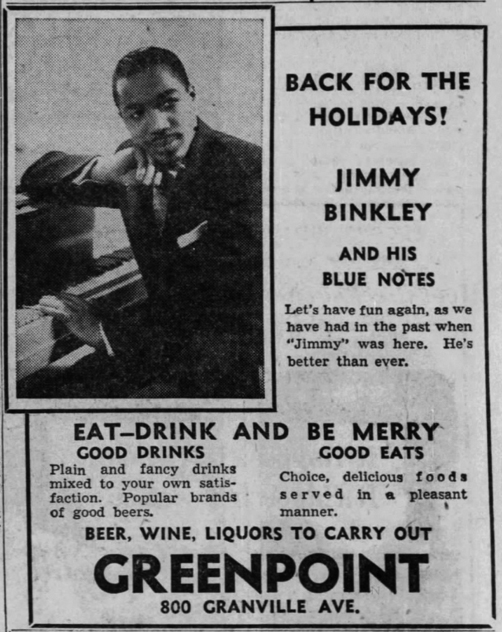
1955, we presume, featured more of the same, but the only notices we've found were for an appearance in Muncie, Indiana, in December (Muncie Star, December 18, 1955, p.22-A. He'd been at the club before.
Jimmy Binkley cut his second and last session for Checker on January 24, 1956. Later that year, his combo backed the Dusters, a vocal group, on ARC 3000. ARC was a new label based in Cincinnati; ARC 3000 was reviewed in Cash Box on September 1, 1956 (p. 36). Newspaper coverage of his gigs from the late 1950s is extremely spotty, but in November 1956, he was working the Rod and Gun Club in Bloomington, Illinois (The Pantagraph, November 7, 1956, p. 2). Around 1957, Jimmy Binkley and his quartet recorded with the doowop group the Teasers on Note 1002 (which naturally raises an interesting question about the Teasers' single on Checker 800, which was recorded in 1954). The flip side of the Note release was a nice jazz instrumental on "Blue Moon."
To our knowledge, even though Binkley kept performing into 2014, the Note single would be his last commercial recording. Past 1957, the newspaper coverage gets tenuous, but they liked him in Muncie and in April Jimmy Binkley and His Blue Notes were working the Showboat (Muncie Star, April 21, 1959, p. 4).
Meanwhile, George Green played in other piano trios (including King Fleming's) and finally went out on his own; he made a rock and roll record (for real) in 1959 for Tempus, which was based in Peoria, he cut another couple of singles for small labels in Chicago, in 1962 and 1963 his trio cut two LPs M&M.
In 1960, Jimmy Binkley made a permanent move downstate, to Peoria, Illinois. As he told Jim O'Neal in 2006, "I came here to play two weeks and I've been here ever since." According to an article on Happy Jimmy Binkley Day, in the Peoria Journal-Star, October 17, 2010, Binkley's quartet landed a steady gig at Collins Corner. When the bar's owner could no longer afford a quartet, the other musicians returned to Chicago and Binkley stayed. Pretty soon he was landing hotel gigs, at the Jefferson and the Pere Marquette. One time that we know of, Jimmy Binkley and the Blue Notes were lured out of town—all the way to Bloomington, Illinois. The combo was at the Captain's Cabin in Bloomington in June and July 1964 (The Pantagraph, July 20, 1964, p. 2). Allan Roberts, a jazz pianist who used to trade spots with Binkley when they were both working in Peoria, recalls that "in the late '60s... he fronted a post-bebop club in his name on North Adams street. Later (in the early '70's) when the popularity of jazz was on the wane, he did a single piano bar at Jim's Steak House on Fulton Street in Peoria with occasional sit-ins from members of his old group and others. As far as I know, he's still playing in Peoria (as of a year ago)."
In 1982, Binkley made an appearance in a feature story about a band called Southern Comfort that logged a lot of highway miles and had most recently been through Decatur, Kankakee, and Peoria, Illinois, and Keokuk, Iowa (Michael Hirsley, "On the Road Again... and Again... and Again," Chicago Tribune Magazine, April 25, 1982, pp. 10-12, 14, 16, 18). Binkley, who had to wait to go on on a Monday night as Southern Comfort was frantically running sound checks, was playing the piano bar from 5 to 9 PM at the Ramada Inn lounge in Peoria, then working a steak house. A present was waiting for him on top of the Ramada Inn piano, for 17 straight years playing in Peoria (p. 18; it should have been 21 or 22, if the stretch in 1964 hadn't counted against it.) In 1986, Binkley and his band appeared in Jo Jo Dancer, Your Life Is Calling, a film vehicle for comedian Richard Pryor, who was born in Peoria and sometimes worked as an MC in the clubs that Binkley played. In the 1980s and 1990s, Binkley was featured in each jazz festival that took place in Peoria.
When Allan Roberts emailed us, Jimmy Binkley was a regular at Jumer's Castle Lodge in Peoria. He made a special apparance at the Illinois Blues concert organized by Koko Taylor and Jim O'Neal. This was held in Millennium Park in Chicago on September 7, 2006 as part of the Great Performers of Illinois series, along with bands led by Reggie Britton, David Dee, and, of course, Koko Taylor. Working on this occasion with Preston Jackson, a guitarist from Peoria, Binkley had to relearn some of the material that he'd recorded in the 1950s. It was his first performance in Chicago since 1960.
In 2010, Binkley, who at 87 had long since quit giving out his age, was still playing two nights a week at Sky Harbor Steak House in West Peoria. His repertoire was said to include "Paper Moon," "It Had to Be You," and 'What a Wonderful World" (Phil Luciano, "Peoria jazz man still makes them smile," Peoria Journal Star, October 17, 2010; https://www.pjstar.com/article/20101017/NEWS/310179979). He was also continuing his regular practice, since around 1985, of bringing a portable keyboard and playing at nursing homes. He often performed at several nursing homes each week. Beginning in 1994, he and his wife Sandra held big semiannual parties (Senior Citizen Day and Christmas for Seniors).
Probably his last public appearance was at the 2014 Christmas parade in Peoria, where he was the grand marshal. Jimmy Binkley died at Saint Francis Medical Center in Peoria, on January 26, 2015. He was 91 years old. His memorial service took place at Sky Harbor Steak House. His obituary can be seen at http://obit.funeralnet.com/obitdisplay.html?id=1475264&clientid=thewiltonmortuary. The Christmas for Seniors events are continuing.
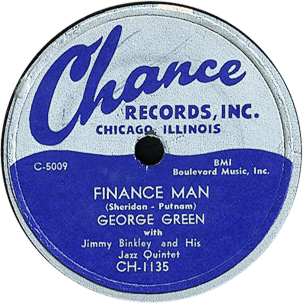
In March, Chance recorded the jazzy R&B of Tommy Dean, a pianist and organist based in Saint Louis. Born in Franklin, Louisiana on September 6, 1909, and raised in Beaumont, Texas, Dean had performed with carnivals and circuses before moving north to St. Louis in 1937 or 1938. Initally Dean toured with Eddie Randle's Seven Blue Devils, then he founded his own combo, which toured all the way to Mexico. Dean began making appearances in nightclubs on Chicago's South Side in 1945 and cut his first single for the St. Louis label Town and Country in 1947. Because St. Louis was short on recording opportunities, Dean picked up with the Chicago-based Miracle (a session in 1949, plus two sides picked up from Town and Country or another small St. Louis label) and States (two sessions in 1952).
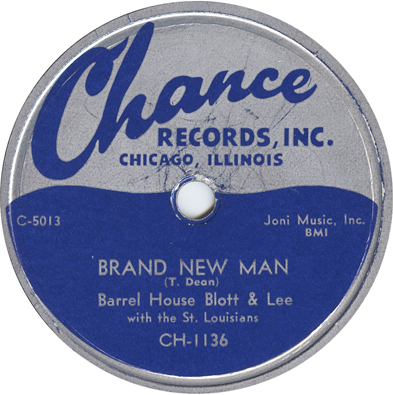
At the time of his Chance session, Dean had recently lost most of his group, including his star soloist, when alto saxophonist Chris Woods struck out on his own. Perhaps because of an unexpired contract with States, the group went merely as "Barrel House Blott and Lee with the St. Louisians"—but in case anyone didn't realize who the leader was, Dean appears on the label as the composer of both sides.
Barrel House Blott was a standup blues singer and a comic monologue artist. He was a mystery to us until Armin Büttner turned up a delightfully titled item in the Chicago Defender announcing that he had signed with Aristocrat: "Freddie Blott, local blues and jump sensation, caught the eyes of talent scouts from Aristocrat Records when he was featured here this week at a concert given to determine the best combo in St. Louis" ("Aristocrat Inks Blott," December 3, 1949, p. 26). Blott was supposed to record with a band led by Ditty Bo Hill, but something must have fallen through (Aristocrat was nearly out of money, so there were lots of ways for something to fall through). So far as we know, the session for Chance would be his first and only.
The Blott session looks to have been the first to involve Dean's new band with Chuck Tillman on tenor sax, Archie Burnside on bass, and Edgar Plaes on drums. It produced the requisite four sides, two of which remain unheard.
After Chance wound down, Dean would move on to Vee-Jay, where he recorded five more sessions between 1954 and 1958. He continued to tour with his St. Louis-based combo until 1960, then worked as as a solo organist until his sudden death (probably from a heart attack) in January 1965.
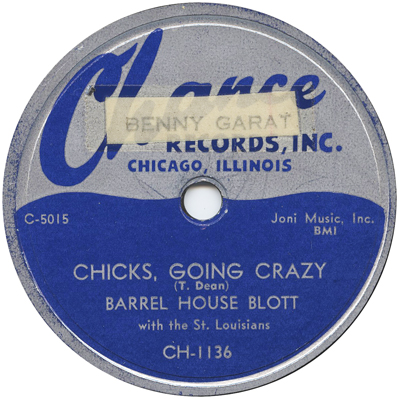
After 4 sides by Bigtime and Shirley, about whom we know nothing, because nothing of theirs was released, Chance extended its gospel series with two sides by the Wooten Choral Ensemble. The choir was led by organist Robert Wooten, and Lawrence Evans was the lead on "Hand of God." Otherwise, groups under the direction of Robert Wooten recorded one single for the Crusader label (at an unknown date), an LP for Vee-Jay (around May 1963), and two singles for a tiny Saint Louis operation called Joyfulets (also at an unknown date).
In April, gearing up for the Chance 3000 series, the company conducted a number of pop sessions: Elaine Rodgers with a band directed by Remo Biondi, Al Morgan, the Four Bits, Lucy Reed, Dolph Hewitt, and Buddy DiVito with the Meadowlarks. Lucy Reed was really a jazz singer, and Elaine Rodgers, the Meadowlarks, and Buddy DiVito were jazz-capable. Dolph Hewitt was a Country performer. But Art Sheridan didn't have the Blue Note or the WLS Barn Dance in mind when he made these sessions.
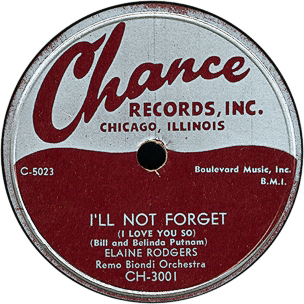
Elaine Rodgers was born in Chicago in 1926, growing up in Franklin Park. At age 7, she performed a Scottish sword dance at the British pavilion at the Chicago World's Fair. Graduating from East Leyden High School, she joined the USO and tap-danced for troops in the Philippines. She worked for a while in a touring chorus line, then in 1949 she auditioned for the Meadowlarks. She not only got the job, she ended up marrying Maury Jackson. In 1950, the Jacksons moved to Lombard, Illinois. Not long after joining the group, she started getting her own billing as a soloist.
The first record that we know featured Elaine Rodgers was done in June 1950 for Bud Brandom's first edition of the Oriole label (Oriole would get a brief revival in 1958-1959, with a very different artist roster, from Brandom and Joe Brown). But the first edition of Oriole lasted just one year.
In 1951, Rodgers appeared on a highly obscure release on the Master label, which was owned by Egmont Sonderling of United Broadcasting Studios. Activity at the studio was slowing that year, and the Master release carried no serial number, just the matrix numbers UB51-425 and 426. In effect, it was a glorified demo. Both titles were pop tunes composed or co-composed by one Eddie Fritz, Jr., who presumably paid for everything The performers were the Ambassadors of Note Orchestra, featuring Elaine Rodgers and Lon Saxon.
Not long afterward, Rodgers made a guest appearance on a session by Lee Monti and his Tu-Tones; her vocal duet with Danny Parker was featured on "Whispering Shadows" and "In a Little Second Hand Store" (Sharp 39). The Sharp was recorded in August or September 1951 and was definitely released around the end of September (talked up in Cash Box on September 29, p. 9; October 6, p. 9; and October 13, p. 9; advertised on October 6, p. 13, and reviewed in Cash Box on October 13, 1951, p. 6). However, the small Chicago-based company had dropped its lease deal with London in July and was yet to pick up with MGM; whatever the single was doing in Chicagoland could not translate into national sales.
Then there are sides Rodgers cut for Dick Bradley's Tower label. These were recorded in 1950, maybe even before her session for Oriole. Tower was running into financial trouble in 1950, partly because James Martin in Chicago was its only reliable distributor. So this material was not released till the end of 1951, after Jules Bihari of Modern basically bought Tower from Dick Bradley (the deal was announced on November 10; see "Modern Gets Tower Distrib, Press Rights," Billboard, November 17, 1951, p. 15). The new Towers were often packaged with different artists on the A and B sides, were put out in some haste, and sold poorly. We know of a Tower 1504, released in limited quantities in December 1951, with "Don't Grieve, Don't Sorrow, Don't Cry" by Buddy DiVito on one side (matrix RB-2018), and "Who But You" by Elaine Rodgers on the other (RB-2019). Accompaniment was supplied by Bernie Yuffy and Orchestra. Meanwhile, there is a black-label Tower 1504 by another artist. The DiVito/Rodgers 1504 was a red-label Tower. Another Tower of uncertain number, included in the same low-circulation release, had two sides by Buddy DiVito. (DiVito's Tower 1508, "Diggin' for Old Black Coal" b/w "Take My Heart," was listed as a new release in Billboard on September 1, 1951, p. 33); it needs confirmation). So Rodgers and DiVito knew each other from the Tower session, if they had not worked together before that.
Her Chance session gave Elaine Rodgers her fifth solo opportunity. So far as we know only the two released sides were made that day. "I'll Not Forget" is the expected sentimental ballad; "You'll Need My Help" is a sassy Country and Western number (the Meadowlarks' radio work included some guest appearances on Country shows).
To make the arrangements and lead the studio band, Art Sheridan made a wise choice: he brought in Ray Biondi. Born Remo Biondi, in Cicero, Illinois, on July 5, 1905, he was initially trained as a violinist, later picking up the mandolin, the trumpet, and the guitar. From 1926 to 1934, Biondi worked as a freelance musician in Chicago, then moved to New York. From 1938 to 1945 he was the guitarist in Gene Krupa's band. Returning to Chicago, he led his own groups, including one that had a long run at the 606 Club. He also played a fair amount of Country music. By the time he landed this session for Chance, Biondi had a steady job with a radio network and was appearing on nearly every kind of recording session in his spare time (see our United and States and Jimmy Coe pages for two of the more unusual examples). Although this was a pop session, Biondi used an organ instead of a piano, and his guitar is unusually prominent. He also procured the services of an excellent trombonist, who plays muted on both sides. "You'll Need" includes a Western Swing solo from Biondi and a regular Swing solo from the trombonist. The only other instruments were string bass and drums.
Chance 3001 was released in May 1953. Cash Box reviewed it on June 6 (p. 16). Most copies of Chance 3001 show the newly adopted silver on red label for pop releases. However, Internet Archives' 78 rpm collection now includes a copy with the regular silver on blue. The publisher credit for "I'll Not Forget," which was written by Bill and Belinda Putnam, is to Studio Music on the blue-label 78, and to Boulevard Music on the red-label 78 and the red-label 45.
Buddy DiVito became the biggest single contributor to the Chance pop series, with 3 releases to his credit. He was one of the big names at the time, having attracted national attention as a vocalist when he joined Harry James' big band in 1945, on the recommendation of the band's manager, Buddy Moreno. The crooner was born Anthony DiVito on March 1, 1920, and attended Manley High on the West Side, where he played baseball and basketball. He was reputed to be almost as good at carpentry and cooking as he was at singing. DiVito's entrée into the music business came when he joined the Gay Claridge Band at the Merry Garden Ballroom on the North Side in 1943. He then worked with the Eddie Oliver Band, followed by nearly five years with Harry James. DIVito appeared on many James band sides for Columbia. After taking his leave from Harry James, DiVito led his own big band (for instance, it was booked into Lakelawn at Lake Delavan, Wisconsin for part of August 1949; Billboard, August 6, 1949, p. 33). He subsequently had to downsize. In 1950 he made a session for Tower, leading to two releases in the final quarter of 1951 (see above; DiVito shared the vocal chores with Elaine Rodgers). In 1952 he did a single for Sharp. This was during a down period for Sharp, which didn't have a deal with a bigger label any more, so don't know exactly when Sharp 54 was released. DiVito was out autographing copies of it on November 28, 1952, when he appeared at the Garetto Twin's store in Blue Island, Illinois. At the time he was working at the Melody Manor, 103rd and Vincennes ("Buddy DiVito at Garetto's Tomorrow," Blue Island Sun-Standard, November 27, 1952, p. 15). Tower and Sharp recorded DiVito with a studio ork, and so did Chance.
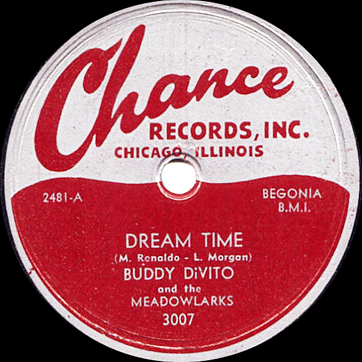
In April 1953, the company paired him with the Meadowlarks, releasing both sides in November as Chance 3007. This was the version of the group with two women and two men. We know from the documentation on their session with Leon Sash (in 1954) that the group consisted of Elaine Rodgers and her husband Maury Jackson, Marie Renaldo, and Bob Bleznick. "Dreamtime" was in fact written by Marie Renaldo—and Lee Morgan, who played string bass, sang soprano, and was married to Leon Sash. With the Meadowlarks' rich harmonies, Sheridan figured he could economize on session instrumentalists: all we hear are vibes, piano, guitar, and bass.
The Meadowlarks kept going for a few more years. Later in 1953, they cut a single for a tiny local label. Paradise 101, to our knowledge the only Paradise there ever was, had Elaine Rodgers singing lead on both sides. Both tunes were credited to one Ted Johnson, who must have paid for the whole thing.
Around April 1954, the Meadowlarks scored their biggest musical opportunity, when they were called to appear on a session by accordionist Leon Sash. Leon Sash was born Leon Robert Shash on October 19, 1922. By age 10 or so, his vision had deteriorated so badly that he could only distinguish light from dark, but he refused to consider this a handicap. He began performing in public when he was 15, if a 1937 newspaper reference is reliable. An extreme virtuoso, whose recorded performances still elicit declarations of inability to analyze what he was doing technically, he played bebop on the accordion, at 300 quarter notes per minute.
Bios from the 1950s stated that Sash played for 6 years in the Cosmpolitans, a trio of accordion, guitar, and bass. We know this group from records only because it backed Ken Griffin on a February 1949 session for Rondo. Sash then started his own trio. He probably came to the attention of the record industry because his wife, Lee Morgan (not to be confused with the hard-bop trumpet player born in 1938), who played bass in his trio, sang on a Remo Biondi record for Decca, which was cut at Universal in August 1953. She may also have been responsible for bringing in the Meadowlarks. Bill Putnam took a flyer on recording Sash at Universal and then got Bob Shad to sign him to Mercury's EmArcy imprint. The four tracks released in 1954 had nonconsecutive matrix numbers, another group of 4 not released then had still a different block of matrix numbers, and three got none at all, a pretty good giveaway that they had not initially been done for Mercury. And there is an item from the trades about Shad recording Sash in August 1954. The total accumulation was 11 tracks, enough for an LP. But despite positive reactions from critics and reviewers, Mercury lost interest after two singles in 1954.
The LP, titled The Master when it appeared at last, would not materialize until 1980, when Polygram pressed it up specially for Sounds of Sash, run by Lee Morgan. Leon Sash was accompanied for Mercury by Rudy Kerpays on piano, Sully Picerno on bass, and his regular drummer Max Mariash, plus a little bit of guitar from Maury Jackson, and a vocal sextet consisting of Lee Morgan (lead soprano), the Meadowlarks, and Eddie Vana. Vana, a jazz violinist, and a member of the Cosmopolitans as well as of Sash's groups, who sang baritone on this occasion. For more on Eddie Vana (1917-1992), see "Edward Vana, Chicago Jazz Violinist," Chicago Tribune, February 1, 1992, http://articles.chicagotribune.com/1992-02-01/news/9201100230_1_mercury-label-chicago-area-glen-ellyn)
The vocal arrangements were the equal of anything the Swingle Singers or Manhattan Transfer would be doing later on, enabling the Meadowlarks to prove to anyone with ears that they were a jazz ensemble. After his debut, Sash recorded rarely: a Storyville jazz LP in 1956, a live appearance at Newport on a Verve LP from 1957, an LP of polka music for Harmony in 1959, a limited-edition LP from 1962 consisting of "orchestrations" that Sash performed with two other musicians playing custom-built tenor and bass accordions, and a final jazz outing on Delmark from 1967. He died of a heart ailment on November 25, 1979.
The Meadowlarks may still have been working together in September 1955, when Ron Terry was about to end his run with a show at Club Hollywood in Chicago, which featured singer Evie Eraci and "the Terrytones (formerly The Meadowlarks)" (Cash Box, September 24, 1955, p. 12). Terry, Eraci, and the Terrytones had just released a record on the KaHill label, out of Des Plaines, Illinois; KaHill 1005 was reviewed in Cash Box on October 1, 1955 (p. 11). After the Meadowlarks broke up, Elaine Rodgers and Maury Jackson still frequently worked together. In the 1960s and 1970s, Rodgers mostly sang in commercials. At different times, she was heard on spots for Budweiser beer and for Holsum bread. The Budweiser spots led to a limited-edition short LP, of the soundtrack to a film shown to Budweiser's marketing force. The two tracks were recorded at Universal in October 1962: Elaine Rodgers sang, to the accompaniment of session musicians like Rudy Stauber (trumpet), Cy Touff (bass trumpet), Mike Simpson (flute), Earl Backus (guitar), Johnny Frigo (bass), Frank Rullo (drums), and Bobby Christian (vibes). She also acted in a few commercials, most notably one for Ball Park Franks. In 1986, Maury Jackson died and Elaine Rodgers took a part-time job as a clerk in a public library, occasionally astonishing her coworkers with stories about working with Bob Hope, then showing them proof from her scrapbook. She retired from Addison Public Library in 2010. Elaine Rodgers Jackson died on March 4, 2012, at Elmhurst Memorial Hospital in Elmhurst, Ilinois; she was 85. (See Joan Giangrasse Kates, "Elaine Rodgers Jackson, 1926-2012: Performed with jazz quartet in '50s and '60s," Chicago Tribune, March 21, 2012, http://articles.chicagotribune.com/2012-03-21/news/ct-met-jackson-obit-20120321_1_jazz-quartet-lombard-popular-jazz.)
The Chance red-label vocalist of greatest interest for many now is Lucy Reed. Lucille Magdolin Dollinger was born on January 14, 1921, in Marshfield, Wisconsin; she was the daughter of Max Dollinger (1901-1996), who was born in Germany, and Elizabeth Shields (1899-1987), who was from Minnesota. She went to high school in St. Paul, Minnesota. After her parents divorced and her mother remarried, she lived in Iron Mountain, Michigan. She sang on the radio (KSTP) in St. Paul, in a four-girl group (payment was $5 a performance), and appeared occasionally on local engagements. In the 1940 census, Lucille Dollinger appears as a 19-year-old resident of Iron Mountain, living with her mother, Elizabeth Jetty, and her stepfather, Jack Jetty. In the first advertisement we have been able to find for her as a singer, she was working with Jerry Salone's band at a dance hall in Escanaba, Michigan. Salone was a saxophonist who had been active in Wisconsin and Upper Michigan since the early 1930s. Like nearly anyone working that territory, he programmed a mixture of dance and polka band material. In 1943, Salone's band would be busy in the Detroit area; in 1944, it was most often working around Cincinnati.
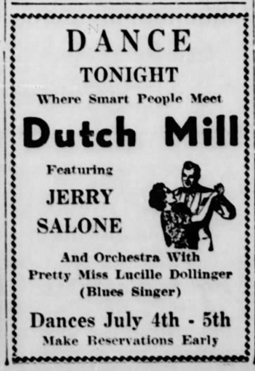
Around 1941, Lucille Dollinger married Joseph A. "Joey" De Ridder, a jazz drummer who was born in 1917 in Norway, Michigan (just down the road from Iron Mountain). His band was active locally. Serving in the Air Force, Joey was killed when his plane was hit over Munich, Germany, on July 31, 1944. (For some important details here and in what follows, we are indebted to her son Ted Seymour's blog posts, particularly http://explorationsoftruth.com/2009/07/moms-ashes/ and http://explorationsoftruth.com/2009/08/lu-and-joey-together-again-and-the-inheritance-of-grief/)
A 23-year-old widow with a baby son, she felt needed a direction in life and embarked on a career as a soloist. By any indication available to us, this was a slow process. On December 18, 1948, Lucille De Ridder, still very much a local performer, sang at the grand opening of the renovated Elks Lodge in Manistique, Michigan (according to the Escanaba Daily Press, Manistique section, "BPOE to Hold Grand Opening," December 11, 1948, p. 10.) She was working with Leroy's Quintette out of Iron Mountain.
The sparsely inhabited Upper Peninsula was not much of a jazz market. Lucille De Ridder obtained work in a place that had a little bit of a jazz market, Milwaukee (we are not sure when), then got a break when she joined Woody Herman's band direct from an engagement in Duluth, Minnesota. This was reportedly in 1949, though we don't have any details on it (Mary Ann McCall was Herman's regular band singer from 1946 well into 1950, but he could have needed a temporary replacement). We suspect that around this same time she took Lucille Reed as her stage name. From Woody Herman, Lucille Reed moved on to Charlie Ventura's big band. This was not Ventura's Bop for the People with Jackie Cain and Roy Kral, which broke up at the beginning of June 1949. Or the big band he led for recording purposes in December of that year. Ventura now found it prudent to operate something more like a dance band—but the 17-piece ensemble he put together in late January 1950 (Ed Sullivan, "Little Old New York," Oil City (Pennsylvania) Derrick, February 7, 1950, p. 8), used top jazz arrangers and sometimes added Red Rodney as a trumpet soloist. Lucillle Reed was moving around the country with Ventura probably from February (and definitely from April) to December 1950, being mentioned in some of the publicity for the band as well as reviews of live appearances.
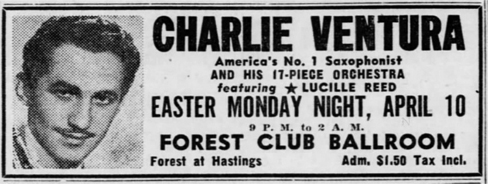
A Billboard reviewer (Johnny Sippel, May 27, 1950, p. 16, 36), catching the big band in Chicago on April 20, 1950, thought Ventura's sound was still too "modern," his tempos too hard to dance to, and wanted to see current pop hits featured more often. He didn't find the vocal offerings quite right for the dance crowd either:
Lucille Reed has a different, sophisticated approach to ballad presentation, but the band needs a novelty singer and boy with a strong baritone to spice the steady chirp diet. (p. 36)
Her first record was "You've Got a Date with the Blues," a song by Leonard Feather that the band recorded in New York on April 6. It appeared on RCA 20-3770 in May 1950, as the flip side to a new rendition of Ventura's tenor sax feature, "Dark Eyes." Red Rodney was not in the band for the session, though he would be on hand in Chicago on April 20. The Billboard review (May 13, 1950, p. 34): "Contrived bluesy ballad is thrushed ably by Miss Reed with a modern and fine Manny Albam cleffing filling the ork backing." The song begins and ends with a vocalise, which Lucy Reed would also employ on one track from her first LP.
She would not get other recording opportunities with Ventura. RCA Victor cut a measly 7 sides with the band. None of the four from the second sesssion, in July 1950, were released at the time (the Honeydreamers, who may have been brought in to respond to critiques like Sippel's, did all the singing on them anyway). Ventura was fed up, announcing in December 1950 that he was leaving Victor (when he started recording again in 1951, it was for Norman Granz's Clef operation). And Lucille Reed landed in Chicago when Ventura broke up his big band there. In December 1950, Ventura took over ownership of a club in Lindenwold, New Jersey. Initially, it was annnounced that a 14-piece ensemble would be the house band, and Reed would be part of it, but if that was the plan, it was quickly dropped. (In 1951 Ventura was appearing at his club with a quintet, after a while reduced to a quartet.)
For the next few months Lucy Reed took such engagements as she could find. She entered the DuMont network's second Miss U. S. Television contest. This was not the 1950 competition. (The 1950 pageant is often thought to have been the only one, because the kinescope of the finals is one of the few DuMont shows to have survived.) It was the 1951 event, also with winners from the 13 cities with DuMont network stations. The Miss Chicago Television portion of the contest took applications in April 1951 and ran for many weeks on WGN-TV. On the strength of that bit of publicity, she was one of the guest vocalists at the DeKalb, Illinois, Municipal Band's final summer concert, on August 21, 1951 ("Festival Has Good Program: DeKalb Municipal Band to Close Its Season on Tuesday Evening," DeKalb Daily Chronicle, August 18, 1951, p. 1). Lucy Reed won Miss Chicago Television in November, but lost in the national finals, also broadcast from WGN, on December 5, to Miss Baltimore Television, Phyllis Maygers. Little matter—work had arrived. In fact, on November 29 she appeared on the first episode of This Is Music on WGN-TV, and she stayed with the show through the third week of January 1952. From February through August 1952, she made regular appearances on Top Tunes, a weekly half-hour show on WGN radio with Robert Trendler playing piano and leading the studio band. The male vocalist on Top Tunes, Bill Snary, had previously worked with her on This Is Music. Most listings for Top Tunes in the local newspaper radio sections actually identified the songs that were being performed. We can also see a final name change; through March 1952, she was Lucille Reed; starting on April 6 (Decatur Sunday Review, April 6, 1952, p. 52), she was Lucy.
The Streamliner Cafe, a Loop club, announced a new policy of showcasing new (therefore less expensive) jazz talent, making the unusual move of hiring two experienced but not yet famous female vocalists, Lucille Reed and Lurlean Hunter (who was born in 1919). (This was not some little bitty place with singers taking turns at the piano; for a while the Streamliner kept a full-time pianist and a full-time organist on the payroll.) In September, the Streamliner's new program, Reed in particular, got a positive notice from the Chicago Tribune's entertainment columnist, Will Leonard ("Tower Ticker," September 12, 1951, part 3, p. 7):
The Streamliner, a surprisingly beautiful room across Clinton st. from the North Western stations, has something that's no form of jazz we recognize, in its new "Rising Stars of Jazz" policy. Stan Facey plays a rapid piano with overtones of boogie-woogie, Les Strand thumps a speedy electric organ, Lurlean Hunter intones love songs, Lucille Reed, erstwhile vocalist with Charlie Ventura, is the one who seems most qualified to be a star on the ascendant. She takes a microphone into her confidence with distinctive style, caresses and cajoles a song, and makes antiques say new things.
Facey was soon replaced by Ernie Harper, formerly of the Five Blazes, who immediately became Hunter's preferred accompanist.
Pat Harris's Down Beat article praised her work alongside Lurlean Hunter in a jazz context. At the Streamliner, Reed usually performed with pioneering Hammond organist Les Strand, whose solo repertoire included "Caravan" and "Groovin' High."
Lucy ... appears to have put countless hours into perfecting her presentation. Where Lurlean is gay and vivacious, Lucille is subtle, melancholy, subdued. She shines on things like Lonely Town, Wonder Why, I'll Be Around, and occasionally a shoulder-shaking St. Louis Blues
With a classically perfect face, short-cropped red curls piled high, and a sophisticated gowning that hints of the Victorian salons, she gives the effect of a marvelously fragile figurine. And she sings. Throatily, clearly, with nuances no one else seems to have explored. ("Music Superb, Atmosphere Ideal" at Chi's Streamliner, Down Beat, November 2, 1951, p. 5)
In his first column for Cash Box, DJ Sam Evans was also enthusiastic about the new policy at the Streamliner, "Where Stars Are Born." He declared that "LUCY does one of the greatest jobs ever on 'St. Louis Blues'" (Sam Evans, "Kickin' the Blues Around," Cash Box, September 22, 1951, p. 19).
Another recommendation followed in December, from Tribune society columinist Elizabeth Rannels ("Have You Heard?", December 16, 1951, part 7, p. 2). In a section titled "Contrasts," Eddie South and Buddy Charles, working together at the Airliner, were followed by:
The relaxed and quiet music at the Streamliner, with the easy going songs and piano of Ernie Harper, the gentleness of "Moonlight in Vermont," as vocalized by Lurline [sic] Hunter, the tear in the voice of Lucille Reed singing, "Try a Little Tenderness," and the conversation of the organ as it tells about "Foggy Day in London Town," as played by Les Strand.
A few months later, the Down Beat scribes showed how highly they thought of the singer. They put her on the cover of the April 4, 1952 issue. This was probably the last time she was billed as Lucille Reed
If Art Sheridan wasn't aware of Lucy Reed from her run at the Streamliner—and that is unlikely—he'd heard her on the radio. In February 1953, she cut one pop side ("My Flaming Heart") with Lew Douglas and his orchestra (released on MGM K11472; during his MGM days Douglas also worked with such pop singers as Joni James). Reed joined the Chance red-label series when she cut a session with veteran Chicago bandleader Al Trace. The session took place in April 1953, but her single (Chance 3006) was held till October (Bob Rolontz, "Rhythm & Blues Notes," Billboard, October 24, 1953, p. 61, merely wrote, "Chance has two sides this week by Lucy Reed"). Reed and Trace were no better a matchup than Reed and Douglas. Trace was a prolific songwriter, one of the songs was his; hence the matchup.
Down Beat's "Chicago Band Briefs" (July 15, 1949, p. 4) informed readers that Trace had recently been at the Chicago Theater. "Theater, through teletranscription, had the Al Trace stage bill (including more square dancing) on WBKB recently, the first such show from this area." Trace got the ink because a live TV show was a big deal in 1949; the reference to square dancing clued Down Beat readers that he led a "Mickey Mouse" band. (As we learn from the same column, March 25, 1949, p. 4, the Chicago Theater booked such hip acts as Lawrence Welk and Eddie Cantor.) Albert J. Trace was born in Chicago on December 25, 1900. He performed as a drummer and singer in the 1920s, starting his own big band in 1933. Trace's band worked the Century of Progress Exposition, had long runs in Loop Hotels, and was frequently on radio. He wrote over 300 popular songs—so many that he used two different pseudonyms on many of his contributions. His older brother Ben wrote a bunch more pop songs, some in collaboration with Al. One of Al Trace's pseudonymous tunes was big hit from 1950 "If I'd Known You Were Coming, I'd've Baked a Cake." He also scored a hit in 1943 singing "Mairzy Doats," a song he hadn't written. Trace had recorded for a slew of labels before he picked up with Chance: Columbia, Damon, Savoy, Regent, and most recently Mercury. Al Trace retired to Arizona in 1975 and died in Sun City West on August 31, 1993 (http://www.nytimes.com/1993/09/02/obituaries/al-trace-dies-at-92-big-band-songwriter.html?scp=1&sq=Al%20Trace&st=cse).
The two missing matrix numbers from Lucy Reed's session with Al Trace belong to Chance 3005. Dave Anderson spotted a copy some years ago in Wisconsin. The sides were by a country singer and guitarist named Dolph Hewitt. Adolph Edward Hewitt was born on July 15, 1914 in Snuff Hollow, near West Finley in Washington County, Pennsylvania, the oldest of nine children. His father was a farmer and an old-timey fiddler; Dolph learned to play the fiddle, later the guitar and mandolin. The land was marginal and the family so poor that Dolph was often sent out, with one bullet in his .22 rifle, to shoot something they could eat for dinner. His father died when Dolph was 16, so to support the family he went to work for radio stations, starting with WWVA in Wheeling, West Virginia. He worked at other stations in Pennsylvania, West Virginia, and Iowa. In the early 1940s, he was with KMOX in Saint Louis, with an interruption for military service in the Marine Corps during World War II, which included the battle of Iwo Jima. In January 1946, Hewitt joined WLS in Chicago and began performing with the National Barn dance.
According to Mark Seganish, "Dolph Hewitt was a member of the WLS National Barn Dance, thus the Chicago connection. He had previously recorded for RCA Victor, including at least three on the green wax 48-0000 [45 rpm; the prefix on the 78s was 21-] country and western series." Hewitt was signed to RCA Victor in July 1949, cut his first session on July 29 of that year (Billboard, August 6, 1949, p. 33), and had his first single out in September (Billboard, September 24, 1949, p. 112). Cash Box gave RCA Victor 21-0104 a favorable review (September 17, 1949, p. 17) without commenting on the backing. Hewitt was probably under contract for two years, making enough money off his Victor releases to buy a house in Lombard, Illinois. Seganish notes that they featured heavy pop production. A review in Billboard of his "End of the Rainbow" (RCA Victor 21-0416; January 13, 1951, p. 30) notes that Hewitt was backed by "organ and string band." His Chance sides were even schmaltzier. As we would expect from an Al Trace session, they had no country ambience at all. Nonetheless anticipating interest from those who had bought his Victors, Chance bought a tiny ad for the Dolph Hewitt single in Billboard on October 24, 1953 (p. 64). Otherwise the trades paid no heed.
Hewitt recorded one single for the KaHill label, based in a Chicago suburb, in 1955. He remained with the Barn Dance till 1960 when WLS changed owners, dropped live music, and went over to DJs spinning rock and pop. So he helped the show pick up and move to WGN, where it kept right on going into 1969. The house band he maintained in the later Barn Dance days—the Sage Riders, with Juice Hutchinson on lead guitar; Lino Frigo, accordion; Lino's cousin Johnny Frigo, fiddle; Tiny Murphy, steel guitar; and Toby Nix, string bass—is the band we wish he'd been able to use on his Chance session. In 1971, Dolph and Ruth Hewitt moved from the Chicago suburbs to Kissimmee, Florida. He subsequently worked for WFIV radio in Clermont, Florida, and in his later years devoted his time to making and repairing fiddles. Dolph Hewitt died in Kissimmee on December 10, 1996. (See the extremely detailed Doph Hewitt biography at http://www.hillbilly-music.com/artists/story/index.php?id=10091.)
The Dolph Hewitt came out probably the same week as Chance 3006 by Lucy Reed, and roughly a month before Chance 3007 by Buddy DiVito. An item in Billboard (December 5, 1953, p. 35) refers to 3006 and 3007 as already released, along with Chance 3008 by Red Surrey.
There was some kind of hitch in the rollout for Chance 3006 and 3007. Lucy Reed's Chance 3006 was reviewed in Billboard and Cash Box on January 2, 1954 (p. 21 for Billboard, p. 6 for Cash Box). It then got a delayed plug from Al Trace, who didn't mention his tune or his ork being on the disk, and an ad prominently mentioning the publishers for both sides (Cash Box, January 23, 1954, pp. 11 and 16 respectively). Since "Tantalizing Melody" (the non-Trace tune) was published by Bud Brandom, we suspect he had some role in the delayed promotion. Buddy DiVito's Chance 3007 also got its reviews on January 2, 1954 (Billboard on p. 21, Cash Box on p. 8). In this case, however, the singer hadn't recorded any Bud Brandom properties.
Al Morgan, like Jack Teter, was a veteran performer who had scored one giant hit. In fact, both racked up big sales on reissues by London Records of material they had recorded for small Chicago operations. Teter made "Johnson Rag" for Sharp in May 1949 and saw it take off in August when London made a deal to reissue everything on Sharp. Morgan made "Jealous Heart" for Bill Putnam's Universal label in late 1948 or early 1949. We don't know exactly when it was released, but by July 1949 Universal 148 was making a lot of noise regionally. London leased the single that month (Billboard, July 16, 1949). "Jealous Heart" became a monster best seller after London bought the masters and Morgan's contract along with them. In September, London accquired Universal's entire back catalogue (Billboard, September 24, 1949, p. 16). (James Martin, the record distributor who owned Sharp, was the go-between on the Morgan deals.) Teter's contract with Sharp expired in April 1951, sending him to Radiant, to Rondo, and finally to Demo. After a while Morgan, whose other releases had been selling better than Teter's, wanted out of his London contract so he could sign with another large company. But his deal with Decca (Billboard, September 22, 1951, p. 16) appears to have lasted just one year, and that is how Chance was able to pick him up. Meanwhile, Morgan had his own half hour TV show on WGN (DuMont network) from September 1949 into 1951. For another year, he broadcast the show from WLW in Cincinnati.
Albert Louis Morgan was born in Cincinnati, Ohio, on November 14, 1915. He grew up in Fort Thomas, Kentucky. Until he was 21, he performed only religious music. Morgan studied voice and violin at the Cincinnati Conservatory of Music and got a Masters at Eastman School of Music, but taught himself to play the piano. After service in the Army Air Corps during World War II, he returned to Cincinnati, where he did radio work, played on Ohio River boats, and bought Club Carasal, where eventually he became a featured performer. In November 1946, he sold the club and left Cincinnati for New York City, where he had a long run at Rogers Corner Theater Lounge. In 1947 he began performing in Chicago when he was booked into Helsing's Vodvil Lounge. Morgan took lots of requests and nearly always knew the song the customer wanted. He was in the habit of raising his right hand way above the keyboard and bringing it straight down on the keys. "He developed the technique, it was said, when he noticed that most club patrons were too busy drinking and talking to watch the musicians." (See George Papajohn, "Al Morgan, the 'Jealous Heart' Man," Chicago Tribune, November 21, 1989, http://articles.chicagotribune.com/1989-11-21/news/8903110457_1_mr-morgan-chicago-area-technique.)
Chance 3002, recorded around May 1953, was not a commercial success. It received remarkably little promotion, considering how well Morgan was drawing on the restaurant and club circuit and how much ink he was getting in the trades. We've found one advertisement for the record, in Cash Box for July 4, 1953 (p. 18). Art Sheridan left the other two sides from the session unissued.
It could be that Morgan had made a one-off deal. He definitely didn't wait around on Chance. By October he had signed with Mercury, recorded a session with Bill Walker directing the studio band, and had another release out ("Al Morgan Signed by Mercury," Cash Box, October 13, 1953, p. 21). After a year with Mercury, he signed a contract with X Records, a new subsidiary of RCA Victor. During these years, Morgan had unending club work and didn't especially need the income from records.
Al Morgan would continue to record prolifically for many labels. In later years, he lived in Erlanger, Kentucky, across the Ohio River from Cincinnati, but was never away from Chicago for long. He announced his retirement on several occasions but kept being drawn back into performing. His last recording was made live in Cicero, Illinois, and his last gig was in Chicago, at Noodles Restaurant. Al Morgan died at the age of 74, at Loyola University Medical Center in Maywood, Illinois, on November 18, 1989.
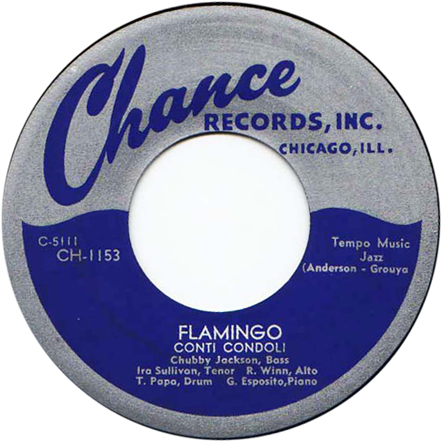
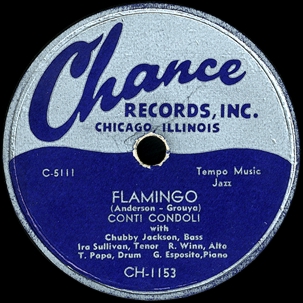
A further jazz venture took place in June, when Sheridan took advantage of a brief Chicago residency by bebop trumpeter Conte Candoli (misspelled "Conti Condoli" on the label). Born in Mishawaka, Indiana, on July 22, 1927, Candoli was already a veteran of the Woody Herman, Charlie Barnet, and Stan Kenton bands, as well as Charlie Ventura's combo. Candoli's main inspiration was Dizzy Gillespie, though later on he would work in what he'd learned from Miles Davis and Clifford Brown. For Chance, Candoli recorded his regular group: Bob Wynn (alto sax), Ira Sullivan (tenor sax), Gene Esposito (piano), Chubby Jackson (bass), and Tony Pappa (drums). Multi-instrumentalist Ira Sullivan (born March 1, 1931 in Washington DC) made his recording debut on this session. He would become one of the most prominent white jazz musicians in Chicago during bop and postbop times. Gene Esposito (1928 - 1999), whose tune "Mambo Junior" appeared on the combo's Chance release, would go on to organize the pioneering 1956 session that brought together Ghanaian drummer Guy Warren and local drumming legend Red Saunders. In 1957, Esposito's trio would cut an LP for Salem. Tony Pappa came from Elkhart, Indiana; in 1948 he'd led a bop quintet that included Chicago tenor saxophonist Kenny Mann.
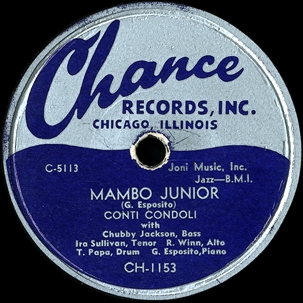
Although four tunes were recorded, just one single (Chance 1153, held till the next year) saw release from the Candoli session; it was reissued many years later on an IAJRC LP. Candoli moved to Los Angeles in 1954 and spent the rest of his career there.He recorded countless studio sessions and for many years reached his widest audience as a soloist with Johnny Carson's Tonight Show Band. Conte Candoli died in Los Angeles on December 14, 2001.
The Four Bits were a vocal group that recorded four tunes at some point in the Summer of 1953. They picked a commonplace name for a quartet. Otherwise we merely know their first names were Stu, Stan, Bill, and Bart, and both of the songs that were released were written by one D. Norwood. Their only single was Chance 3003.
In 1956, a group called the Four Bits released a single on a Miami label. On Art 160, both tunes were credited to Watson, Evans, Cary, and Zadeh. (There was a previous Art single, 116/118, of unknown date, credited to Sparky with Ben Tracey and the Four Bits.) In the 1960s, a group called the Four Bits released a musical comedy album on the same label, Art ALP-31. The lead vocalist (and saxophonist) on the Art LP was Bill Cary and the pianist was Stuart Douglas Watson. The other two members were Al Deet and Curt Law. Allowing for two personnel changes, could this have been the same group? Around 1970, the Florida Four Bits, with one further personnel change, put out a second LP. Obviously further investigation is needed.
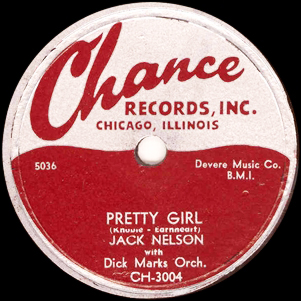
Jack Nelson is another vocalist of whom we know hardly a thing. The matrix numbers put his recording session in the summer, but his one Chance release, on 3004, came out in October. As with some of the company's other releases that fall, there wasn't much of a push behind it. Cash Box (October 10, 1953, p 12) merely declared, "Art Sheridan out with a pop, 'Pretty Girl,' as sung by a Chi boy, Jack Nelson." Bob Rolontz, "Rhythm & Blues Notes," Billboard, October 24, 1953, p. 61, led off with an announcement that Chance had signed The Moonglows, then appended a reference to "a new artist," Jack Nelson, whose single "was released recently." No ads, no reviews on Chance 3004. His name makes the singer hard to research. In those days several Jack Nelsons in Chicago interested the trade papers, including one who was prominent in the vending machine business. A Jack Nelson sang with the Dick Jurgens Orchestra in 1946—maybe not the same guy.
All we know is that the Jack Nelson from Chance resurfaced in 1957 with two singles on Norman Forgue's Stepheny label. "Pretty Girl" (still credited to Knoble and Earnhart) had to be his signature tune, because he redid it for Stepheny. The other sides he did for Stepheny were Country material, on which he was quite effective. Stepheny Records didn't give Nelson real promotion, either. So far as we know the Stephenys were his last recordings.
Accompaniment on Chance 3004 (see also the composer credit on "Many Tears Ago") was by the Dick "Marks" Orchestra. This was a misspelling for Dick Marx, a jazz pianist then active on the Chicago scene. Richard Henry Marx was born in Chicago on April 24, 1924 and graduated from Sullivan High School. He played the piano from childhood, began performing in public at the age of 13, and did a lot of club dates in the 1950s; in 1952 he started a long collaboration with bassist Johnny Frigo. In January 1953, the Dick Marx Jazz Trio was at the Blue Angel, playing in the lounge and on stage. Marx and Frigo had an extended run at the Lei Aloha in 1953-1954, where they backed Lucy Reed. In November 1954, they moved to the Cloister, where Lurlean Hunter was one of the featured vocalists. In February 1955, they were playing Mondays and Tuesdays at the Cloister as a duo; as of February 23, for the other five days, the club was featuring Lurlean Hunter and Sylvia Sims, accompanied by Claude Jones and Ace Harris (Cash Box, February 26, 1955, p. 29). In May Marx and Frigo were still at the Cloister (Cash Box, May 7, 1955, p. 7); Lurlean was still there, too.
Chance 3004 looks to have been the second record with Marx's name on the label. In June 1953, Mercury 71063 by Jim Lowe was released: "Gambler's Guitar" b/w "The Martins and the Coys." Accompaniment was credited to the Dick Marx Quintette. The Quintette would also back Lowe on "Santa Claus Rides a Strawberry Roan," one side of Mercury 70265 (November 1953). In June 1954, having gotten the attention of Mercury, Marx did a single for the label with Mike Simpson (who would work with him again on pop music dates), Chubby Jackson, and Red Saunders; this time record company went with the "Marks" spelling.
We know we haven't caught up with all of Dick Marx's mid-1950s appearances on singles. One was done in 1955 on a short-lived label called Arnett, credited to Kyle Kimbro with Dick Marx and Orchestra. Another we recently ran into was Salem S1002, a 1957 recording by the Off-Beats "with Dick Marx Orch." One side was sort of jazz and the other was sort of rock and roll. Marx was surely called upon to accompany additional vocalists and vocal groups.
Marx went on to record four LPs under his own name (one for Brunswick in 1955, two for Coral in 1957, and one for Omega in 1958). The Brunswick and the first Coral were piano-bass duets with Johnny Frigo (though Frigo switched to violin on a couple of tracks for Brunswick). The second Coral was a trio outing with two different studio drummers. By contrast, the Omega was positively extravagant, featuring a quintet with Buddy Collette on flute and Howard Roberts on electric guitar.
Marx's last appearance for Coral, on a 1958 LP, was as a member of The First Modern Piano Quartet (literally, four pianos): Marx, Hank Jones, Eddie Costa, and Johnny Costa; they shared A Gallery of Gershwin with Manny Albam's orchestra. Marx also made a spot appearance on a various-artists LP that commemorated entertainers of the past: he was tapped to do the Fats Waller tribute.
From their LPs, we hear how Marx and Frigo could play an entire ballad at pp or lower, something that must have been called for while they were working with Lucy Reed. Marx's first Coral LP, released in February 1957, includes two tunes that Reed also recorded on her Fantasy LPs ("In the Wee Small Hours of the Morning" from This Is Lucy Reed and "My Time of Day" from Singing Reed); we don't know who brought them to whose attention.
Marx also appeared on LPs by Johnny Frigo (for Mercury in 1957, featuring Frigo's violin) and by Helen Merrill (for EmArcy). He even showed up on two featuring beat poet and "word jazz" artist Ken Nordine (for Dot). We've found ads from live appearances as late as 1959, but all of this activity was basically over by the end of the year. In 1960, a former student of Marx's complained of visiting Chicago and discovering that his mentor was no longer appearing in the jazz clubs. By that time, though, Marx had taught quite a few musicians, including avant-garde pianist Burton Greene.
The notes to Marx's Omega LP (recorded in Los Angeles) mention a factor that prevented him from becoming a bigger name—his aversion to road tours. An item about Marx traveling to Las Vegas in 1956, to accompany singer Dorothy Collins, pointedly noted he was bringing his family with him. (Collins, the featured singer on Your Hit Parade, was married to experimental composer Raymond Scott, the show's music director; Scott had recommended Marx for the gig.)
Meanwhile, Marx continued his involvement in pop music. In 1957, Coral used his quartet on an LP by pop singer Johnny Desmond (born Giovanni Alfredo De Simone, 1919-1985); the title song, "Easy Come, Easy Go Lover," was also in Lucy Reed's repertoire. Desmond had some jazz experience, as a member of Bob Crosby's Bob-O-Links in 1940 and Gene Krupa's band in 1941. After a long run as a pop artist, Desmond was in decline commercially, 1957 being the year of his last hit single. His record company may have been experimenting. In 1958, a Dick Marx Quartet (with Mike Simpson on flute, Johnny Frigo, and Jerry Slosberg at the drums) backed singer Marlene Cord on a Coral LP; reissued on a Japanese CD, it is well worth a listen. In 1960, Billboard noted that Dick Marx had accompanied pop singer Bet E. Martin on an LP session for Epic, but to our knowledge the tracks were not released. (On Martin's Epic singles that we have seen, the band was led by another Chance pop series alumnus, Chuck Sagle.) Bet E. Martin had studied voice in Chicago with Russell Brooks (Vic Short's column, The Suburbanite Economist, September 28, 1960, p. 18). She was on Bert Parks' TV show when the item ran; over the next couple of years, she spent some time in Ted Lewis's revue and the rest touring as a cabaret singer.
Marx would make his last appearance on a jazz album in 1962, when he provided the string arrangements for Eddie Harris Goes to the Movies (Vee-Jay SR3031). As of the previous year, his main concerns were radio and TV advertising. He started Dick Marx and Associates and wrote jingles for Ken-L-Ration dog food, Doublemint gum, Dial soap, and Kellogg's Raisin Bran. He moved to Los Angeles in 1981, doing some film and TV scores and some arranging for pop singers. His youngest son, Richard Marx, born in 1963, is a pop singer/songwriter. In July 1997, Dick Marx was badly injured in a car wreck in Las Vegas; on August 12, he died in Highland Park Hospital (Kenan Heise, "Top Jingle Writer Dick Marx, 73," Chicago Tribune, August 15, 1997, http://articles.chicagotribune.com/1997-08-15/news/9708150244_1_mr-marx-richard-marx-jingles).
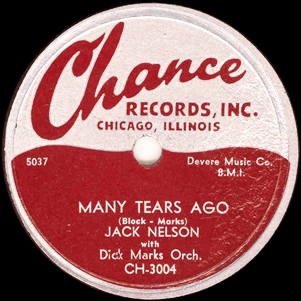
The 3000 pop series ran a regular schedule of new issues in 1953. But even with three series, the parent label no longer seemed to be enough. Sabre was launched at the end of July 1953 with headquarters at 1225 East 47th Street (we are not sure how long they remained separate from Chance's). The first two releases were duly promoted in Dave Clark's "Rhythm and Blues Tattler" (Billboard, August 1, 1953, p. 38). Initial Sabre 78s sported distinctive green labels with silver print; the 45s used the same black on yellow as their counterparts in the Chance 1100s.
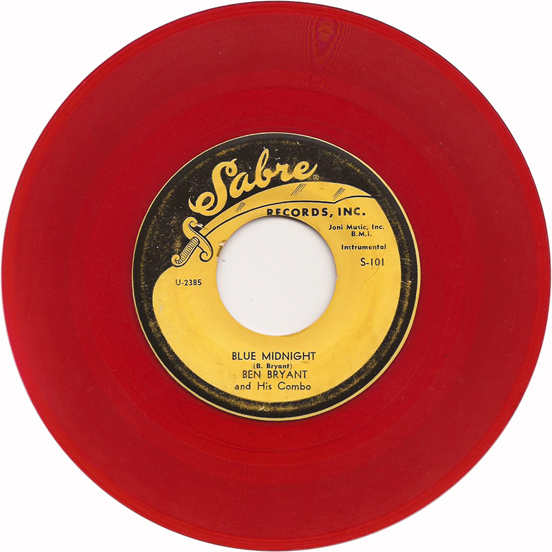
Alongside the "Jimmy Eager" on Sabre 100 (see above; inadequately briefed on his pseudonyms, Clark attributed the single to one "Ken Eager"), there was a release by Ben Bryant on Sabre 101, which seems to have sold hardly a lick. The 78 goes for high prices when a copy hits the market today and we know of exactly one copy on 45. Clark refers to Bryant's "tenor horn," implying a session of R&B instrumentals, and, sure enough, a repro EP (Lloyd's 100, not a genuine product of the Apollo subsidiary, which couples two vocal group tracks with two instrumentals, all from different labels) gives us a quintet, with a trumpet (recessed on "Blue Midnight"), a bar-walking tenor sax, piano, bass, and drums. Obviously this was a group worth listening to, but we don't know of anything they did beyond this session.
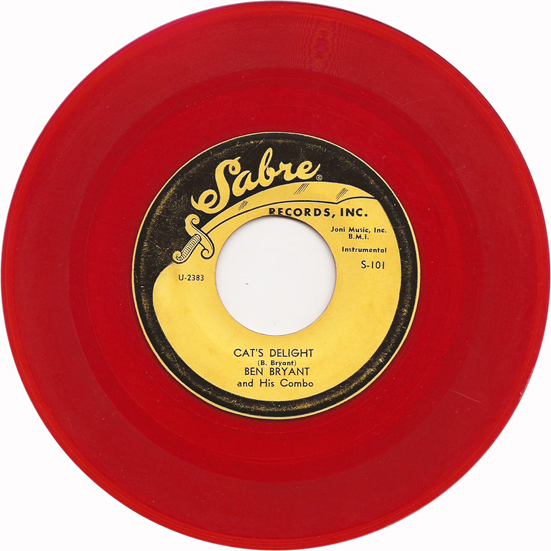
Chance relocated its main offices at 1151 that same month, to next door at 1153 so the company would have double the space. Sheridan also began working with Vee-Jay Records, which had just set up shop and had two releases out, one by the the doowop group the Spaniels and one by the bluesman Jimmy Reed. The company was owned by two neophytes, Jimmy Bracken and Vivian Carter, who had no distribution and little knowledge of the business. When the Spaniels' record, "Baby It's You," started generating interest, Chance picked it up for national distribution and it became a top ten R&B record. (See our final section, on Leased and Purchased Material, for the Chance versions of the first two Vee-Jays.) The Jimmy Reed disk, "High and Lonesome" b/w "Roll and Rhumba," also saw some local action, and picked up national sales as well from its Chance distribution. Thereafter, Sheridan and Abner worked closely with Vee-Jay in getting it off the ground. However, Vee-Jay would continue to be little more than a mom and pop operation through the first half of 1954.
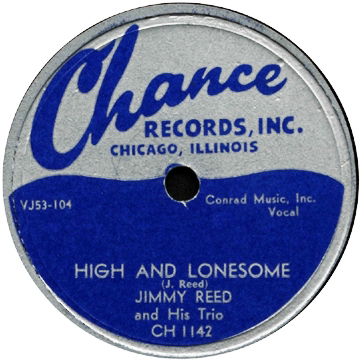
An August recording session brought the Flamingos into the studio again with the Red Holloway band (including Louis Carpenter, piano; Hawk Lee, bass; Robert "Hendu" Henderson, drums; an unidentified trumpeter, and the ever-reliable Mac Easton on baritone sax). The best of the four titles recorded at the session was "Golden Teardrops." The beauty of this song is marvelously enhanced by the intricate harmonizing, especially the way the voices are dramatically split in the intro and the close. McElroy's impassioned vocalizing helps immeasurably in giving "Golden Teardrops" its reputation as a legendary masterpiece. The company rushed released it the following month and it sold well by Chance's standards, although not making the national charts.
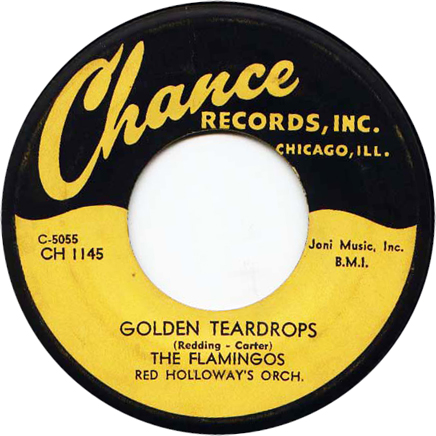
Also in August, Chance recorded another James Williamson session (which, despite the quality of the sides included, remained in the can).
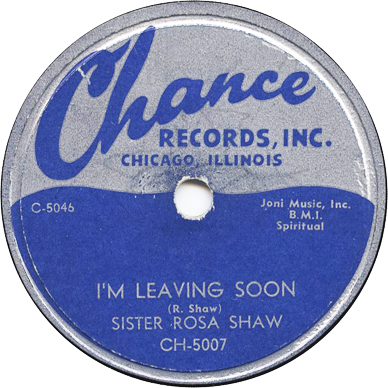
Sister Rosa Shaw made a session that produced two releases for the company's 5000 series, plus two more items that were left in the vault. After Al Trace and Jack Teter we figure she was the third-oldest headliner to record for Chance. Rosa Shaw was born in Bishopville, South Carolina, on February 21, 1909, the daughter of Maggie and Pernell Slater. Her family moved to Tampa, Florida, where she owned a beauty salon and a restaurant before becoming an evangelist. We haven't located a newspaper reference to her gospel singing until she was 35. Sister Rosa toured with her mother, by then known as Maggie Hines, and on various occasions with gospel luminaries such as Sister Rosetta Tharpe, Mahalia Jackson, James Cleveland, and the Soul Stirrers. She claimed that Sister Rosetta Tharpe bought her her first guitar, and she obviously took Sister Rosetta as her model vocally. Touring with their mothers was another thing the two Sisters had in common. A tough-sounding singer, Rosa Shaw makes a strong impression on today's listener.
Her first session was done around February 1948 for Coleman Records in Newark, New Jersey, singing with her guitar for accompaniment (and hence unlikely to attract attention from the Musicians Union). Two singles ensued. On November 6, 1949, identified as "Sister Rosa Shaw of Tampa, Fla.", she made an appearance at the Gospel Train concert held at the Rockland Palace for Benjamin Davis, a left-wing Democrat then serving on the New York City Council. The event was organized by Paul Robeson, and also featured Gene "Gatemouth" Munford, The Two Gospel Keys, the Harmonizing Four, and the Mount Lebanon Jubilee Singers. Sister Rosa was accompanied by Brownie McGhee on guitar ("Paul Robeson Heads Nov. 6 Gospel Sing," The New York Age, October 29, 1949, p. 2). We learn from a 1950 article that Sister Rosa was represented for a time by the same New York booking agency as Sister Rosetta Tharpe and several of her close associates, such as Madam Marie Knight and organist Jimmy Roots, Jr. ("Taps Agency Is Recognized Leader in Bookings of Gospel Singers," The New York Age, May 13, 1950, p. 15). The connection had gotten her a one-time deal with Coral (a subsidiary of Decca, where Sister Rosetta had been recording for years). Sister Rosa cut two singles on May 1, 1950; Coral 65036 was out in August (catching a review in Billboard on August 26, 1950, p. 107). The sales did not lead Decca to extend her contract. Meanwhile, Sister Rosetta left Taps later in 1950. In January 1951, Tharpe signed with Moe Gale, who had a lot more clout in the music business ("Rosetta Tharpe Inks Gale Pact," Cash Box, January 27, 1951, p. 14); she didn't bring Sister Rosa with her.
In 1952, Rosa Shaw signed with Dot. At her first session, around February of that year, she cut 6 sides, all of them released: Dot 1100, 1116, and 1134. The only one easily obtained today is Dot 1134 ("On the Highway" b/w "He Rolled the Stone Away"). Accompaniment there is by piano and her guitar; the balance favors the pianist. "He Rolled the Stone Away" is her only record to have drawn any reissue interest. At a second session for Dot, she made two more titles, which were released on Dot 1170. By this time, however, Dot had several artists whose records were selling. None of them were in the gospel field, which Dot quickly got out of.
A few months before her Chance session, Sister Rosa made a round of appearances in Florida. She was identified as a Dot recording artist and several of her titles were mentioned. Her group, billed as the Singing Angels, included her mother, a male singer identified as Little Sammie Hines, and "Prof. Jones, blind pianist and gospel singer of Chicago" ("Rosa Shaw Will Be at Masonic Temple," Fort Pierce News Tribune, March 8, 1953, p. 12).
We presume she signed with Chance after a one-year deal with Dot expired. On 5007, the more common of her Chance releases, "His Dying Was Not in Vain" features an unidentified, fluent pianist along with Sister Rosa's well-miked guitar. On "I'm Leaving Soon," there is no piano; she accompanies herself on tremolo-laden electric guitar, with wordless backing from a recessed vocal group. The suggestion has been made that these were The Five Echoes, but rather obviously they are the other members of Sister Rosa's entourage: Maggie Hines, Little Sammie, and the pianist. Chance 5007 got a prompt release in October 1953; so far as we know, all copies have the silver on blue label.
For nearly a year, Art Sheridan was too busy with other projects to pay further mind to the Chance gospel series. Chance 5008, with the black on off-white label, was released nearly a year after the session, in the last big batch of releases from a company that had quit doing much to promote any of them. Chance 5008 was reviewed in Billboard on August 7, 1954 (p. 41). Hayes and Laughton add a drummer to Chance 5008, but careful listening reveals only the guitar (amplifier settings varying a lot from take to take) and the piano. The wordless chorus is present on both sides.
The identity of the pianist on Rosa Shaw's Chance session is of more than casual interest. First, because the pianist is obviously very good. Second, because she might have still been working with Prof. Edward Jones, who was said to be from Chicago. Or she might have changed pianists. In his 1984 autobiography Little Richard told the following story about a fateful meeting with Steven Quincy Reeder, Jr. (1935-1986; also known as Eskew Reeder, Jr., S. Q., Esquerita, and eventually several other names). As best his biographers could determine, the meeting took place in the middle of 1953: "I used to sit around the all-night restaurant at the Greyhound bus station in Macon [Georgia]. One night, I was sitting there and Esquerita came in. He was with a lady preacher by the name of Sister Rosa Shaw, whose line was selling blessed bread. She said it was blessed, but it was nothing but regular old bread that you buy at the store. Esquerita played piano for her and they had a little guy singing with them by the name of Shorty" (quoted by Pierre Monnery with Jay Halsey, "The Esquerita Story," Blues & Rhythm 270, p. 12). Little Richard talked about how strong Reeder's bass line was when he played "One Mint Julep" on the piano at the Penniman home.
A blurb for a later appearance in Fort Pierce ("Sister Rosa Shaw Is Here Today at Masonic Temple," Fort Pierce News Tribune, February 6, 1955, p. 4) mentioned that Mrs. Maggie Hines would be on the bill along with "Samuel, the world's little wonder boy," who was said to be 2 1/2 feet tall and 25 years old. "Also playing a prominent part on the program will be Eskew Reeder, Jr., recognized as a piano magician."
Rosa Shaw eventually settled in Miami, Florida, where she did broadcasts for more than 50 years over WMBM radio (it renamed its studio building after her in 2004) and maintained a prayer circle in her home. She became Madame Rosa Shaw, Evangelist Rosa Shaw, finally Mother Evangelist Rosa Shaw. She kept working in New York and New Jersey and had one later release out of New York City, a 45 released in 1962 on Rae Cox 103, as Evangelist Rosa Shaw. At an unknown date, she also released a 45 rpm single on her own label, RS, as Evangelist Rosa Shaw. The Miami Times interviewed her for her 105th and 106th birthdays (Gigi Tinsley, "The Rosa Shaw Story," The Miami Times, February 27, 2014, https://www.miamitimesonline.com/faith_family/the-rosa-shaw-story/article_0f507a74-9098-11e6-bf06-10604b9ffe60.html; Gigi Tinsley,"'Mother' Rosa Shaw Celebrates 106th Birthday," The Miami Times, February 11, 2015, https://www.miamitimesonline.com/faith_family/mother-rosa-shaw-celebrates-th-birthday/article_e0d88a2e-9097-11e6-b4e8-10604b9ffe60.html. Mother Rosa Shaw died on July 7, 2015 (http://miamitimesonline.com/obituaries/2015/jul/16/mother-rosa-shaw/), leaving two sons and an adopted son, Willie Williams, who had accompanied her on piano for many years.
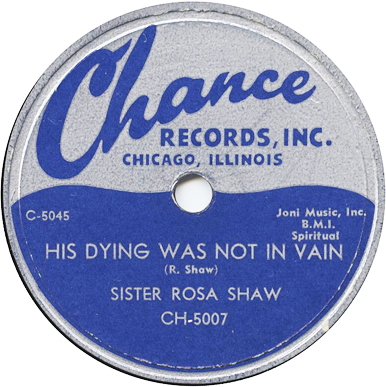
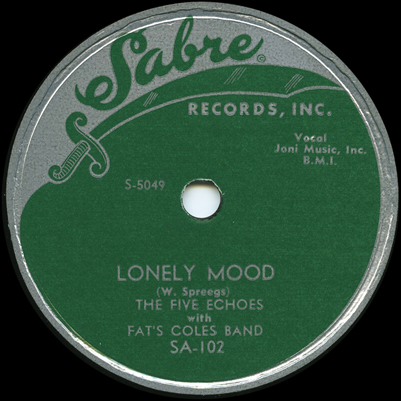
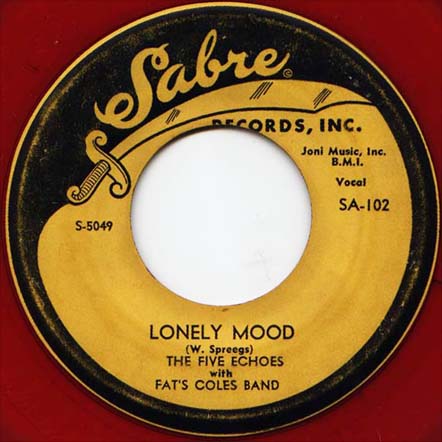
The Five Echoes, from the city's South Side, were teamed up in the studio with a band led by pianist Ike "Fats" Cole. The Echoes were the company's second vocal group. The Echoes' first record, "Lonely Mood" b/w "Baby Come Back to Me," was released on Sabre 102 in September of 1953. Solo artist Walter Spriggs sang lead on both songs, which for that matter were credited to "W. Spreegs." We've been told he was a member of the group only for the session; nope, Spriggs was back for the second session. Constant "Count" Sims sang baritone for the Echoes; Herbert Lewis, baritone; Tommy Hunt, second tenor; Earl Lewis, first tenor; and Jimmy Marshall, bass. Tommy Hunt would later sing with the Flamingos and develop a solo career in the early 1960s. Two more Echoes sides may have been recorded at this session (they have previously been described as early 1954 recordings, but the accompaniments match what we can hear on the group's first session, not the second.) The company seemingly was trying to get the group away from blues so they had them record a ballad, "Why Oh Why," and a jump, "That's My Baby." Hunt sang second lead on "Why Oh Why." These two songs went unreleased, finally appearing in 1964 on a Constellation LP called Groups Three.
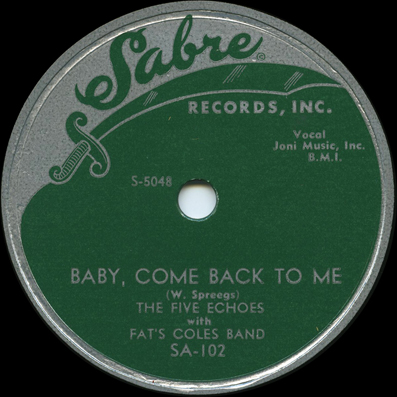
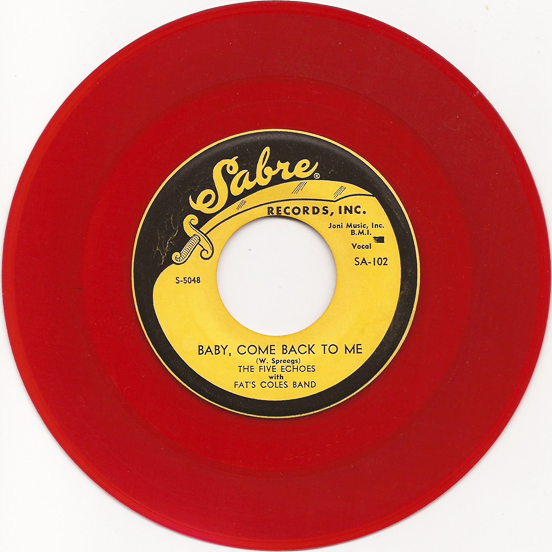
Walter Spriggs' career has drawn little attention. He moved around a lot, and his extensive reliance on pseudonyms has thrown everyone off the trail. From the published information that we have, courtesy of Rob Ford, he is almost certainly the 7-year-old resident of St. Louis, Missouri who was listed in the 1940 US census. That Walter Spriggs was born in Arkansas in 1933, the son of William and Ollie Spriggs, both of whom had been born in 1898, William in Arkansas and Ollie in Mississippi. He had two older sisters, Mary and Geraldine. Where Walter Spriggs got his musical instruction we do not know, but he sang and played piano, guitar, bongos, and drums.
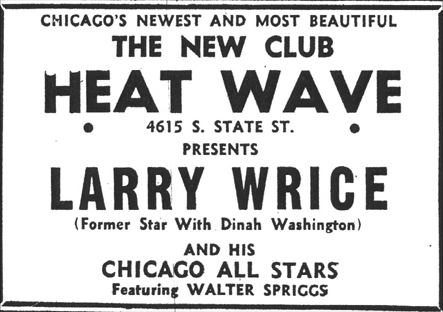
In the fall of 1952, Spriggs was in Chicago: one "Walter Sprague (Blues Singer)" was featured in a show at Martin's Corner, 1900 West Lake Street, accompanied by Deacon Brown's band (Chicago Defender, October 2, 1952). Whether it was before or after the Martin's Corner gig, Walter Spriggs spent enough time in New York City to make a single with the band led by tenor saxophonist Charlie Ferguson. Apollo 445 was released some time during the first half of 1953; Apollo 444 by Billy Austin had been reviewed in Billboard on December 20, 1952 (p. 30). Spriggs returned to Chicago, where he was active during much of 1953 and 1954, as we know from his recording activity for Chance and then Blue Lake. He also got billing in an ad (Chicago Defender, April 3, 1954, p. 24) for Club Heat Wave, 4615 South State Street, where he was working with Larry Wrice (drummer, recent ex-husband of Dinah Washington) and his Chicago All Stars.
Perhaps it was in 1955 that Spriggs began (selectively) using the stage name Raymond Scott. A drummer under that name worked with Jimmy Reed, appearing on Reed and Eddie Taylor's January and March 1955 sessions for Vee-Jay, and an unreleased Little Willy Foster session (June 1955) for Blue Lake. However, Jim O'Neal met the drumming Ray Scott and does not think he and Spriggs were the same person.
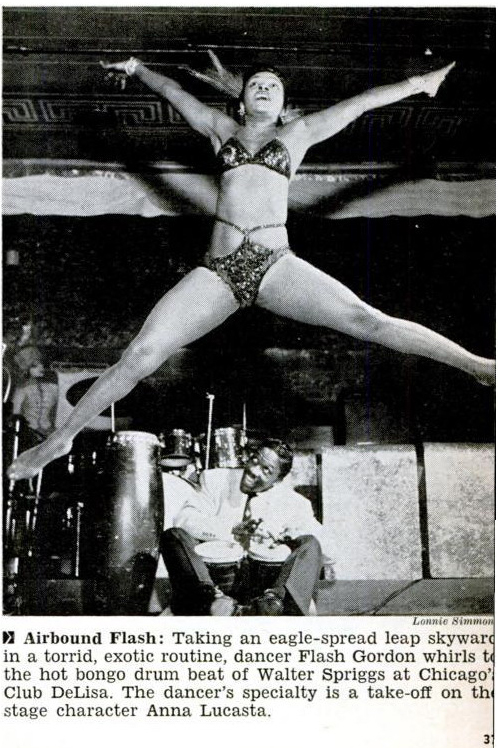
The Scott name might have invited some confusion with the eccentric composer, birth name Harry Warnow, who had previously grabbed it. It invited a lot of confusion with the blues drummer, also active in Chicago, who ended up as "the other Ray Scott."
Spriggs, using his real name, joined the Kansas City Tomcats (led by guitarist Lucky Enois), a group that toured widely and recorded for Josie in New York City. His role in the Tomcats was lead vocalist (see http://doo-wop.blogg.org/kansas-city-tomcats-c28921836). Cash Box ran a picture of the group on October 22, 1955 (p. 28), with a blurb about their lightning signing by Jubilee/Josie's A&R man (Billboard announced the signing on October 29, p. 24). Josie 786 by the Tomcats was advertised in Cash Box on November 5, 1955 (p. 23). It was reviewed in Billboard on November 19, 1955, p. 50, and in Cash Box on November 5, 1955, p. 30). It didn't sell anything like Josie 785 by the Cadillacs... A second Tomcats single, Josie 797, was released around June of 1956 and was not covered in the trades.
Returning to Chicago, Spriggs/Scott ran Scotty's Rock and Roll Inn from some point in 1955 through 1957. There he led a house band that included Luther "Guitar Junior" Johnson. But it was the blues drummer Ray Scott who appeared on Little Willy Foster's session for Cobra (c. March 1957). And it was the other Ray Scott who inadvertently precipitated Elmore James' years of trouble with Local 208 in December 1957, when he recommended Junior Blackmon as his immediate replacement on the bandstand; Blackmon turned out not to be a member of the Union. Spriggs nonetheless retained some affiliation with Chicago blues performers; in 1959 Little Walter Jacobs recorded his song "Nobody but You."
On August 4, 1956, Spriggs recorded a single for Atco, in New York with Jesse Stone's band; it was released in September. Atco 6078 (advertised in Cash Box on September 29, 1956, p. 34; reviewed in Billboard, October 6, 1956, p. 85) carried the name Walter Spriggs. He would continue his association with Stone for a few years, with a second Atco release coming out in March 1958. Atco 6112 was included in a company ad in Billboard on March 17, 1958 (p. 18) and reviewed in Cash Box on March 29 (p. 44). In 1958 and 1959 Spriggs spent more of his time in New York. Hedging his bets, he recorded twice in 1959 for a small label called Antler; one single came out under the Spriggs name, the other under the Scott name. The Ray Scott 45 (Antler 1104 was reviewed in Cash Box on April 18, 1959, p. 58) included a side with a composer credit to Spriggs. Meanwhile, one of the Spriggs sides was a Jesse Stone tune. In 1960, Ray Scott and combo put out a single on the Tri-Ess label, featuring "Silk, Satin & Lace" by Jesse Stone. Tri-Ess, for that matter, sounds like a joint enterprise of Spriggs, Stone, and someone else whose last name started with S.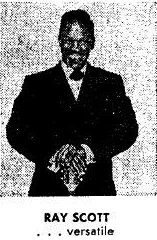
Scott/Spriggs spent a little time in Los Angeles, garnering a writeup in the LA Sentinel. (Paul McGee, "Success Beckons: The Great Scott — Portrait of a Man in a Hurry...!" May 30, 1963, p. A-8, A-9) that helped us resolve the confusion over his identity: "Ray Scott, versatile singer, dancer, musician and comedian, who was christened Walter Spriggs," was now aged 29, and was born in Arkansas. According to the McGee piece, Scott had arrived in LA from New York City for a comedy gig at the Club Hideaway. He had begun billing himself as "The Great Scott." Spriggs/Scott had been doing comedy since 1959, and was said to know George Kirby and Redd Foxx, both of whom he would have had multiple opportunities to meet and observe in Chicago. His most recent recordings were mentioned, including "Silk, Satin & Lace." he article credited him with playing bongos on a Roy Hamilton song and with further recording work with Billy Williams and Johnny Ray, as well as "a tour of 27 countries of Europe." Of course, had Scott landed his own TV show or been in films, we would have heard more from other sources.
The gig at Club Hideaway and the piece in the Sentinel did Spriggs/Scott some good, because on July 7, 1963, Cash Box (p. 41) ran a photo of him signing with Dooto, as Dootsie Williams looked on. "Scott joins the large label roster of laugh-men which includes Redd Foxx, Hattie Noel, George Kirby, Dave Turner, Don Bexley and others." Dooto was releasing a lot of raunchy comedy in those days. Though we have not researched all of Scott's comedy releases, we can report that on November 23, 1963, Cash Box ran an ad for Dooto 837, "Sex Is Funny" (p. 31).
In 1970, Checker released a single by Ray Scott. One side of Checker 1234, "The Prayer," is a Redd Foxx bit, which points to "our" Ray Scott. The other side, "Lily White Mama, Jet Black Dad" was credited to Andre Williams, who produced the session. The last sighting we have is from New York once again, in 1974. Ray Scott was running a music publisher called Spriggs Productions, Inc. (affiliated with BMI) out of his apartment at 400 Central Park West. When Jim O'Neal encountered that Ray Scott, a little later, he was opening for Johnnie Taylor in Chicago (and serving as MC). O'Neal, who verified that Scott's real name was Walter Spriggs, was unable to catch up with him for an interview, but Spriggs/Scott was living in Texas at the time.
Walter Spriggs was a performer of multiple talents who never got the big break he was expecting. We're pretty sure his activities in show biz are still not fully documented.
In September Art Sheridan went into a partnership with Dave Freed, the brother of Alan Freed. They opened Lance Distributing, with offices on Prospect Street in Cleveland (Cash Box, September 19, 1953, p. 17). In December, Lance acquired Specialty, a label Sheridan had been distributing in Chicago since the end of 1949 (Cash Box, December 6, 1953, p. 17)
That same month, Alan Freed brought the Moonglows (Bobby Lester, Harvey Fuqua, Pete Graves, and Prentiss Barnes) to Sheridan. For the first session, Chance teamed the doowop group up with another Red Holloway band (this time just Carpenter, Lee, and Henderson behind Red's tenor sax.) The Moonglows recorded two secular titles and two Christmas titles for the holidays. For their first release in October Chance paired the secular titles, "Baby Please" and "Whistle My Love." The top side led by Harvey Fuqua is a low-key bluesy ballad, and the flip, featuring a duet lead of Fuqua and Bobby Lester, is a steady rocking jump. Neither side did anything in the market despite heavy promotion by Freed in Cleveland.
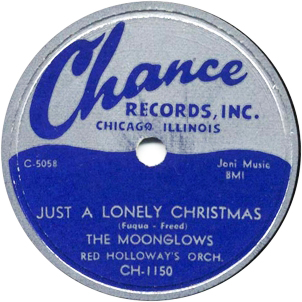
In December, Chance put out "Just a Lonely Christmas" b/w "Hey Santa Claus." "Lonely Christmas," led by Fuqua, is an Orioles-style droopy ballad that appeals to the collector's ear today. "Hey, Santa Claus," led by Lester, is a routine jump heavily derived from the old rhythm and blues tune "Be Baba Leba," made famous by Helen Humes back in 1945. Neither side is all that Christmasy and it was obvious that Gene Autry or Charles Brown had nothing to fear from the Moonglows. "Hey Santa Claus" made a surprise appearance many years later on film, on National Lampoon's Christmas Vacation. Chevy Chase looks across the street and there's a black band playing and singing "Hey Santa Claus" (actually lip-synching to the Moonglows' original).
The company carried on a heavy recording schedule in October, recording bluesman Willie Nix, guitarist Rudolph Spencer "Rudy" Greene, Lazy Bill, and singing actor Eddie Bracken.
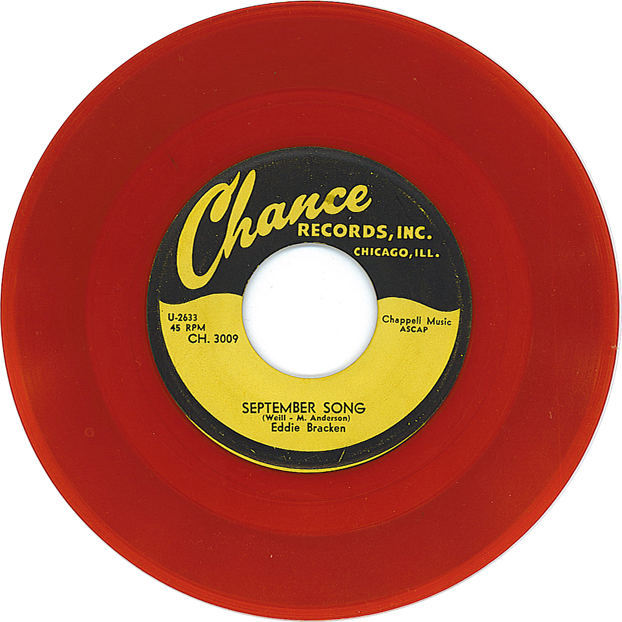
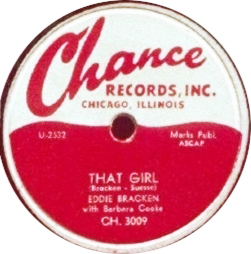
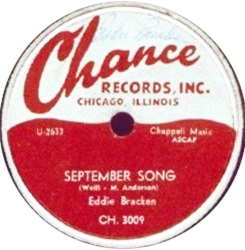
Eddie Bracken (not related to Jimmy) had the most widely recognized name in the Chance pop series, though he'd made his reputation more as a comic actor than as a singer. Born Edward Vincent Bracken in Astoria, Queens, on February 7, 1915, he was working in vaudeville at age 9, in stage plays at age 15, and got his big break with the Rodgers and Hart musical Too Many Girls (1939), introducing "I Didn't Know What Time It Was." He moved to Hollywood when the musical was made into a film in 1940. He appeared in two of Preston Sturges' movies and had his own radio show for a time. A small record label would not normally have been able to sign him, but in September 1953 he had left Hollywood and was appearing in Chicago in a stage production of "The Seven Year Itch," a comedy that had been a hit on Broadway. Art Sheridan jumped on the opportunity. Sheridan told Cash Box (December 26, 1953, p. 14) that Bracken was recording for him. As usual, the session had already taken place, we estimate in October or November (after the Memphis Minnie session for JOB, made while Sheridan was still collaborating with Joe Brown).
Sheridan had hopes—Bracken got a 4-tune session leading to immediate releases with contiguous numbers, Chance 3009 and 3010, which at one time were meant to be put together as an "album" (OK, an EP). Bracken rewrote the lyrics to "The Girl without a Name," which had been used in the original New York production ("'Seven Year Itch' Tune Clicking in Chicago," Cash Box, March 6, 1954, p. 22). He had to get permissions from the composer and the original lyricist for his version on Chance 3009, which was titled "That Girl" and done as a duet with Barbara Cooke (the permission process is what seems to have delayed the release). It appears that a lot of the retail on Chance 3009 was being handled by Eddie Bracken himself: "At present more than 300 copies [of the sheet music?] and records a week are sold with Eddie Bracken autographing in the lobby of Chicago's Erlanger Theatre" (Cash Box, March 6, 1954, p. 22). The show closed on May 22, after 35 weeks, but Bracken continued with the road company for a while longer. Did he bring more records along with him?
For Chance 3009, we have seen 45s that carry the old silver on red labels and the new black on yellow. Eddie Bracken was signing enough records in the lobby to warrant further pressing runs. We are curious what collectors have to say about Chance 3010, which might not have gotten more than one run.
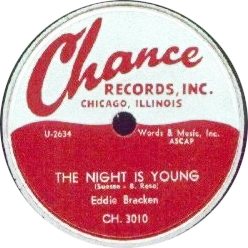
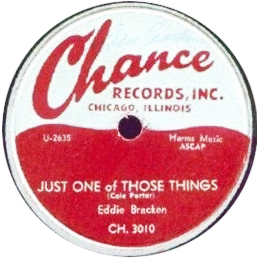
Bracken knew how exactly how well his records were moving while he was in Chicago—and we doubt he missed the few remaining potential sales after the company shut down. It had been a one-off deal. And Bracken was too busy with TV series and more stage acting. In 1954, he co-starred with Carol Channing in a studio production of archy and mehitabel, released on a Columbia LP around the end of the year. It was made into a stage musical in 1957 as Shinbone Alley; Bracken again played the cockroach and Eartha Kitt was the feline. He continued his many activities on TV, in touring editions of Broadway musicals, and other stage productions, and even made a return to film in character roles, retiring in 2001 at the age of 86. Eddie Bracken died in Glen Ridge, New Jersey, on November 14, 2002. (See his obituary in the New York Times (http://www.nytimes.com/2002/11/16/arts/eddie-bracken-dies-at-87-acted-in-sturges-comedies.html, a fairly detailed piece that had no room for his rare forays into commercial recording.)
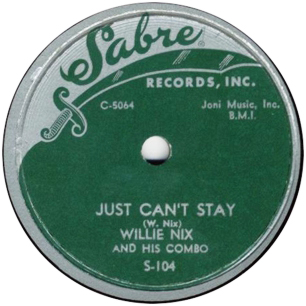
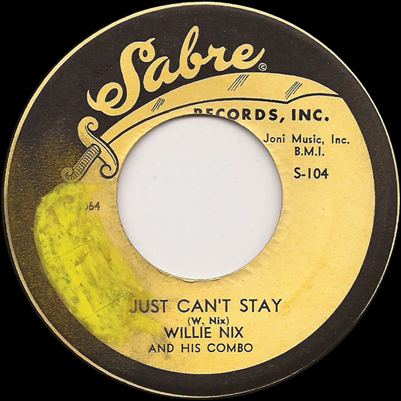
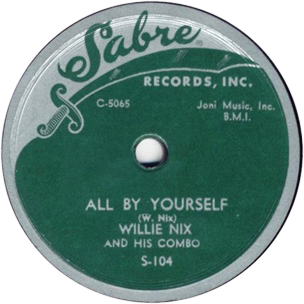
Willie Nix was born in Memphis, Tennessee, on August 6, 1922. He learned tap dancing as a boy, and was appearing with the Rabbit Foot Minstrels in his teens. In the 1940s, he worked as a drummer with bluesmen such as Robert Lockwood Jr., Willie Love, Joe Willie Wilkins, Aleck Miller (aka Sonny Boy Williamson #2), B. B. King, and Joe Hill Louis. He made his first record for RPM, in Memphis in 1951, and in 1952 two of his sides recorded at Sam Phillips' studio were released on Checker; he also appeared on the Chess brothers' session of January 9, 1953 involving, in various combinations, Muddy Waters, Big Walter Horton, Honeyboy Edwards, and Gus Jenkins. Chance was the third record company to sign him as a leader. After the 1950s ended, Nix suffered declining health, performed only sporadically, and became increasingly eccentric in his behavior. He died on July 8, 1991, in in Leland, Mississippi.
Mike Rowe cites the Willie Nix session on October 14th as particularly notable; it produced "Just Can't Stay" b/w "All by Yourself," which saw release in November on Sabre 104. "Just Can't Stay" is a semi-talking blues using the "Catfish" or "Rollin' Stone" theme. As Rowe describes it, "The record is a brilliant updating of a traditional theme of unrequited love to the urban setting with its images of hustlers, whores, and easy money." The band consisted of Nix on drums, Eddie Taylor on guitar, Sunnyland Slim on piano, and Snooky Pryor on harmonica. The other two sides from the session were released on Chance 1163 in November 1954; like other very late releases on the label 1163 is quite rare.
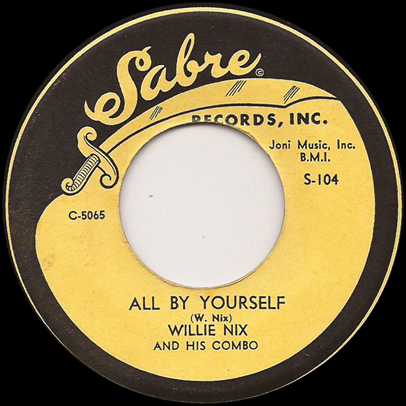
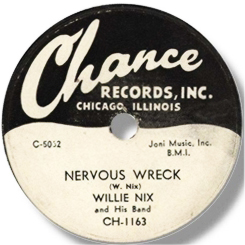
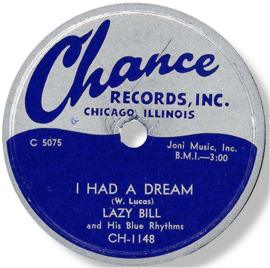
Lazy Bill Lucas was born William Lucas on May 29, 1918, in Wynne, Arkansas, and came to Chicago in 1941 via Cape Girardeau and Saint Louis, Missouri, where he met Big Joe Williams. He worked the club scene semi-regularly from 1945 on. Originally a guitarist, he switched to piano in 1950. Lazy Bill played a pounding style of piano. His Chance sides were his debut recordings as a leader. He displayed a puckish sense of humor on the two sides that were released, as Chance 1148, from his October 28th session, "I Had a Dream" and "She Got Me Walkin."
Bill's backing musicians were drummer Elga Edmonds (known to some as "Elgin Evans") and guitarist Louis Myers. The other two sides, along with alternate takes of "She Got Me Walkin'" and "I Had a Dream," were first released in Japan in 1977, on the awkwardly titled P-Vine Special PLP 707, Chance Vintage Blues/R&B Crops Vol. 3: J. B. Lenore/Sunnyland Slim/Lazy Bill.
Like many other blues performers, Lucas had more and more trouble finding work in the late 1950s and early 1960s. From 1964 onward he worked in a combo led by George "Mojo" Buford or led his own groups. Around 1970 he settled in Minneapolis, Minnesota, where he recorded for a company called Philo and for a time hosted his own radio show. Bill Lucas died in Minneapolis on December 11, 1982.
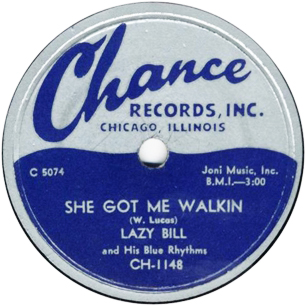
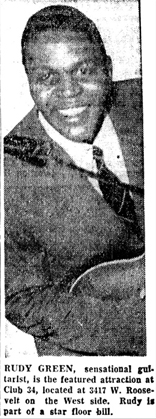
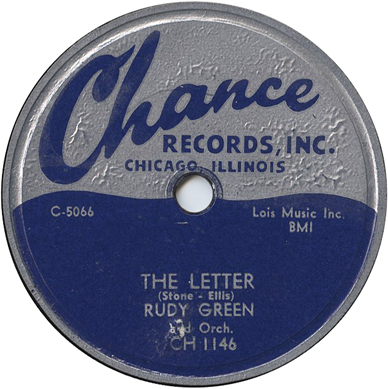
Rudy Greene was another of the many T-Bone Walker acolytes on the scene at the time (in one of two photos we've been able to find, he plays the guitar behind his head in emulation of the master). His first recording was for the Bullet label in Nashville (1947). After his second and last Chance session, which took place on October 19, 1953, he appeared as a sideman on a Bobby Prince date for RCA Victor on December 4. Greene enjoyed a long run at Chicago-area clubs during 1954. In October, duly cited as a "Chance Recording Artist," he was the headliner at Club 34 (3417 West Roosevelt Road), where he was backed by Joseph "Cool Breeze" Bell and his 4 Breezes.
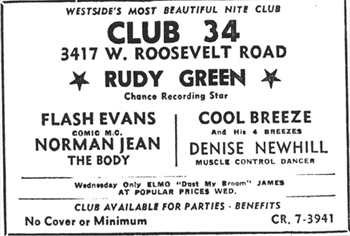
The guitarist would record again as a leader for the tiny Club 51 label in March 1955. Around the end of that year, Rudy Greene was back in Nashville recording for Excello; his latter-day sessions would be done in New York for Ember (1957) and in Nashville for Poncello (1961).
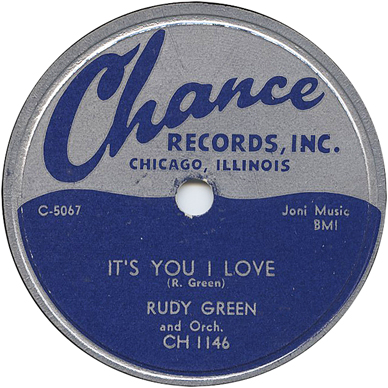
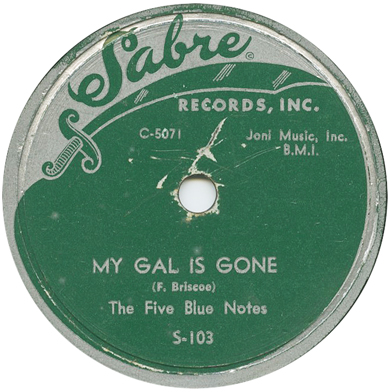
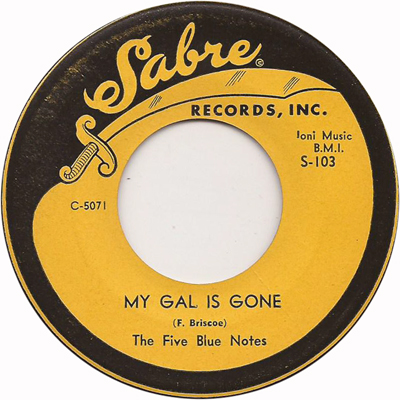
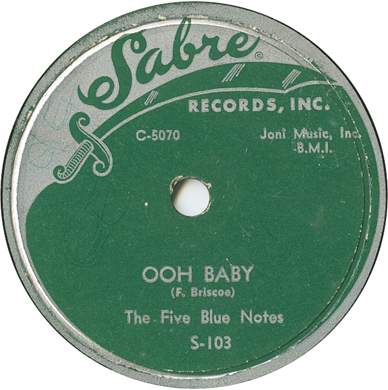
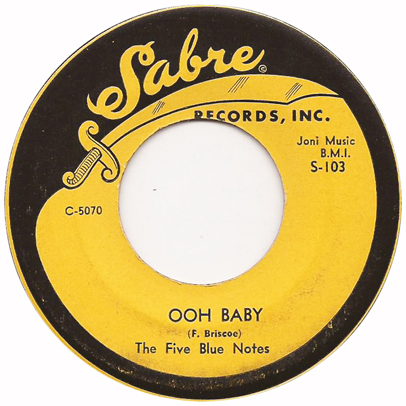
Also recorded in October was another new vocal group from the Washington, DC area, the Five Blue Notes. Original members were Andy Magruder (lead), Waymond Mooney (first tenor), Robert Stroud (second tenor), and Moise Vaughn (baritone/bass). They recorded four sides on October 21, and all were released on the Sabre subsidiary. The first release, on Sabre 103 in December 1953, paired "My Gal Is Gone," a deep brooding ballad typical of the era, which featured Magruder as lead, with "Ooh Baby" a routine jump with Briscoe as the lead. Sabre 108, released around June 1954, paired "The Beat of Our Hearts," a more poppish and accessible ballad featuring Briscoe as lead, with a tuneful jump, "You Gotta Go Baby," featuring Vaughn on lead. The Blue Notes appear to have been backed by another Al Smith group: Red Holloway (tenor sax), the eccentric local pianist Willie Jones (1920-1977), veteran jazz musician Quinn Wilson (born 1908) on bass (once established as a studio bandleader, Al quickly got into the habit of delegating these duties), Lefty Bates on guitar, and Paul Gusman (1929 - ) on drums.
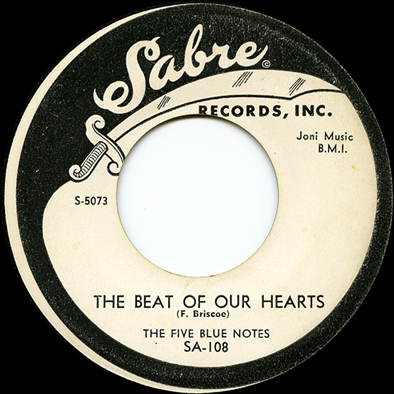
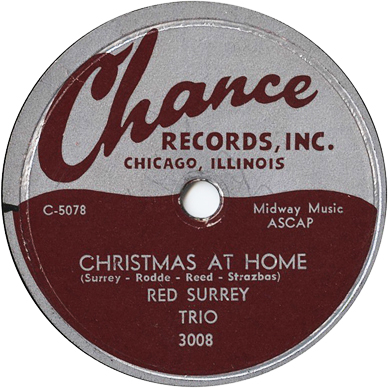
In early November, Chance recorded the Red Surrey Trio for its pop series. The group laid down two holiday-flavored numbers in a style strongly influenced by Nat King Cole. It turns out that both titles were listed by Art Sheridan with the correct matrix numbers, but were misattributed to "Jimmy James" in the Chauvard compilation (we doubt anyone in the trio went by that name). Until Marc Roberts discovered a copy of Chance 3008, we had no way of knowing whether they had been released.
Red Surrey's bandmates were probably Don Reed and someone named Strazbos. To these three, the composer credits to "Christmas at Home" added Roy Rhodde (last name misspelled on the labels). Rhodde was the trio's manager (see the mention of the group's Chance release in Billboard, December 5, 1953, p. 35). Reed was a prolific songwriter who, less than a year later, signed with the West Coast 4star label (Billboard, September 11, 1954, p. 22). His second session for 4star took place at Universal Recording in Chicago, with Roy Rhodde again on hand (Billboard, November 6, 1954, p. 46). We figure he the Don Reed who released a single in 1957 during the last days of United.
Meanwhile, we are pretty sure that the Red Surrey who recorded for Chance is the same Red Surrey who was once married to Jean Dinning (1924-2011). Jean enjoyed some hits in the late 1940s with the Dinning Sisters, and in 1959 she composed "Teen Angel." A recording of it by Jean Dinning's brother Mark was a #1 hit in 1960. While they were married, Jean Dinning and Red Surrey shared credit on anything either of them had composed; after they were divorced, Surrey returned his share of "Teen Angel" to her.
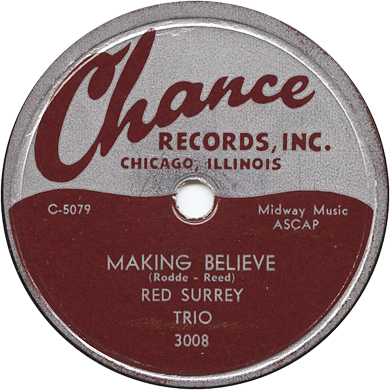
A little out of the ordinary run of Chance pop artists were Eddie and Chuck, the parties responsible for Chance 3012. According to Andrew Brown, they were a Country and Western duo, backed on their sides by a group called The Louisiana Ramblers. Terence McArdle describes "Boogie the Blues" as a "hillbilly bopper" (i.e., an immediate forerunner to rockabilly). Eddie's full name was Eddie Roberts; he released another single around this time on Jiffy Records, out of Monroe, Louisiana. Chuck's last name could have been Wooten. Brown thinks it likely that the Eddie and Chuck material was purchased from a producer in Louisiana rather than recorded in Chicago; in any event, the session was noted down by Art Sheridan with a date of December 22, 1953. (Chance wasn't the only Chicago-area label to release Country material recorded in Louisiana. In 1954-1955, Chess would put out 7 singles in its 4858 series. Stan Lewis, who owned a record store and a distributor in Shreveport, was the intermediary. Leonard Chess was a frequent visitor at Lewis's shop, but so was Art Sheridan.)
Chance 3012 came out in February 1954. It was reviewed in Cash Box on February 23 (p. 30); this would be the only time Chance got coverage in the Country and Western section.
The company was expecting more sales out of Buddy DiVito, and a second session took place in December. This featured an ampler budget: Chance paid for a big studio band with a string section to back the vocalist. It led to Chance 3011 and 3015, which were released in February and March 1954. Chance 3011 featured "Glenn Miller," a sentimental tribute to the bandleader on the 10th anniversary of his death, replete with quotes from the Miller band's most popular numbers; it is a pretty fair representation of DiVito's suave crooning. "If Love Has Flown" is in a similar vein, sappier than the "Who Cares" might have led record buyers to think. The company also paid for an advertisement in Billboard. "Hold Me" uses Swing band instrumentation, but Chance passed over the fourth side from December in favor of "Take My Heart," which comes from a different matrix series, and uses a string section to accompany the singer. Quite likely it was rescued from DiVito's Tower session (but not being sure when and where it was cut—we haven't heard Tower 1508—we've placed it alongside his April 1953 tracks).
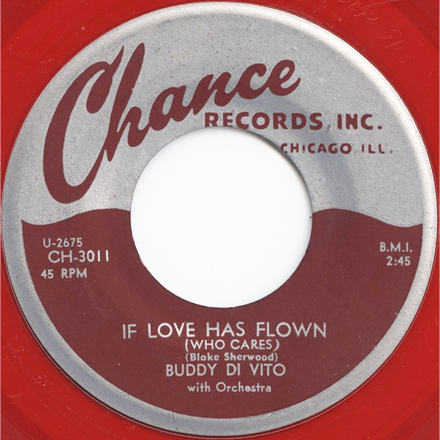
In 1954, after his affiliation with Chance had ended, DiVito put out a single on United. Later that same year, he recorded for a much smaller Chicago-based independent called Trio. In April 1955, he was at the Kentucky Lounge, 6725 South Ashland. The new floor show, starting April 12, featured Buddy DiVito and Dick Gale, with a combo led by Jimmy Nuzzo (Southtown Economist, April 6, 1955, p. 39). In January 1956, DiVito was performing at Mangam's Chateau (Cash Box, January 14, 1956, p. 18). In subsequent years, DiVito moved to Los Angeles. He recorded occasionally for even smaller independents called KM, Tin Pan Alley, and Mal (Mal was probably the last, in 1966). Buddy DiVito died of heart failure on 31 May 2006, in Sun City, Arizona. See Kendrick Marshall, "Anthony 'Buddy' DiVito: Sang with Harry James (Also Did Carpentry)," Chicago Sun-Times, June 23, 2006.
Chance closed out the year with two sessions. First, another by the Flamingos on December 24; the group was backed by an Al Smith aggregation that appears to have included Red Holloway (tenor sax), Mac Easton (baritone), Horace Palm (piano), the great New Orleans-born drummer Vernel Fournier (1928-2000), and renowned lead trumpeter Hobart Dotson (1922-1971). The company held onto the sides for a while, but in October 1954 two were put on one of the very last records on Chance's release schedule: "Blues in a Letter," a stone solid blues, and "Jump Children." "Jump Children" is a terrific number, but it didn't excite the public in 1954. As the alternate title "Vooit Vooit" would indicate, "Jump Children" is too Swing-oriented to suit vocal-group collectors today, but it is typical of the era and the group used the number in their live performances for years afterward.
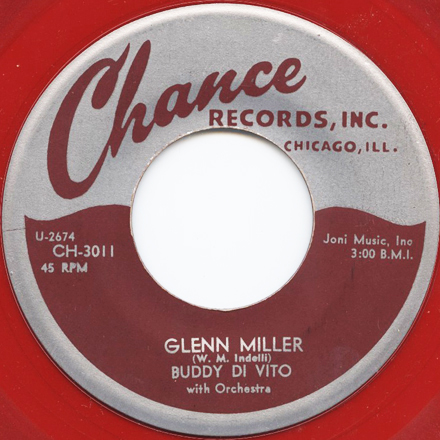
Then there was one that produced a genuine Chance Record curiosity. Chance 3016 is credited on one side to Gerry Teifer (to use the correct spellings). Born Gerald Emmett Teifer in Muskegon, Michigan, on May 28, 1922, Gerry Teifer was a songwriter who initially used Chicago as his base of operations; in 1956, he would move to New York City. He wrote songs for Eddy Arnold, Johnnie Ray, and Doris Day, among others. What got him a recording session for Chance was his skill as a whistler (in fact, he would remake "Tennessee Whistlin' Man" the next year, in a very similar performance with Red Foley for Decca). As Jerry Tyfer, he recorded for a single for Wing in 1955 with a band directed by Chuck Sagle. Teifer was still based in Chicago when he dropped by the Cash Box offices to promote his Wing single (November 5, 1955, p. 16). He related to Cash Box that he had been doing record promotion when a company told him, "You gotta commercial sound. Why not sing 'em yourself!" Wing 90029 was advertised in Cash Box on November 12 (p. 9). Teifer/Tyfer later made two singles for Epic, in 1963 and 1965. Eventually he became an executive in the music publishing business. Gerry Teifer died in Palm Harbor, Florida, on September 20, 2004.
To back Teifer, Art Sheridan brought in Ray Biondi for a second time.
Teifer's side is a Swing boogie with an uncredited vocal and backing by trumpet, trombone, tenor saxophone, guitar, bass, and drums. The trumpet player gets a solo.
The B side, "Pizza-Cat-Oh," was an instrumental feature for Biondi on violin and electric guitar with trumpet, tenor sax, bass, and drums. As with the Chance 3001 session, Biondi did not use a pianist on the date.
Teifer gets part composer credit, but so far as we know he did not play anything. The tenor saxophonist and trumpeter also solo. As with any Ray Biondi session, it would be interesting to know who the other musicians were.
For the rest of the decade, Biondi did radio work and appeared on a lot of recording sessions. After 1961, he concentrated on teaching the stringed instruments that he played. Ray Biondi died in Chicago on January 28, 1981.
| Matrix | Artist | Title | Release Number | Recording Date | Release Date |
| *U2319-1 | J.B. Lenoir | The Mojo [Mojo Boogie] | (P-Vine Special [J] PLP-707) | January 12, 1953 | |
| *U2319-4 | J.B. Lenore [sic] and His Combo | The Mojo | JOB 1012 | January 12, 1953 | May 1953 |
| *U2320-1 | J.B. Lenoir | Slow Down Woman | (P-Vine Special [J] PLP-707) | January 12, 1953 | |
| *U2320-2 | J.B. Lenoir | Slow Down Woman | (Constellation LP CS-6) | January 12, 1953 | |
| *U2321-1 | J.B. Lenoir | I Want My Baby | (P-Vine Special [J] PLP-707) | January 12, 1953 | |
| *U2321-4 | J.B. Lenore and His Combo | I Want My Baby | JOB 1016 | January 12, 1953 | September 1953 |
| *U2322 | J.B. Lenore and His Combo | How Can I Leave | JOB 1012 | January 12, 1953 | May 1953 |
| *U2323 | Sunnyland Slim | When I Was Young | (Constellation LP CS-6) | January 12, 1953 | |
| *U2324 | Sunnyland Slim | Bassology | (Constellation LP CS-6) | January 12, 1953 | |
| *U2325 | Sunnyland Slim | Worried about My Baby | (Constellation LP CS-6) | January 12, 1953 | |
| *U2326 | Johnny Shines with Sunnyland Slim | Livin' in the White House | (Constellation LP CS-6) | January 12, 1953 | |
| *U2327 | Johnny Shines with Sunnyland Slim | Please Don't | (Constellation LP CS-6) | January 12, 1953 | |
| *C5000-4 [C-5008 on label] |
Big Boy Spires and His Trio | About to Lose My Mind | Chance 1137 | January 17, 1953 | July 1953 |
| *C5001-1 | Big Boy Spires and His Trio | Which One Do I Love | Chance 1137 | January 17, 1953 | July 1953 |
| *C5002-5 | Big Boy Spires | Someday Little Darling | (P-Vine Special [J] PLP-705) | January 17, 1953 | |
| *C5003-1 | Big Boy Spires | My Baby Left Me | (P-Vine Special [J] PLP-705) | January 17, 1953 | |
| *C5004-5 | Big Boy Spires | Rhythm Rock Boogie | (P-Vine Special [J] PLP-705) | January 17, 1953 | |
| *C5005-2 | Big Boy Spires | Tired of Being Mistreated | (P-Vine Special [J] PLP-705) | January 17, 1953 | |
| *C5006-4 | Johnny Williams | Silver Haired Woman | (P-Vine Special [J] PLP-705) | January 17, 1953 | |
| *C5007-9 | Johnny Williams | Fat Mouth | (P-Vine Special [J] PLP-705) | January 17, 1953 | |
| *U-2333-1 | James Williamson | Homesick Blues | (P-Vine Special [J] PLP-706) | January 23, 1953 | |
| *U-2333-2 | James Williamson and His Trio | Homesick | Chance 1131 | January 23, 1953 | February 1953 |
| *U2334-3 | James Williamson | Dirty Rat | (P-Vine Special [J] PLP-706) | January 23, 1953 | |
| *U-2335-1 | James Williamson and His Trio | The Woman I Love | Chance 1131 | January 23, 1953 | February 1953 |
| *U2336-2 | James Williamson | War Time | (P-Vine Special [J] PLP-706) | January 23, 1953 | |
| U2337-1 | Johnny Shines | Evening Shuffle | (P-Vine Special PCD-2176) | January 23, 1953 | |
| U2337-2 | Johnny Shines | Evening Shuffle | (P-Vine Special [J] PLP-705) | January 23, 1953 | |
| *U2337-3 | Johnny Shines | Evening Sun | JOB 1010 | January 23, 1953 | March 1953 |
| *U2338-2 | Johnny Shines | No Name Blues | (P-Vine Special [J] PLP-705) | January 23, 1953 | |
| *U2339-1 | Johnny Shines | Brutal Hearted Woman | JOB 1010 | January 23, 1953 | March 1953 |
| *U2340 | Johnny Shines | Gonna Call the Angel [sic] | (P-Vine Special [J] PLP-705) | January 23, 1953 | |
| *U2340-3 | Johnny Shines | Gonna Call the Angel [sic] | (P-Vine Special [J] PLP-705) | January 23, 1953 | |
| *U-2342 | The Flamingos with King Kolax's Orchestra | If I Can't Have You | Chance 1133 | January 28, 1953 | March 1953 |
| *U2343 | Flamingos with the King Kolax Orchestra | Hurry Home Baby | Chance 1140 | January 28, 1953 | June 1953 |
| *U2344 | Flamingos with the King Kolax Orchestra | That's My Desire | Chance 1140 | January 28, 1953 | June 1953 |
| *U-2345 | The Flamingos with King Kolax's Orchestra | Someday, Someway | Chance 1133 | January 28, 1953 | March 1953 |
| *U2346-1 | Al Smith Orchestra | Boogie | unissued | January 29, 1953 | |
| U2346-3 | Al Smith Orchestra | Boogie | unissued | January 29, 1953 | |
| U2346-? | Al Smith's Progressive Jazz [sic] Al Smith and his Broomdusters [sic] |
Beale Street Stomp Chop Chop Boogie |
Meteor 5013 Meteor 5026 |
January 29, 1953 | October 1953 December 1956 |
| U2347-? | Al Smith's Progressive Jazz Al Smith and his Broomdusters |
Slidin' Home Hot Rod Special |
Meteor 5013 Meteor 5026 |
January 29, 1953 | October 1953 December 1956 |
| *U2347-7 | Al Smith Orchestra | Last Call | unissued | January 29, 1953 | |
| U2347-12 | Al Smith Orchestra | Last Call | (P-Vine Special [J] PLP-708) | January 29, 1953 | |
| *U2348-2 | Bobby Prince | Al Smith Orch. | Better Think It Over | Chance 1158 | January 29, 1953 | August 1954 |
| *U2348-4 | Bobby Prince | Better Think It Over | (P-Vine Special [J] PLP-708) | January 29, 1953 | |
| *U2349-2 | Bobby Prince | Al Smith Orch. | If You Only Knew | Chance 1158 | January 29, 1953 | August 1954 |
| U2349-4 | Bobby Prince | In This Misery [If You Only Knew] |
(P-Vine Special [J] PLP-708) | January 29, 1953 | |
| *U2350-1 | Bobby Prince | I've Got You under My Skin | unissued | January 29, 1953 | |
| *U2351-1 | Jimmy Eager [Tampa Red] |
Baby Please Don't Throw Me Down | unissued | January 29, 1953 | |
| U2351-2 | Jimmy Eager [Tampa Red] |
Baby Please Don't Throw Me Down | (P-Vine Special [J] PLP-708) | January 29, 1953 | |
| *U-2352-1 | Jimmy Eager [Tampa Red] and His Trio | Please Mr. Doctor | Sabre 100 | January 29, 1953 | July 1953 |
| *U-2353-5 | Jimmy Eager [Tampa Red] and His Trio | I Should Have Loved Her More | Sabre 100 | January 29, 1953 | July 1953 |
| *U2354-2 | Jimmy Eager [Tampa Red] |
Beat That Bop | unissued | January 29, 1953 | |
| U2354-3 | Jimmy Eager [Tampa Red] |
Beat That Bop | (P-Vine Special [J] PLP-708) | January 29, 1953 | |
| U-2359 | Little Hudson and His Red Devil Trio | Rough Treatment | JOB 1015 | January 31, 1953 | October 1953 |
| U-2360 | Little Hudson and His Red Devil Trio | I'm Looking for a Woman | JOB 1015 | January 31, 1953 | October 1953 |
| U-2361 [tk. 1] | Little Hudson and His Red Devil Trio | Things Going So Tough with Me | (Flyright FLY 568) | January 31, 1953 | |
| U-2361 [tk. 4] | Little Hudson and His Red Devil Trio | Things Going So Tough with Me | (P-Vine [J] PLP-9020) | January 31, 1953 | |
| U-2362 | Little Hudson and His Red Devil Trio | Don't Hang Around | (P-Vine [J] PLP-9020) | January 31, 1953 | |
| U-2363 | Little Hudson and His Red Devil Trio | Shake It Baby | (P-Vine [J] PLP-9020) | January 31, 1953 | |
| U-2364 | Floyd Jones and His Trio | I Lost a Good Woman | (Flyright FLY 584) | January 31, 1953 | |
| U-2365 | Floyd Jones and His Trio | Skinny Mama | JOB 1013 | January 31, 1953 | Summer 1953 |
| U-2366 | Floyd Jones and His Trio | Rising Wind | (Flyright FLY 584) | January 31, 1953 | |
| U-2367 | Floyd Jones and His Trio | On the Road Again | JOB 1013 | January 31, 1953 | Summer 1953 |
| *U2381 | Ben Bryant | Kitty | unissued | February 5, 1953 | |
| *U2382 | Ben Bryant | Glass Eye | unissued | February 5, 1953 | |
| *U-2383 | Ben Bryant | Cats Delight | Sabre 101 | February 5, 1953 | July 1953 |
| *U2384 | Ben Bryant | Ben's Jive | unissued | February 5, 1953 | |
| *U-2385 | Ben Bryant | Blue Midnight | Sabre 101 | February 5, 1953 | July 1953 |
| *C5008 | Jimmy Binkley and His Jazz Quintet | Hey, Hey, Sugar Ray | Chance 1134 | February 1953 | May 1953 |
| *C-5009 | George Green with Jimmy Binkley and His Jazz Quintet | Finance Man | Chance 1135 | February 1953 | May 1953 |
| *C5010 | Jimmy Binkley and His Jazz Quintet | Midnite Wail | Chance 1134 | February 1953 | May 1953 |
| *C-5011 | George Green with Jimmy Binkley and His Jazz Quintet | Brand New Rockin' Chair | Chance 1135 | February 1953 | May 1953 |
| *C5012 | Barrel House Blott & Lee with the St. Louisians [Tommy Dean] |
Brother Catch the First Train | unissued | c. March 1953 | |
| *C5013 | Barrel House Blott & Lee with the St. Louisians | Brand New Man | Chance 1136 | c. March 1953 | c. June 1953 |
| *C5014 | Barrel House Blott & Lee with the St. Louisians | Hey Mathilda | unissued | c. March 1953 | |
| *C5015 | Barrel House Blott with the St. Louisians | Chicks, Going Crazy | Chance 1136 | c. March 1953 | c. June 1953 |
| *C5016 | Wooten Choral Ensemble | I Heard the Voice | Chance 5005 | March 15, 1953 | mid-1953 |
| *C5017 | Wooten Choral Ensemble | The Hand of God | Chance 5005 | March 15, 1953 | mid-1953 |
| *C5018 | Bigtime & Shirley (J. Jackson) | I Love You Baby | unissued | c. April 1953 | |
| *C5019 | Bigtime & Shirley (J. Jackson) | Suicide Blues | unissued | c. April 1953 | |
| *C5020 | Bigtime & Shirley (J. Jackson) | Alley Cat | unissued | c. April 1953 | |
| *C5021 | Bigtime & Shirley (J. Jackson) | Income Tax | unissued | c. April 1953 | |
| *C-5022 | Elaine Rodgers | Remo Biondi Orchestra | You'll Need My Help | Chance 3001 | April 20, 1953 | May 1953 |
| *C-5023 | Elaine Rodgers | Remo Biondi Orchestra | I'll Not Forget (I Love You So) | Chance 3001 | April 20, 1953 | May 1953 |
| 2480-A | Buddy DiVito & the Meadowlarks | Everytime | Chance 3007 | c. April 1953 | November 1953 |
| 2481-A | Buddy DiVito & the Meadowlarks | Dream Time | Chance 3007 | c. April 1953 | November 1953 |
| U-2495 | Lucy Reed | Al Trace Orchestra | Tantalizing Melody | Chance 3006 | c. April 1953 | October 1953 |
| U-2496 | Dolph Hewitt and Orchestra | I'm a Stranger More and More | Chance 3005 | c. April 1953 | October 1953 |
| U-2497 | Lucy Reed | Al Trace Orchestra | Please Mr. Right Man | Chance 3006 | c. April 1953 | October 1953 |
| U-2498 | Dolph Hewitt and Orchestra | Just Give Me Half a Chance | Chance 3005 | c. April 1953 | October 1953 |
| *C-5024 | Al Morgan & His Orchestra | Little Black Buggy | Chance 3002 | c. May 1953 | July 1953 |
| *C5025 | Al Morgan & His Orchestra | I'm Sorry for You | unissued | c. May 1953 | |
| *C5026 | Al Morgan & His Orchestra | Unbelievable | unissued | c. May 1953 | |
| *C-5027 | Al Morgan & His Orchestra | Disappointed in You | Chance 3002 | c. May 1953 | July 1953 |
| *C5028 | Rudy Green, his guitar with King Kolax Orchestra | Good Woman Blues | unissued | Late Spring 1953 | |
| *C5029 | Rudy Green, his guitar with King Kolax Orchestra | Love Is a Pain | Chance 1139 | Late Spring 1953 | July 1953 |
| *C5030 | Rudy Green, his guitar with King Kolax Orchestra | It's Been a Long Time Baby | unissued | Late Spring 1953 | |
| *C5031 | Rudy Green, his guitar with King Kolax Orchestra | No Need of Your Crying | Chance 1139 | Late Spring 1953 | July 1953 |
| *C5032 | King Kolax | unknown instrumental | unissued | Late Spring 1953 | |
| *C5033 | King Kolax | Groovin' the Blues | unissued | Late Spring 1953 | |
| 1035 | Buddy DiVito with Orch. | Take My Heart | Chance 3015 | 1950? [Tower?] | March 1954 |
| *C5110 | Conte Candoli | Blue Note | unissued? | June 1953 | |
| *C-5111 | Conti Condoli [sic] | Flamingo | Chance 1153 | June 1953 | April 1954 |
| *C5112 | Conte Candoli | Ellington [?] | unissued? | June 1953 | |
| *C-5113 | Conti Condoli [sic] | Mambo Junior | Chance 1153 | June 1953 | April 1954 |
| *C5034 | The Four Bits (Stu - Stan - Bill & Bart) | Everything | Chance 3003 | Summer 1953 | after July 1953 |
| *C5035 | The Four Bits (Stu - Stan - Bill & Bart) | Just like This | Chance 3003 | Summer 1953 | after July 1953 |
| *No Number | The Four Bits | Begin the Beguine | unissued | Summer 1953 | |
| *No Number | The Four Bits | Be Careful | unissued | Summer 1953 | |
| *C-5036 | Jack Nelson with Dick Marks Orch. | Pretty Girl | Chance 3004 | c. July 1953 | October 1953 |
| *C-5037 | Jack Nelson with Dick Marks Orch. | Many Tears Ago | Chance 3004 | c. July 1953 | October 1953 |
| *U5038 | Naomi Baker | Have Faith | Chance 5006 | c. July 1953 | c. September 1953 |
| *U5039 | Naomi Baker | I Believe Jesus Saves | Chance 5006 | c. July 1953 | c. September 1953 |
| *C5040-4 | James Williamson | Lonesome Blues | (P-Vine Special [J] PLP 706) | August 11, 1953 | |
| *C5041-5 | James Williamson | Late Hours at Midnight | (P-Vine Special [J] PLP 706) | August 11, 1953 | |
| *C5042-1 | James Williamson | Williamson Shuffle | (P-Vine Special [J] PLP 706) | August 11, 1953 | |
| *C5043-2 | James Williamson | 12th St. Station | (P-Vine Special [J] PLP 706) | August 11, 1953 | |
| *C5044-1 | James Williamson | Long Lonesome Days | (P-Vine Special [J] PLP 706) | August 11, 1953 | |
| *U5124 | Sister Rosa Shaw | There's Not a Friend | unissued | c. August 1953 | |
| *U5125 | Sister Rosa Shaw | Samson | unissued | c. August 1953 | |
| C-5045 [*U5126] | Sister Rosa Shaw | His Dying Was Not in Vain | Chance 5007 | c. August 1953 | October 1953 |
| C-5046 [*U5127] | Sister Rosa Shaw | I'm Leaving Soon | Chance 5007 | c. August 1953 | October 1953 |
| C-5122 [*U5128] | Sister Rosa Shaw | Talking about a Child | Chance 5008 | c. August 1953 | August 1954 |
| C-5123 [*U5129] | Sister Rosa Shaw | Lord, Save Me | Chance 5008 | c. August 1953 | August 1954 |
| *U5048 | The Five Echoes with Fat's Coles Band [sic] | Baby, Come Back to Me | Sabre SA 102 | c. August 1953 | September 1953 |
| *U5049 | The Five Echoes with Fat's Coles Band | Lonely Mood | Sabre SA 102 | c. August 1953 | September 1953 |
| *C-5052 | The Flamingos | Red Holloway's Orch. | Carried Away | Chance 1145 | c. August 1953 | September 1953 |
| *U5053 | Flamingos with Red Holloway's Orch. | Plan for Love | Chance 1149 | c. August 1953 | November 1953 |
| *U5054 | Flamingos with Red Holloway's Orch. | You Ain't Ready | Chance 1149 | c. August 1953 | November 1953 |
| *C-5055 | The Flamingos | Red Holloway's Orch. | Golden Teardrops | Chance 1145 | c. August 1953 | September 1953 |
| *U5056 | The Moonglows with Red Holloway's Orch. | Fine Fine Girl | (Constellation LP CS-2) (Chance 1166 [boot]) |
September 27, 1953 | |
| *U5057 | The Moonglows with Red Holloway's Orch. | My Love | (Constellation LP CS-2) (Chance 1166 [boot]) |
September 27, 1953 | |
| *C-5058 | The Moonglows | Red Holloway's Orch. | Just a Lonely Christmas | Chance 1150 | September 27, 1953 | November 1953 |
| *U5059 | The Moonglows with Red Holloway's Band | Whistle My Love | Chance 1147 | September 27, 1953 | October 1953 |
| *U5060 | The Moonglows with Red Holloway's Band | Baby Please | Chance 1147 | September 27, 1953 | October 1953 |
| *C-5061 | The Moonglows | Red Holloway's Orch. | Hey Santa Claus | Chance 1150 | September 27, 1953 | November 1953 |
| *U5062 | Willie Nix and His Band | Nervous Wreck | Chance 1163 | October 14, 1953 | November 1954 |
| *U5063 | Willie Nix and His Band | No More Love | Chance 1163 | October 14, 1953 | November 1954 |
| *C-5064 | Willie Nix and His Combo | Just Can't Stay | Sabre S-104 | October 14, 1953 | November 1953 |
| *C-5065 | Willie Nix and His Combo | All by Myself | Sabre S-104 | October 14, 1953 | November 1953 |
| *C-5066 | Rudy Green and Orch. | The Letter | Chance 1146 | October 19, 1953 | November 1953 |
| *C-5067 | Rudy Green and Orch. | It's You I Love | Chance 1146 | October 19, 1953 | November 1953 |
| *C-5068 | Rudy Green | I Had a Feeling | Chance 1151 | October 19, 1953 | January 1954 |
| *C-5069 | Rudy Green | Meet Me Baby [Telephone Blues] |
Chance 1151 | October 19, 1953 | January 1954 |
| *C-5070 | The Five Blue Notes | Ooh Baby | Sabre S-103 | October 21, 1953 | December 1953 |
| *C-5071 | The Five Blue Notes | My Gal Is Gone | Sabre S-103 | October 21, 1953 | December 1953 |
| *S-5072 | The Five Blue Notes | You Gotta Go Baby | Sabre SA-108 | October 21, 1953 | c. June 1954 |
| *S-5073 | The Five Blue Notes | The Beat of Our Hearts | Sabre SA-108 | October 21, 1953 | c. June 1954 |
| C 5074-1 | Lazy Bill | She Got Me Walkin' | (P-Vine Special [J] PLP 707) | October 28, 1953 | |
| *C 5074-2 | Lazy Bill and His Blue Rhythms | She Got Me Walkin | Chance 1148 | October 28, 1953 | November 1953 |
| C5075-3 | Lazy Bill | I Had a Dream | (P-Vine Special [J] PLP 707) | October 28, 1953 | |
| *C 5075-4 | Lazy Bill and His Blue Rhythms | I Had a Dream | Chance 1148 | October 28, 1953 | November 1953 |
| *C5076-2 | Lazy Bill | My Baby's Gone | (P-Vine Special [J] PLP 707) | October 28, 1953 | |
| *C5076-3 | Lazy Bill | My Baby's Gone | unissued | October 28, 1953 | |
| *C5077-3 | Lazy Bill | I Can't Eat, I Can't Sleep | unissued | October 28, 1953 | |
| *C5077-5 | Lazy Bill | I Can't Eat, I Can't Sleep | (P-Vine Special [J] PLP 707) | October 28, 1953 | |
| U-2632 | Eddie Bracken with Barbara Cooke | That Girl | Chance 3009 | October or November1953 | February 1954 |
| U-2633 | Eddie Bracken | September Song | Chance 3009 | October or November 1953 | February 1954 |
| U-2634 | Eddie Bracken | The Night Is Young | Chance 3010 | October or November 1953 | c. February 1954 |
| U-2635 | Eddie Bracken | Just One of Those Things | Chance 3010 | October or November 1953 | c. February 1954 |
| *C-5078 | Red Surrey Trio [*misattributed to Jimmy James] |
Christmas at Home | Chance 3008 | c. November 1953 | November 1953 |
| *C-5079 | Red Surrey Trio [*misattributed to Jimmy James] |
Making Believe | Chance 3008 | c. November 1953 | November 1953 |
| ? | Laverne and the Harmony Kings | Please Come Back Home | unissued | November 23, 1953 | |
| ? | Laverne and the Harmony Kings | This Is My Prayer | unissued | November 23, 1953 | |
| ? | Laverne and the Harmony Kings | I'll Go | unissued | November 23, 1953 | |
| ? | Laverne and the Harmony Kings | Wake Up in Glory | unissued | November 23, 1953 | |
| ? | Laverne and the Harmony Kings | My Rock | unissued | November 23, 1953 | |
| ? | Laverne and the Harmony Kings | Lord Have Mercy | unissued | November 23, 1953 | |
| ? | Laverne and the Harmony Kings | Fly Away | unissued | November 23, 1953 | |
| *U5080 | Louisiana Ramblers | Let's Drift Together | unissued | December 22, 1953 | |
| *U5081 | Eddie and Chuck | The Louisiana Ramblers | Boogie the Blues | Chance 3012 | December 22, 1953 | February 1954 |
| *U5082 | Eddie and Chuck | The Louisiana Ramblers | I'll Make It Up to You | unissued | December 22, 1953 | |
| *U5083 | Eddie and Chuck | The Louisiana Ramblers | I'll Never Worry over You | Chance 3012 | December 22, 1953 | February 1954 |
| U-2674 (*No Number) | Buddy DiVito with Orchestra | Glenn Miller | Chance 3011 | December 1953 | February 1954 |
| U-2675 (*No Number) | Buddy DiVito with Orchestra | If Love Has Flown (Who Cares) | Chance 3011 | December 1953 | February 1954 |
| U-2676 (*No Number) | Buddy DiVito with Orch. | Hold Me | Chance 3015 | December 1953 | March 1954 |
| *No Number | Buddy DiVito | Secret Love | unissued | prob. December 1953 | |
| *U2680 | Remo Biondi Orchestra | Pizza-Cat-Oh | Chance 3016B | December 1953 | March 1954 |
| *U2681 | Jerry Tyfer [Gerry Teifer] with Remo Biondi Orchestra | Tennessee Whistlin' Man | Chance 3016A | December 1953 | March 1954 |
| *C5084 | The Flamingos | Listen to My Plea | unissued | December 24, 1953 | |
| *C5085 | The Flamingos | Blues in a Letter | Chance 1162 | December 24, 1953 | October 1954 |
| *C5086 | The Flamingos | September Song | (Vee-Jay VJLP 1052) | December 24, 1953 | |
| *C5087 | The Flamingos | Jump Children | Chance 1162 | December 24, 1953 | October 1954 |
| C5087 [alt.] | The Flamingos | Vooit Vooit [Jump Children] | (bootlegged as "Chance 1131") | December 24, 1953 |
During its last year, Chance kept recording doowop, gospel, jazz, down-home blues, and the inevitable pop music, but at a much slower pace; only 72 sides were cut. Much of this was due to the company winding down—a process that Art Sheridan may have planned, though we do not how thoroughly or on what time frame. Another factor was some degree of apprhension in the industry as December 18, 1953 drew nigh. This was the fifth anniversary of the deal that the record companies had struck with the AFM, officially ending the second recording ban. It was up for renewal, but fortunately a slightly modified version of the previous agreement was acceptable to all parties, and another ban was avoided. Some companies had recorded more masters than usual, just in case.
For several months, 78s and 45s were still being issued with 1953-style labels (up through Chance 1157 in the main series; Chance 1156, which went through multiple pressings, can be found with the old and the new-style 78 labels.) A few months into the year, 78s in the Chance 1100 and Sabre 100 series mostly switched to the same black on beige scheme; it looks good when the labels are clean, but scuffs easily and shows the dirt. On some of the company's last items, the background color was lightened, making records intended for sale look as though they might be DJ copies. However, there was a black on yellow variant that appeared on a few 78s. In the Chance 5000 series, the last offering (Chance 5009) had a black on orange 78 label (Big Joe Louis has found a white label test pressing of 5009 on 45 rpm; there is no evidence that this went into production). In the 3000 pop series, the silver on red labels were retained for the 78s; however, 3018 was the last to use a silver on red label for the 45. Chance 3009 sold enough copies to justify a re-pressing with the black on yellow 45 label; we don't presently know whether any others got this treatment. The 45 rpm releases of Chance 3019 and 3020 carried a black on orange label. We have yet to see a 45 of Chance 3021.
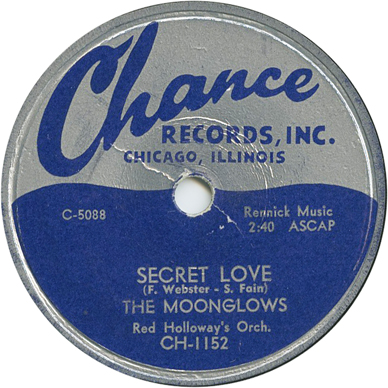
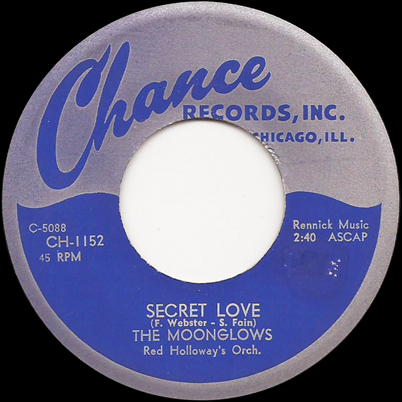
The year got off to a strong start in January, as the Moonglows waxed six presumably more salable titles. The Red Holloway band again consisted of Red on tenor sax, Louis Carpenter on piano, Hawk Lee on bass, and Robert "Hendu" Henderson on drums. One of the tracks was a cover rendition of Doris Day's "Secret Love," which had been featured in the film Calamity Jane. Although the Holloway band did not respect the chord sequence of the song, the Moonglows' version had a particularly effective harmonized intro with falsetto top that segued into Lester's emoting lead. "Secret Love," as the Moonglows' third Chance release, was paired with a spectacular jump, "Real Gone Mama," featuring Harvey Fuqua as lead. The Billboard reviewer gave it four stars and "Secret Love" only three stars. Chance 1152, released before the end of January 1954 (it received a favorable review in Billboard, February 27, 1954, p. 47), made the most noise of all the Moonglows' Chance sides. In March, Sheridan said it was the company's top seller for that month.
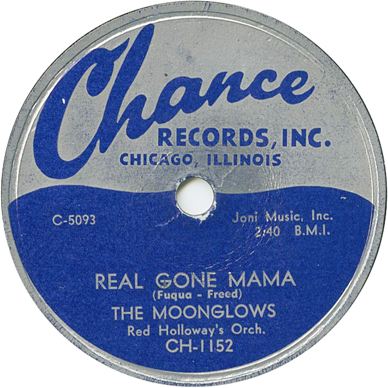
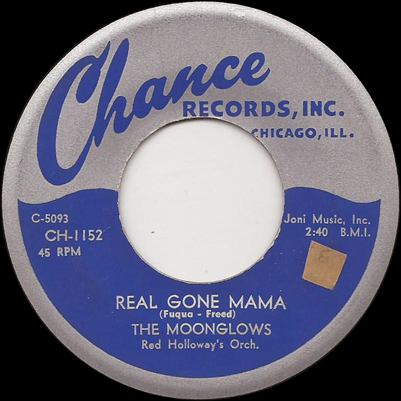
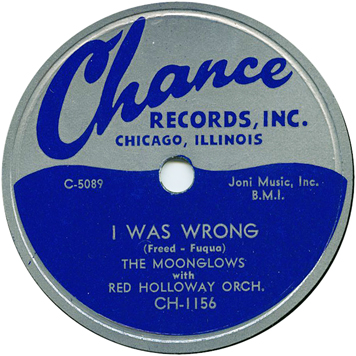
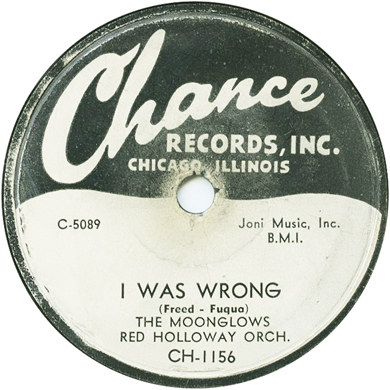
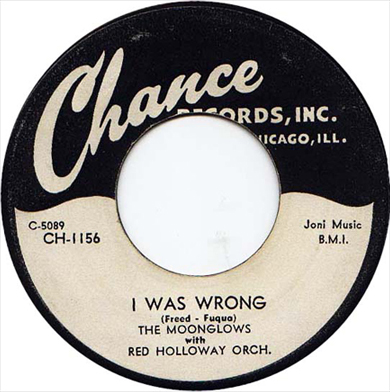
The company put off releasing the next two titles from the session until June, when Chance 1156 came out with "I Was Wrong" b/w "Ooh Rockin' Daddy." "I Was Wrong," featuring Fuqua as lead, has a nice switch-off approach, opening with Fuqua's sultry low-key lead and switching off to high-powered chorusing and segueing into Lester's screaming lead. Asserted Fuqua, "that was the strongest song, I think, before 'Sincerely.' It made quite a bit of noise in Cleveland, Chicago, and I believe, the West Coast." The record never made the national charts, but it picked up what were then called regional sales.
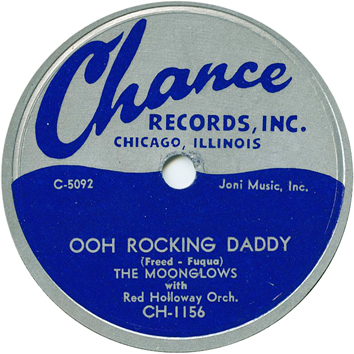
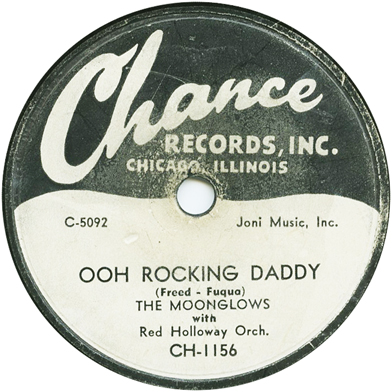
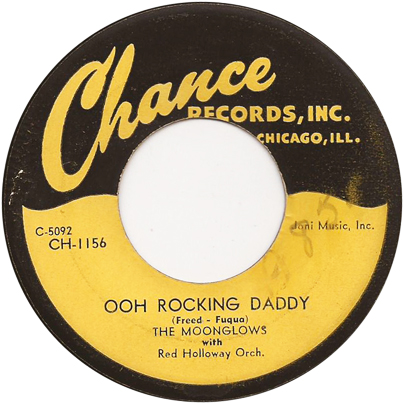
"Ooh Rockin' Daddy," with Lester on lead, is an R&amb;B jump, but with the searing tenor sax break by Red Holloway and the aggressive approach to the "rock rock rock" refrain one could call it a proto-rock 'n' roll number. The Billboard reviewer preferred the rocking side and gave it four stars.
Enough copies of the 78 were pressed that some carry the silver on blue label and some carry the new black on beige. Meanwhile, 45s can be found in both black on yellow and black on white.
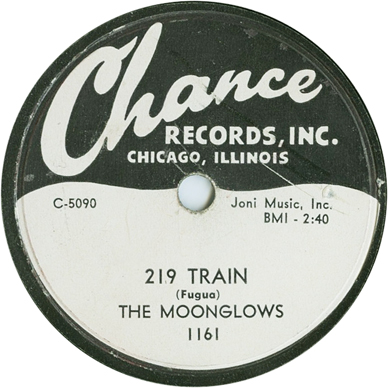
The Moonglows' fifth and final Chance release, "219 Train" b/w "My Gal" came out in October 1954, as the company was about to close and the Moonglows were looking for a new label. Chance 1161 was listed as a new release in Billboard on October 16 (p. 46). With the black on white label exclusively, 1161 was barely distributed and has proven to be the group's rarest record, fetching collector prices from $500 to $1,000. "My Gal," led by Fuqua, is an uninteresting jump partially saved by Red Holloway's excellent sax break, but the bluesy "219 Train" is something else, with a great emotional melismatic lead by Bobby Lester.
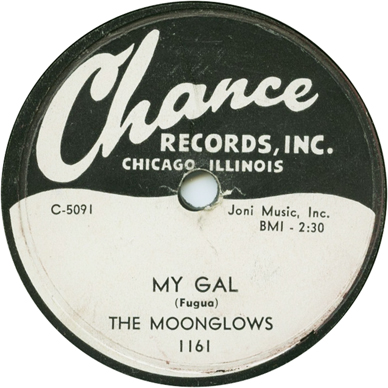
Another foray into jazz was a session the company did with bassist Chubby Jackson in January; he had participated in the Conte Candoli session the previous year. This musician was born Craig Stewart Jackson in New York City on October 25, 1918. He established his reputation with the Woody Herman Orchestra in the late 1940s; in the 1950s he spent quite a bit of time in Chicago, recording a single with Red Saunders for Mercury in 1954 and two big-band LPs for the Chess brothers' Argo label in 1957. His 6 Chance sides, however, were left in the can, and have remained unissued to this day.
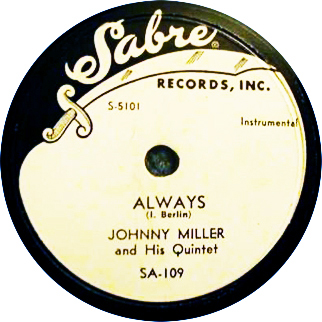
Two sides by Johnny Miller came out on Sabre 109 in August 1954. Billboard listed 109 as a new jazz release on August 28 (p. 78). Sheridan was in no hurry with them, as they were most likely recorded in January. Both were instrumentals, performed by a combo of tenor sax, piano (switching to organ on "I Cover the Waterfront"), rhythm guitar, bass, and drums. The saxophonist is a decent soloist in a post-Coleman Hawkins style, the rhythm section swings, and the pianist makes a good account of himself, but his organ playing has that pre-Jimmy Smith corniness. It would be nice to know what instrument the leader played; more research is definitely needed on Miller and his likely associates. It would also be nice to hear the rest of the session—6 more sides—if they survive. On some copies of Sabre 109, the A and B side labels are reversed.
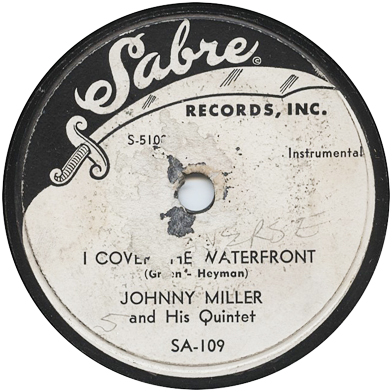
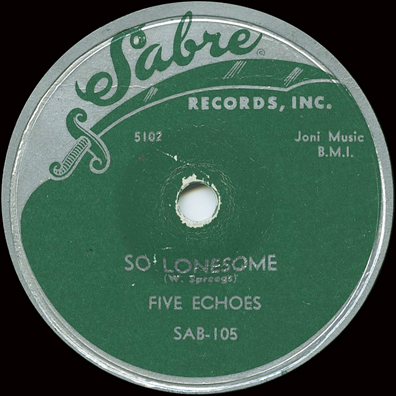
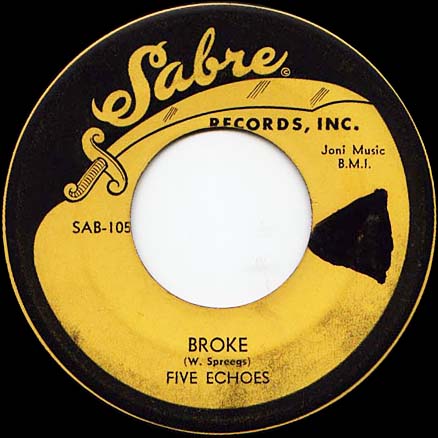
The Five Echoes returned to the studio in January for the Sabre label, backed on this occasion by an Al Smith unit with Red Holloway, Mac Easton, Willie Jones, Quinn Wilson, and Vernel Fournier. After their first session, the Five Echoes had lost Tommy Hunt to the draft. The group recruited Johnnie Taylor, a Kansas City native who was bumming around Chicago singing in a local gospel group, the Highway QC's. Johnnie Taylor would become a hit-making phenomenon in the 1960s and 1970s. Issued on Sabre 105 under the Echoes' name were "So Lonesome," which features Sims on lead but has Taylor coming in as second lead, and "Broke," featuring Sims as the sole lead. The two sides saw release in February.
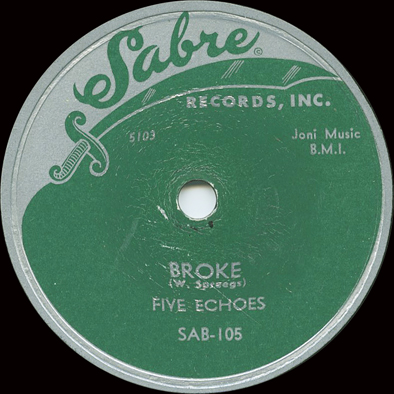
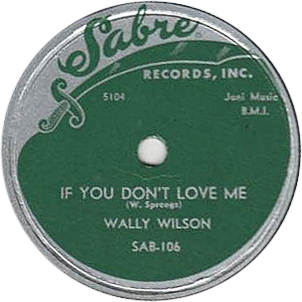
Two further sides were done at the same session with one "Wally Wilson" joining the Five Echoes and the Al Smith group. These were released as Sabre 106. "Wilson" was in fact Walter Spriggs (who didn't always want record companies to use his right name); he got composer credit (as "Spreegs") for all four sides from the session, and sings the lead on both "Wilson" sides. An alternate take of "The Hunt" has survived on which he sings the vocal solo. Why Spriggs chose such a dull pseudonym is a mystery to us today. In the fall of 1954, after Sabre had quit issuing new releases, Spriggs would actually make a session under his own name, for Blue Lake.
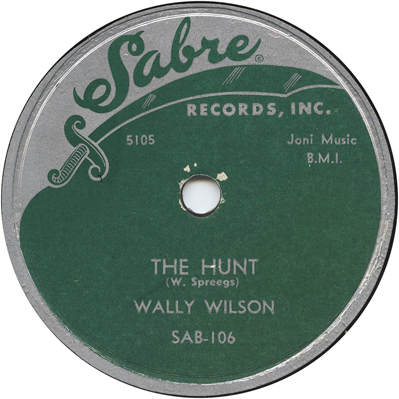
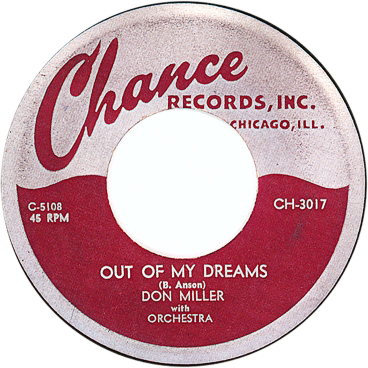
The next session, in the C5000 series that the label was now relying on, was a pop outing for Don Miller—presumably not related to Johnny Miller. He was responsible for one release, on Chance 3017. He used to be a complete cipher, but we've found a quick reference to him in Cash Box's Chicago notes for April 24, 1954: "Chi vocalist Don Miller's first 2 sides have just been released. He's doing terrif' at Fazzio's [sic] in Milwaukee. Give the kid a big hand. He's hometown" (p. 10). Dem Records, of Findlay, Ohio, released two singles in 1954, by Don Miller & The Sweet Swingsters. Was there any connection?
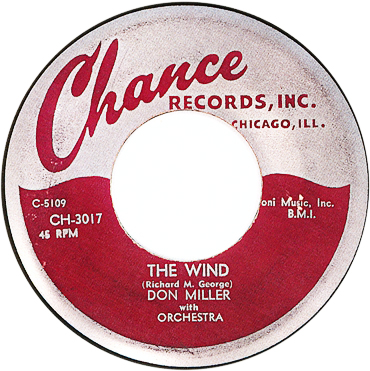
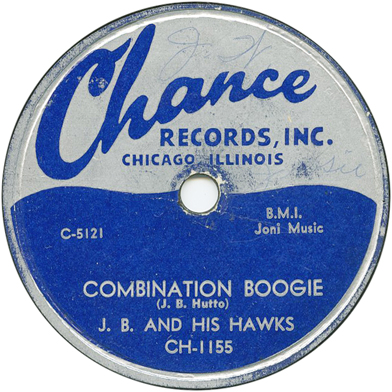
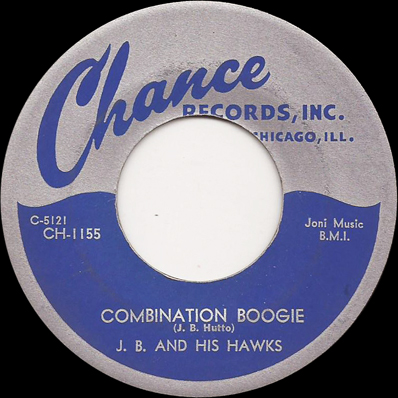
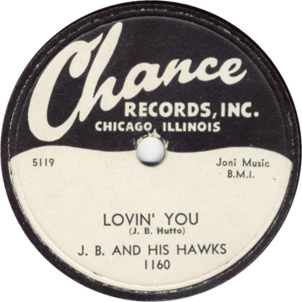
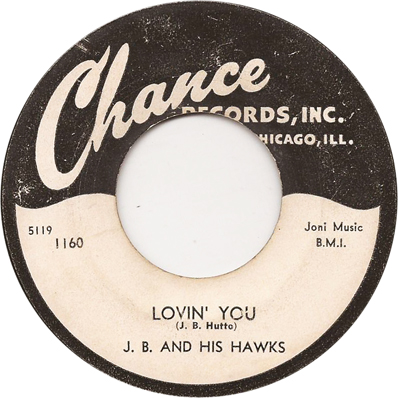
Slide guitarist J. B. Hutto was one of Chance's most impressive blues talents. He was born Joseph Benjamin Hutto in Blackville, South Carolina, on April 26, 1926; his family moved to Augusta, Georgia, when he was 3. After his father died, he came to Chicago in 1949, and settled on the West Side. He drove trucks for the military during the Korean War. Hutto had originally sung in a family gospel group, and played drums, but after arriving in Chicago he taught himself guitar. He formed his band, the Hawks, with "Earring" George Mayweather on harp, Joe Custom on second guitar, and Eddie "Porkchop" Hines on drums or washboard. Custom is usually said to have played bass, but a listen to the group's recordings, as well as a photo of the ensemble, show that he was playing "bass on the guitar" and occasionally taking over the lead, as was the practice in many blues groups during the first half of the 1950s.
Hutto's first sides on Chance, recorded in either January or February, represent an extraordinary debut. (According to Bob Koester, the original tape boxes indicated that the session was recorded by Joe Brown and sold to Chance, so J. B.'s debut was yet another JOB product.) Over raw amplified guitar and blazing amplified harp, Hutto sang in a fierce declamatory style with a thick accent. The superb "Combination Boogie" (which includes a passage for spoons on washboard) saw release in May, on Chance 1155. The raunchy "Pet Cream Man" appeared in September on Chance 1160.
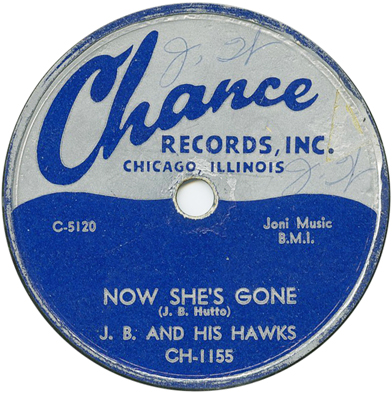
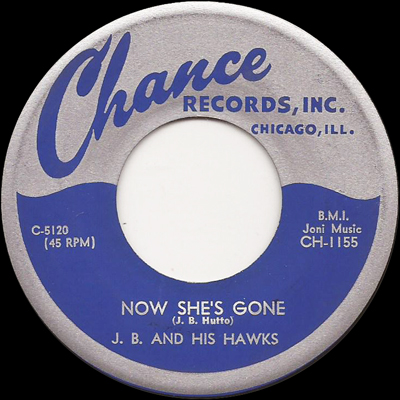
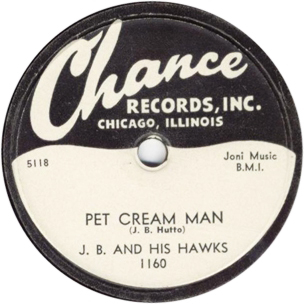
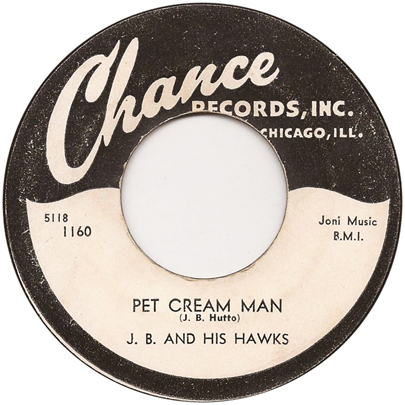
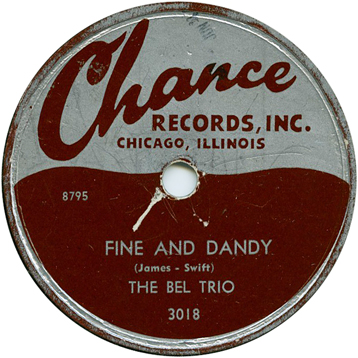
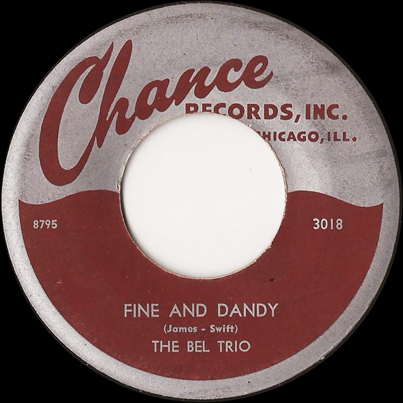
The BEL Trio (misspelled "Bell" in Sheridan's notes) cut one session, probably in February 1954. The trio consisted of Bob De Blaey (1921-2013) on guitar and banjo, Carl Elmer (1931-1978) on accordion, and Erv Ullenberg (1921-1976) on string bass. As we inferred upon finally hearing Chance 3018, they were from Milwaukee. We learn from Billboard (October 24, 1953, p. 64) that the group had just made its TV debut on WTMJ. In 1954 "The BEL Trio Show" was running twice a week on the station. This could have brought them to Art Sheridan's attention, but their only previous recording as a trio had been for Demo, a label he distributed. During this same period, the members owned and operated the BEL Club at 54th and Lisbon. By 1956, the club had closed, and the band was taking an engagement at the Brass Rail in Milwaukee (Jim Koconis, "Milwaukee's Night Life Chatter," Milwaukee Sentinel, November 17, 1956, pt. 2 p. 5.) The BEL Trio broke up in the early 1960s. In the 1960s and 1970s, Bob De Blaey played regularly at the John Ernst Cafe. He gave his last public performance at the age of 91.
See Bob De Blaey's death notice (Milwaukee Journal Sentinel, August 18, 2013, http://www.legacy.com/obituaries/jsonline/obituary.aspx?pid=166479169; also Patrick Simonaitis, "De Blaey made music in Milwaukee for eight decades" (Milwaukee Journal Sentinel, August 23, 2013, http://www.jsonline.com/news/obituaries/de-blaey-made-music-in-milwaukee-for-eight-decades-b9978839z1-220773141.html.)
The BELs made hardly any commercial recordings. The only other trio session we know of was cut late in 1952 for the Demo label. A tiny company in Milwaukee that lasted from 1952 through 1958, Demo probably didn't accrue 40 releases over its lifetime. (Another 1952 session for Demo, whose only distributor outside of Milwaukee was Sheridan in Chicago, was the source for Chance's Jack Teter release; see above). On their 1952 session, probably made at the RCA Victor studio in Chicago, the BELs backed singer Fran Conway on Demo 1018. The 1954 BEL Trio session might also have been cut for Demo. But four sides (not just two) were entered in Art Sheridan's book, and we haven't found a release on Demo.
Expanded to a quintet, the BELs recorded 6 tracks for the Audiophile label, out of Saukville, Wisconsin, probably in 1953. Their 6 tracks occupied one side of a 12-inch LP, Swing Potpourri Vol. 1. This was one of those never-reissued items sold in a folder, on Audiophile AP-23. For the session, Erv Ullenberg switched to violin, and Art Kay, vibes, and Mark Steger, string bass, were added. It's too bad the BELs didn't get more opportunities of this kind, because they laid down 16 minutes of excellent Swing combo material—and hearing more Ullenberg on violin and De Blaey on acoustic guitar would have been a treat.
Beyond the three studio sessions, Mrs. De Blaey recorded audio off the TV set, preserving some material from the BEL Trio's half-hour show. Two performances, courtesy of Nancy De Blaey Thorgaard, can be heard on Youtube at present: https://www.youtube.com/watch?v=WS3Jo3AnwTA and https://www.youtube.com/watch?v=t7mAaD1fW8E.
The BEL Trio swung, as we hear on "Fine and Dandy." Sheridan's hopes, however, must have been pinned on "More Beer," a novelty number that put words to the C strain of the "Wisconsin Polka." It had raked in the nickels in 1948 and 1949. But by 1954, "More Beer" was distinctly stale. Too bad, because the BELs actually swung it, and enjoyed hamming up the lyrics in heavy German accents. The other two sides remain unissued.
Chance 3018 was the last to use the silver on red label for both 78s and 45s.
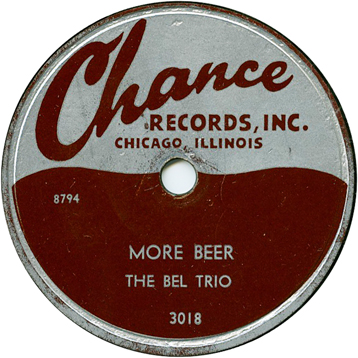
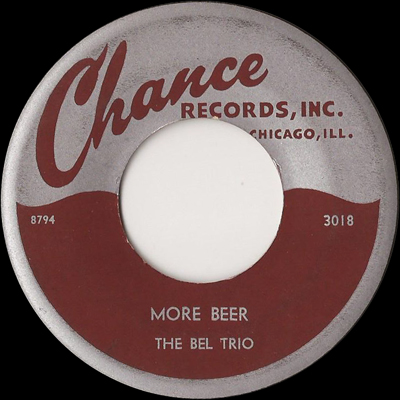
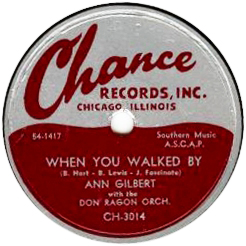
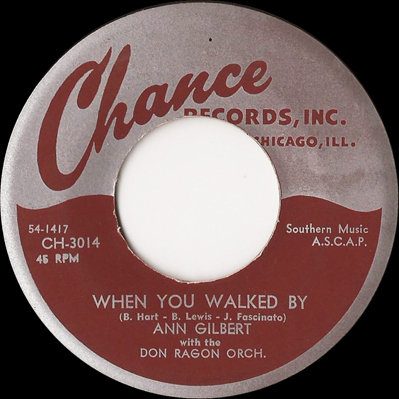
Chance 3014 by Ann Gilbert has matrix numbers in a 54- series. We don't know which studio this was from. But her session, with a band directed by Don Ragon, probably took place in February, because she was getting "ballied" and "hypoed" in March and her single was reviewed in Billboard on March 27 (p. 30). She also caught some favorable publicity in Cash Box (April 3. 1954, p. 13), her single being reviewed there on April 17 (p. 8).
Ann Elizabeth Gilbert was born in Memphis, Tennessee, on June 30, 1933. She took a solo in church at age 4 and began singing in the chorus for Memphis Summer Opera productions at age 12. At 15, she won a talent contest. The prize was singing with Horace Heidt's band. Ann Gilbert graduated from Central High in 1951 and that same year was crowned Miss Memphis, singing "Night and Day" for the talent portion of the pageant (http://www.missmemphispageant.com/history/1951.html).
She majored in voice at Lindenwood College for Women in Saint Charles, Missouri, which she attended on a music scholarship, but learned that she preferred jazz and pop, and would rather improvise at the piano than study the classics. She left Lindenwood in the summer of 1953. For two years, she had been taking composition lessons, singing in the Lindenwood College choir, doing an occasional stint on the college radio station, and playing the piano at dance recitals. Now she was working restaurants and clubs in Duluth, Indianapolis, and Chicago, accompanying herself on her instrument. (According to Ben Kemper's notes to her first LP, she worked some tony locales, like The Flame Restaurant in Duluth and The Keys in Indianapolis.) Maybe ten months into her professional career, Billboard announced she had been booked into the Cloister Inn, apparently on the strength of her Chance release ("Cloister Inn Goes to New Disk Talent," March 20, 1954, p. 19). It turned out that Windy City Publishers, the music publisher for "Our Fav'rite Waltz," had set up the session (and maybe done a little bargaining with the Cloister). Windy City was a subsidiary of McConkey Artists, a talent agency trying out a new strategy of getting record companies to cut sessions by artists who showed an interest in recording Windy City songs. "So far the agency already has thrush Ann Gilbert on wax with more sessions set for the near future" ("MAC Pubbery as Artist Aid," Billboard, April 3, 1954, p. 13).
So we know how her sides escaped being listed in Art Sheridan's notes to Marcel Chauvard; they were sold outright to BBS Records of Philadelphia for $5,000 (we won't try to estimate how much of that came back to Sheridan). The Cash Box blurb from April 3 said her single "has just been taken over by B.B.S. Records," and the very next item just happened to be about Windy City Publishers. Still, when it came time to review the record, Cash Box (April 17, 1954, p. 8) identified it as a Chance release. The review in Billboard (March 27, 1954, p. 30) had also described the Chance release. We don't know of a release with the BBS label, possibly because there never was one.
BBS had been founded in 1952, when it almost immediately scored a big hit (it received a Gold Record) by crooner Al Martino. Whereupon BBS couldn't get anything more from Martino, because he was instantly signed away by Capitol. Like some other indies tapping big revenues that were soon to run out, BBS announced expansion plans. The deal with Windy City (which also included Larry Faith's Orchestra) was part of the program. BBS announced that Gilbert would be traveling to the East Coast to do more recording. Although she was duly announced as a BBS artist in a display ad in Billboard (May 1, 1954, p. 29; Gilbert and Larry Faith were among the artists from whom new releases were "coming soon"), we have no evidence that BBS released anything by her. (Nor was there any further mention in Billboard of Windy City Publishing's recording program.) BBS had obviously overdone the expanding. In October, BBS announced a merger with the even newer Burgundy Records of Detroit ("BBS & Burgundy Complete Marger," Billboard, October 30, 1954, p. 15). In December, Burgundy declared that the merger wouldn't be happening after all. Neither company made it more than a few months into 1955.
Her BBS contract having become worthless, Ann Gilbert was back to working small clubs. Probably a few months after her Chance session, she sang on TV, performing "Once in a While" with Ken Griffin at the organ (the clip appears to have been taken from his Chicago-based show, 67 Melody Lane, which aired locally that year; unlike most episodes, it has survived because it was shown in theaters to promote Griffin's live appearances). "Once in a While" was not released on a record till Columbia, which had had Griffin under contract between his departure from Rondo in 1950 and his death in 1956, put it on a bargain LP retrospective in 1966.
There must be something in a newspaper morgue somewhere, but our research has only let us pick up the thread again in September 1955. From September through November, Ann Gilbert ("Chicago's Newest Find") was at the Caribbean Room in the Hyde Park Hotel, 5108 South Lake Park, accompanying herself at the piano. Through November, she was announced as being "held over" (Southtown Economist, November 30, 1955, p. 10), but was not part of the holiday show the next month.
Just after New Year's 1956, she opened at a cocktail lounge called the Pink Poodle, 1625 East 67th Street. The Poodle used the same formula as the Caribbean Room: singers alternated, accompanying themselves at the piano. With a one or two-week hiatus—she was replaced during the second half of January by Frances Colwell—Ann Gilbert was probably there past the end of March, where the local entertainment advertisements that we've been able to find take a long pause. (The gap extends through April 1957, during which time the Poodle seems to have been going strong: in May 1957, it hired Frank D'Rone for what had once been Gilbert's spot.) Forgetting her Chance release (nearly everyone had) and her BBS contract (everyone wanted to), Ben Kemper's notes to her first LP put it this way:
Ann was discovered for records a few short months ago when a Groove representative, sifting Chicago's South Side for promising newcomers, dropped into a small, intime boîte called the Pink Poodle. Not only was he fascinated, but he also was vastly impressed by the fact that the audience followed Ann's interpretations with rapt attention and applauded after every tune.
Ann Gilbert was already in New York City in May, so she was probably signed in late April. She made two LPs in New York. We don't have precise recording dates for the first one, but we suspect around June, because the LP came out in mid-August (Paul Little, "Needle in the Groove," Arlington Heights Herald, August 18, 1954, p. 26), and a single from it was released the last week of that month. On September 5, she was on the Frankie Laine show, singing "Don't Let It Get You Down"; the other guests were Eddie Heywood and Johnny Ray. The TV reviewer for the Chicago Tribune must not have visited the Pink Poodle; she was tagged merely as "New singer, Ann Gilbert" (September 5, 1956, p. 26).
Her second LP, after Victor shuffled some artists around different branches of the operation, was recorded in December 1956 and January 1957 and released on Vik later in the year, with Bob Rolontz of Groove still credited as the producer. (Groove was shut down at the end of 1956, with Rolontz and half of its artist roster going to Vik.)
Both of Gilbert's LPs were done with bands directed by Elliot Lawrence. These featured top jazz musicians, including Urbie Green, trombone, Al Cohn, tenor sax; Hal McKusick, alto sax; Mary Osborne, guitar; and Osie Johnson, drums. Groove and Vik each released 45 rpm EPs off her albums. The year that started on East 67th ended with Robert Montgomery Presents on New Year's Eve. (A TV performance that has been preserved from 1956, probably from Robert Montgomery Presents with the Hugo Winterhalter Orchestra, can be seen on Youtube: https://www.youtube.com/watch?v=VO7khEJIE-U.)
In January 1957, Vik released two pop sides ("Johnny" b/w "He Thinks I'm Wonderful") that were not from either of Ann Gilbert's LPs; Vik X-0255 was reviewed in Cash Box on January 19, p. 8). In February 1957 she got a month at Radio City Music Hall. On May 4, 1957, she married Stuart Ostrow (born in 1932), who was then an executive for Frank Loesser's music publishing company, and later became a Broadway producer. According to Ostrow's memoir (Present at the Creation, Leaping in the Dark, and Going against the Grain, New York: Applause Theater & Cinema Books, 2006), "I first met my wife-to-be, Ann Gilbert, on the opening night of The Most Happy Fella, in the Imperial Theater lobby and was in love with her by the second act" (p. 12; the show opened on May 3, 1956).
Her career as a commercial recording artist ended when her contract with RCA expired. She raised three children and for 27 years taught music and musical theater in New York City. In 1994, Ann and Stuart Ostrow moved to Houston, Texas, where they both taught at the University of Houston before retiring. Ann Gilbert Ostrow died of pneumonia at the age of 79, in Houston on October 25, 2012 (http://obits.dignitymemorial.com/dignity-memorial/obituary.aspx?n=Ann-Ostrow&lc=4923&pid=160688846&mid=5286332#).
Don Ragon was a trumpet player (with an unusual double—the baritone sax). He was born in 1917 and started leading a territory band around 1940. He claimed to have played all 50 states, but in the earlier part of his career he seemed to spend an most of his time in the Midwest. From his sporadic mentions in Billboard, we learn that Ragon's band was resident at a hotel in Columbus, Ohio, in 1943. As steadily as his band found bookings, Ragon drew little interest from the recording industry. His one previous shot came when he signed with the Milwaukee-based Chord label in October 1947. His band got a novelty number out on a single in January 1948. However, Chord stepped back from jazz and pop at the end of that month, and was out of business by the fall of the same year. Some of its polka bands clawed their masters back, and sides by two of its jazz groups were rescued and issued in 1949 on a John Steiner label called Down Beat, but nothing further happened with Ragon's sides.
Ragon's band was working in Cairo, Illinois, in 1948, in Springfield and Quincy, Illinois, in 1949, but also at a higher-visibility venue in Chicago that same year (Billboard, October 1, 1949, p. 42, announced four weeks at the Martinique, starting September 29). He was booked into a club in Omaha, Nebraska, in 1950, but also had gigs in Jackson, Mississippi, and in Milwaukee. A typical pitch for one of his big band appearances mentioned vocalists Alice Raye (the stage name used by Alice Ragon, his wife) and Keith Milheim, plus novelty vocals by the leader. "Ragon's orchestra is styled along sweet, soft lines, resulting in smooth, melodic dance tempos" ("Don Ragon Bringing His Band to Surf Ballroom Sunday," Mason City (Iowa) Globe-Gazette, June 1, 1950, p. 6). He downsized to a combo in 1952.
Ragon was a long-time client of McConkey Artists Corporation, which might have had something to do with his presence on the date (we suspect Ann Gilbert did not play piano on it). Ragon presumably was expecting to provide pop production: the Billboard review (March 27, 1954, p. 30) said of "Our Fav'rite Waltz": "Sentimental three-beat melody gets a fair vocal, backed with a schmaltz fiddle and chorus." (The reviewer liked "When You Walked By" a lot better.)
Ragon remained with McConkey after his solitary appearance on Chance. McConkey and Windy City Music tried another recording venture, opening a label called Window. To keep costs down, they put its office in Sheboygan, Wisconsin. Ragon's group got two singles: Window 1009 ("Jungle Rock" b/w "After Love") and Window 1113 ("Rock-a-Boogie Rock" b/w "Don't Lie"). Ragon was a bit old to be trying rock and roll. Both carry H series matrix numbers from RCA Victor Custom Pressings, indicating they were recorded in 1957. Window 1009 ("aimed directly at the teenage market") caught a review in Cash Box on October 19, 1957 (p. 6). Window 1113 got relegated, with a rating below 70, by Billboard on February 10, 1958 (p. 44).
Not long after that, Ragon moved west. In 1960, Don Ragon announced that he was now working out of Las Vegas with the Mutual Entertainment Agency, booking acts in Nevada; Alice was now working as his secretary (Reno Gazette-Journal, May 13, 1960, p. 2). Don Ragon died in 1984.
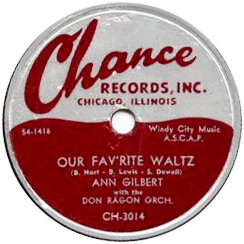
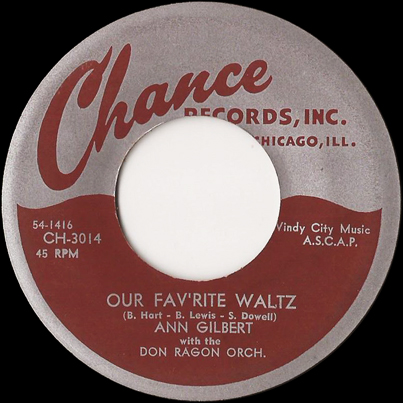
The next session (for sure, it fell between J. B. and His Hawks and the Kelly Brothers) belonged to one James Hewitt, whose four titles remain unissued. Most likely pop material, from a singer not related to Dolph Hewitt.
The Kelly Brothers, who made their initial recordings for Chance probably sometime in February, had come together in 1948, and consisted of Andrew (baritone), Robert (tenor), and Curtis Kelly (high tenor), plus Offe Reese (tenor). For whatever reason, Sheridan chose not release the two sides they did. The group went on to record gospel on the tiny C. H. Brewer label (from the U3000 series matrix numbers, the C. H. Brewer single was done in May 1956), then got more exposure in September 1956 when they cut the same two titles for Vee-Jay. It's curious that Chance cut (or got hold of) just two sides by the group; was the C. H. Brewer connection already in place? The group recorded soul-style R&B as the King Pins for the Federal label from 1960 to 1964 and then did Southern soul as the Kelly Brothers for Sims and Excello up to 1970.
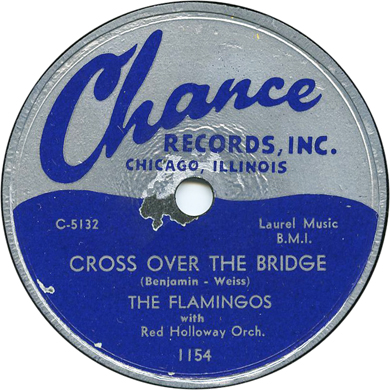
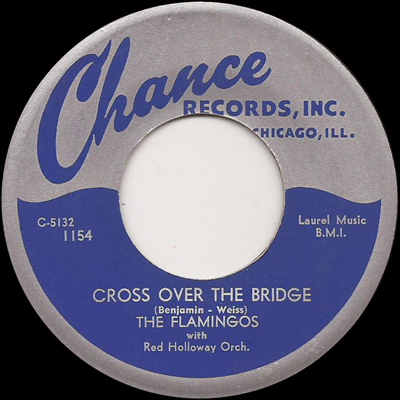
February 1954 saw the Flamingos go in the studio again to record "Cross over the Bridge" b/w "Listen to My Plea." Credit was given to a Red Holloway Orchestra but it's not Red's quartet; it sounds like an Al Smith band with Red Holloway, Mac Easton, Willie Jones, Quinn Wilson, and Vernel Fournier. On subsequent release on Chance 1154, neither the cover of the Patti Page hit nor the bluesy "Plea" were appealing enough to sustain the Flamingos' name with the public. In March, however, "Cross over the Bridge" got some play in Chicago and other cities.
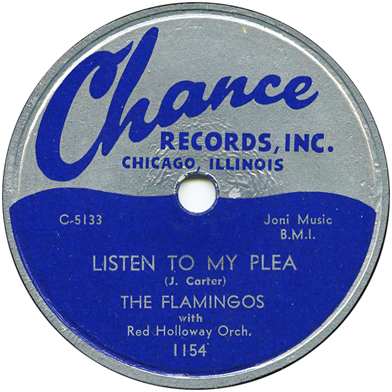
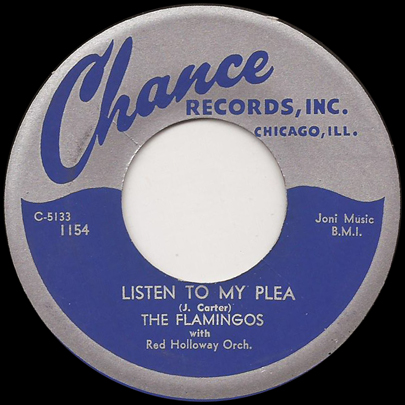
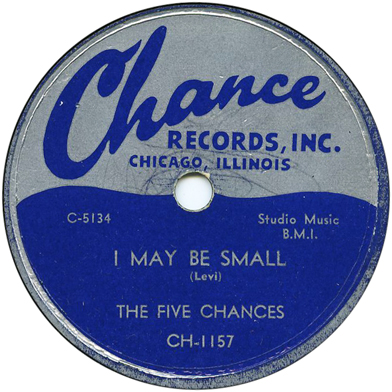
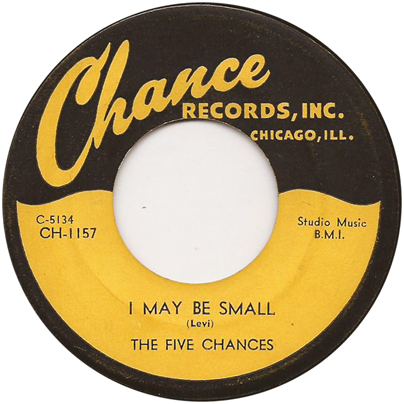
The eponymous Five Chances were the last vocal group added to the label. At the time of signing, the members of the group were Darnell Austell (lead), his brother John Austell (bass), Reggie Smith (tenor), Howard Pitman (baritone), and Harold Jones (baritone/ tenor). The group's manager, Levi McKay, however, was experimenting with various line-ups drawing new members from other groups he managed. He brought in Eddie Stillwell from the Fasinoles and Clyde Williams from the Daffodils. Stillwell would appear on record with the Chances, but not Williams. Williams did go on to sing solo in various clubs, and to record as a vocalist with Sun Ra in 1956. He also landed a spot on a King Kolax record for Stepheny (1957).
The Five Chances made four sides for the company at a session around April 1954: "I May Be Small," "Nagasaki," "California," and "Make Love to Me." Backing was provided by still another Al Smith group. All the leads were by Darnell Austell, but on "Make Love To Me" and "Nagasaki" Stillwell joined in as alternate lead. (Stillwell was only a part of the group for the session, which temporarily made them Six Chances.) "I May Be Small," written by McKay, was the strongest of the four sides. It is a bluesy ballad, but retains its attractiveness as a vocal harmony vehicle. The song was paired with the old Mort Dixon and Harry Warren song, "Nagasaki," which was introduced onto the charts in 1928. Chance 1157 was released in August (reviewed in Billboard, August 7, 1954, p. 40) and got good regional sales. But we know it didn't do as well as Chance 1156. The release may have been planned for a couple of months earlier, and the 78s all have the old silver on blue label.
"California" was an original jump written by McKay that was as strong as the released sides. The other unreleased title was "Make Love to Me," which was a popular number on the charts then by Jo Stafford. These two sides surfaced in 1964 on the Constellation Groups Three LP.
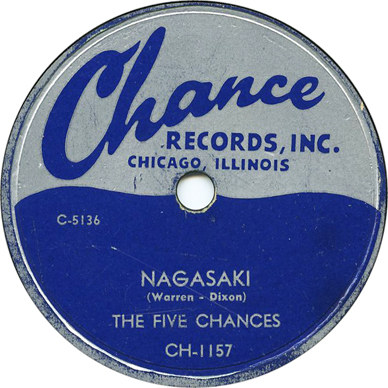
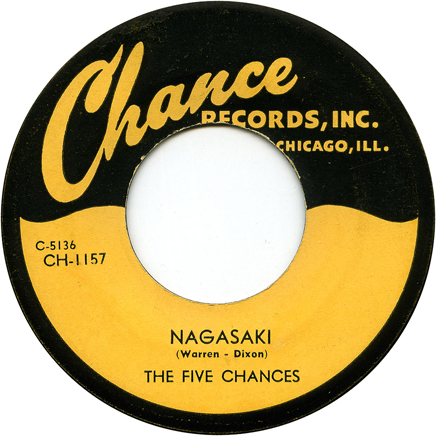
With the Five Chances session, the company had recorded 50 sides through the end of April, nearly all of them in January and February. Sheridan's attention, increasingly, was directed elsewhere.
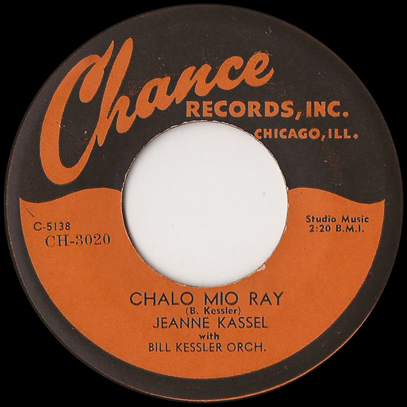
A pop singer,Jeanne Kassel , made two sides in July with Bill Kessler's band. The performances and the artists had long been a total mystery to us, but one article in the Benton Harbor, Michigan, News-Palladium ("Around Town: Tunes Well Received," July 24, 1954, p. 1) has changed that. Kessler was a resident of Saint Joseph, Michigan, played clarinet and saxophones, and led the band at the Whitcomb Hotel. His previous recording experience, from 1951, had consisted of accompanying Jane Turzy on a session for Decca. Kessler wrote "Chalo Mio Ray" and "Can I, Will I" and got his friend Archie Levington, the owner of Midway Music and Studio Music in Chicago, to publish them. (Levington was the husband of Fran Allison, a former Rondo and current RCA Victor artist, also enjoying success with her TV puppet show, Kukla Fran and Ollie.) Bill Putnam of Universal Recording was said to be so taken with the songs that he assumed $2000 in recording and mastering expenses ("Chalo Mio Ray" supposedly consumed 13 hours of studio time). The singer's real name was Jeanne Katz. The sides were released on Chance 3020, whose 45 labels followed the short-lived black on orange scheme. From the single's great rarity today, we doubt that Bill Putnam recouped his investment.
The News-Palladium claimed that both songs had been recorded for Dot by Jimmy James. One was. Dot 15158 had "After the Laughter and Wine" on one side and "Chalo Mio Ra [sic]" on the other. The other company had actually recorded the number first (the release was included in a Dot display ad in Billboard, May 15, 1954, p. 22). In any event, this may explain an enigmatic reference in Art Sheridan's list of Chance masters (see our comments on the Red Surrey Trio, above).
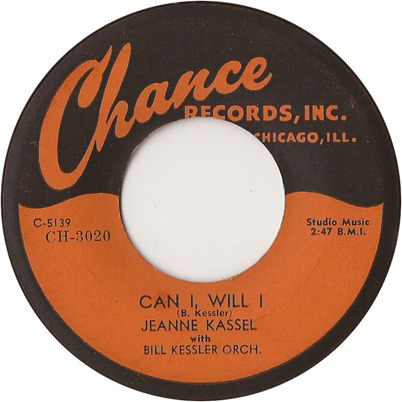
Lucy Reed got a second session, also in July (and maybe right after the Kassel/Kessler), backed by a band led by Chuck Sagle. Sagle was to become a famous arranger and producer, discovering Carole King and conducting for Clyde McPhatter and Neil Sedaka. In 1954 he was four years out of college and working his way into the business. Charles H. Sagle was born in 1928. By his high school years he had become an accomplished trumpet and keyboard player. He enrolled at the University of Illinois at the age of 16, though his graduation was delayed till 1950 by service in the US Navy. The Lucy Reed session must have been one of his very first.
Sagle next took a job with Mercury Records in Chicago, serving as an assistant to Lew Douglas, an omnipresent studio band leader who was then heading A&R at the company's Wing subsidiary. (Reed had previously recorded one session with Douglas, which may have been her introduction to Sagle.) In December 1955, Lew Douglas left to join a pop startup, Bally Records, and Sagle, at age 27, was promoted to head of A&R for Wing. He next became music director for all Mercury singles produced in Chicago. Sagle was so prolific that he started using the name Carl Stevens on some of his songs and arrangements.
In 1958, Sagle appeared (playing trumpet) on a Mercury big band LP titled Skin and Bones; it was credited, of course, to Carl Stevens. Dick Marx played piano on it. But by the time his LP was released, Sagle had left Mercury to start Carl Stevens Productions ("Sagle Starts Master Firm," Billboard, June 23, 1958, p, 9). In the fall Sagle was producing sessions for a subsidiary of Mark Records in Minneapolis, called Play. All of this proved insufficiently remunerative, so Sagle relocated to New York City, where in 1959 he was Don Kirshner's music director; he next worked in A&R for Epic Records, releasing an instrumental LP under his own name titled Ping Pong Percussion in 1961. In 1962, he moved to Los Angeles to serve as music director for Reprise. After producing and arranging everyone from Sammy Davis Jr. to Gene Pitney to the Manhattans, Sagle moved to Nashville in 1972, working for ABC-Dot among others, and doing some big-band arranging on the side. In 1984, Sagle went back to school to become a computer programmer, retiring in 1994. Chuck Sagle died in Nashville on April 13, 2015, at the age of 87 (Robert K. Oermann, "Life Notes: 'Golden Age' Arranger Chuck Sagle Passes," Music Row, April 17, 2015; http://www.musicrow.com/2015/04/lifenotes-golden-age-arranger-chuck-sagle-passes/).
Two sides from Lucy Reed's second session appeared on Chance 3019, again with the silver-on-red 78 and the black-on-orange 45 label; if more were cut, Sheridan didn't so indicate in his notes.
It's a shame that Reed's Chance recordings presented her strictly in a pop context. We know that Lurlean Hunter remained at the Streamliner until December 1953. We don't know whether Lucy Reed was still there in April 1953, when she recorded with Al Trace, but by July of that year Hunter was the sole vocalist at the club (Billboard, July 11, 1953, p. 16, put her there with Don Shirley, piano, and Johnny Pate, bass). When she recorded with Sagle, Lucy Reed was working two nights a week at the Lei Aloha, where she had moved at some point in 1953, with Dick Marx at the piano and Johnny Frigo on bass. Frigo (see http://riverwalkjazz.stanford.edu/guests/johnny-frigo) recalled the job this way. He had returned to Chicago from Buffalo, New York, in 1951:
In Chicago, I had to start over. There was a singer I met named Lucy Reed who heard me sitting in with [George] Shearing and hired me to play a North Side club called Lei Aloha. I called a pianist I heard–Dick Marks [Marx], and the gig took off like a rocket…It was sort of a bar for winos, but in four weeks it was completely transformed; a metamorphosis. Word got around, and people waited around the corner to get in.
According to singer Frank D'Rone, "they were the hottest thing in town at the time."
So why not record her with Les Strand, or with Marx and Frigo? Especially when Marx had already been on the Jack Nelson session... and Frigo was already the first-call studio bassist in Chicago. We have to say, though, that the torchy titles on her 1954 session ("A Night Is Dark" b/w "Au Revoir") improved on the songs from her first outing. We wonder whether Chance 3019 sold anything; it's rarely seen today. The female chorus and the strings on "Au Revoir" were unnecessary, though the flute and the marimba were a nice touch. Also present on that side were rhythm guitar, bass, and drums. Trumpet and piano (the former, we presume, played by Sagle) are heard only on one turnaround. Sagle's arrangement for "The Night Is Dark" (that's what she actually sings) gives the trumpet and the piano a lot more to do, and there is no marimba—or rhythm section—or female chorus. Marx and Frigo, maybe one solo horn, would have been much better from our point of view, but that manner of proceeding was surely deemed too stark for the record buyers of the time.
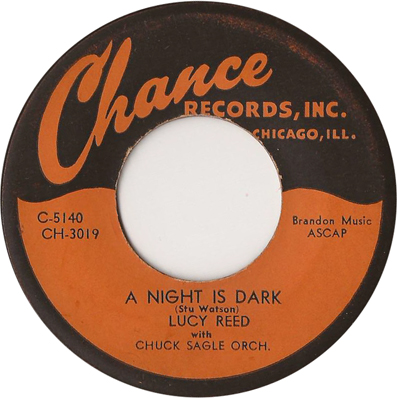
Lucy Reed was on her way out of town. In October 1954, she left the Lei Aloha to return to the Streamliner, with Jimmy Bowman at the piano (probably also singing ballads), folksinger Katie Lee, and, after a while, Carmen McRae. The issue with the Lei Aloha may have been expanding from two to three nights a week, which the trio had requested. Katie Lee mentions the Streamliner, where she had been booked with some help from Burl Ives and his agent:
In Chicago's oldest, hippest jazz club, with jazz combo and two superb jazz singers (Carmen McRae and Lucy Reed), this little guitar-playin' folksinger opened her first eastern gig ever, up on the stand all by herself in a big full skirt, sang "John Henry," that great black folk fable about the indestructible steel-drivin' man, hoping nobody would walk out... (All My Rivers Are Gone: A Journey of Discovery through Glen Canyon. Boulder, Colorado: Johnson Books, 1998, p. 70)
The Streamliner wasn't as old as, say, the Blue Note, but it definitely wasn't identified with folk music. Yet Lee got excellent press and stayed for a month.
In November, Marx and Frigo also moved, to the Cloister, where they stayed for a while (they were playing there two nights a week in February 1955). On the strength of their work at the Lei Aloha and at the Cloister they got some recording offers. According to Frigo, "We ended up making three albums on Mercury [in fact, for Brunswick and Coral] by ‘Dick Marks [sic] and Johnny Frigo.’ All the while I was looking at my fiddle in the other room. I’d open up the case every few weeks and see if the strings were still on it." In early January 1955, Lucy Reed finished her gig at the Streamliner and took an engagement at the Village Vanguard, starting on January 18. For her 34th birthday, she had decided to try her luck in New York.
On June 29, 1955, Down Beat ran a special issue on "Music in Chicago," which fondly recalled former days at the Streamliner and referred to "Lucille Reed, a statuesque song stylist now in New York" ("Jazz," p. 26). By the time the article hit the stands, she was about to sign with Fantasy Records and would soon be recording her first LP, Singing Reed. Most of it was done in New York with a pianist named Bill Evans, appearing on his first session; Reed had insisted on using him. The remaining tracks were done in Chicago with Marx and Frigo; the album was released in March 1956.
Her debut side with Charlie Ventura was reissued that same year, on a Camden LP collection of jazz vocalists singing blues. In December she was tapped for Daddy-O Daylie's third annual Festival of Jazz at DePaul University in Chicago, on a bill with Johnny Pate's Trio, Sam Most, Abbey Lincoln, and the Ramsey Lewis Trio ("3rd DePaul Jazz Fest," Cash Box, December 15, 1956, p. 35; the event took place on Monday December 17).
Then, after further high-profile gigs in New York City, she made her second and last album for Fantasy, This Is Lucy Reed, which was released in September 1957. Three sessions were cut in January 1957, when she turned 36. One was directed by no less than Gil Evans, a second by no less than George Russell (both of course done in New York). The remainder was done in Chicago with pianist Eddie Higgins and his trio; there were guest appearances by Kenny Soderblom (clarinet) and a guitarist.
She never recorded some of the songs that Pat Harris mentioned in her Streamliner review, or that she performed on WGN radio with Bob Trendler, but the "shoulder-shaking" St. Louis Blues can be heard on This Is Lucy Reed.
In June 1957, Lucy Reed married Serge Seymour, a photographer born in 1933; still active today, he is the son of Maurice Seymour, who was a prominent showbiz photographer in Chicago. The event was considered worthy of an announcement in Walter Winchell's column for the week of June 25. She spent the rest of her life in Chicago. Soon she had two more sons, and took only such gigs as wouldn't interfere with raising a family. A typical example comes from a Ted Watson column in the Pittsburgh Courier (April 18, 1964, p. 13): "Lucy Reed, who sounds like the late Billie Holiday, has been dug up by Harry Brown, owner of the new Meadowbrook Country Club, and may wind up with a long engagement there." Watson was trying to be complimentary, but Lucy Reed didn't sound like Billie Holiday. And with four singles and two LPs to her credit, she didn't need digging up. We don't know whether she got the engagement at the Meadowbrook, or, if so, for how long. Even after her second marriage broke up in 1968, Reed worked locally and kept a low profile.
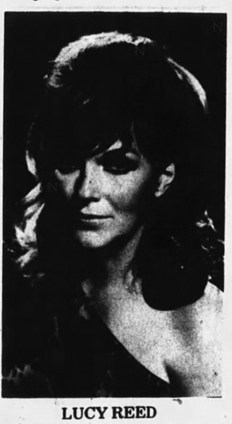
Going longer between albums than King Fleming, Lucy Reed recorded her final dates in 1989 and 1990 at Universal Recording (a CD, Basic Reeding, came out on George H. Buck's Audiophile label in 1992; accompaniment was by Larry Novak, piano; Herb Ellis, guitar; and Ray Brown, bass). Her voice had dropped lower and was in somewhat variable condition by then but she picked a wide and unusual repertoire for the CD (by everyone from Ray Noble to Hoagy Carmichael to Orlando Murden to Allen Toussaint) and swung harder than she had on her 1950s recordings. Meanwhile, a community TV show from Evanston, Illinois, done in 1988, preserves her rendition of "Sometimes I Feel like a Motherless Child" (https://www.youtube.com/watch?v=wKpmvbXwjKc). Lucy Reed died of cancer on July 1, 1998, in her house on the North Side. The day before she died, three of her long-time fans (Morris, Frank D'Rone, and Buddy Charles) visited her home and sang for her. See Howard Reich, "Lucy Reed: Sang Jazz in Top Chicago Clubs," Chicago Tribune, July 2, 1998, http://articles.chicagotribune.com/1998-07-02/news/9807020266_1_ms-reed-singing-jazz.
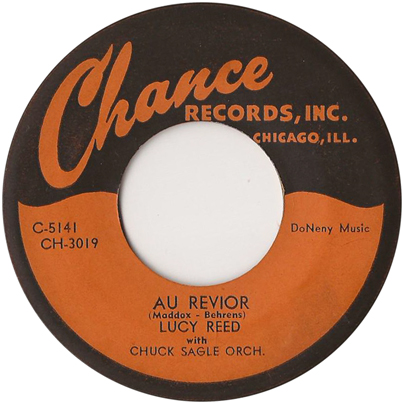
The last release on the maroon and silver pop label was Chance 3021, by Fred Montell. The Montell session was also left off Art Sheridan's list. Accompaniment was directed by Darrell Balasty, a guitarist who had recently joined a combo at the Brass Rail led by singer Ann Edwards (Billboard, February 6, 1954, p. 22). The matrix numbers are in a 54- series, apparently unrelated to the numbers on the Ann Gilbert single (in the vinyl, the Montell matrix numbers are 54341 and 54342, without hyphenating). Could they have been done at MBS? We wonder whether the 45s used the black on orange, but we don't know whether 3021 was released on 45.
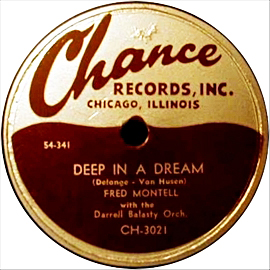
We do know when the single was recorded (an item in Billboard, May 29, 1954, p. 67, gave the titles and said "last week"). We also learn from Billboard that Montell was making his recording debut, that he was in some sense a Balasty project, and that "Gypsy Darling" had been written by Balasty and his wife. Most likely the Balastys paid for the session. "Gypsy Darling" does sound like gypsy music, and the accompaniment on both sides is heavy on the guitar (there is no piano).
The singer long resisted our search efforts because his correct stage name (in the trades, on the labels to all of his later records, in his publicity photos) was Freddie Montell. Fred S. Montalto was born in 1930. He sang in a smooth, semi-operatic tenor. His Chance release may or may not have helped him get gigs, but in 1956 he was at Mr. Kelly's for a while, and starting on September 10, 1958 he had a run at the Preview Lounge.
In 1956 Montell recorded two singles for ABC-Paramount, and in 1958 and 1959 he did four for a small Chicago label called Ermine (it was owned by one Bill Erman). The Preview Lounge gig roughly coincided with his first recording on Ermine (both worked into a quick mention in Cash Box, September 13, 1958, p. 46). Ermine 777 ("The Things I Love" b/w "Bow 'n' Arrow") carries J series matrix numbers from RCA Victor's custom pressing operation, indicating that it was made in 1958. It also credits a Paul Jordan for conducting the studio band; was this the Paul W. Jordan who once recorded for Gold Seal? Ermine 110, another J series item, featured the arrangements of Warren Knoble, who is better known for his work such things as "Goldie the Green-Eyed Octopus" (see our JOB page). One of the sides was titled "Stop and Rock."
Erman had particular hopes for a novelty rock and roll number he had written: "(Ooey Gooey) Green Cheese." It was released with special label art. Allied Record Distributors thought it was handling a winner (Cash Box, March 21, 1959, p. 34) and sent cheese to record distributors and DJs to promote it (Cash Box, April 11, 1959, p. 56; the single got a favorable review on p. 18). The band is playing rock and roll and Montell is credible singing it.
What might be Montell's last Ermine (they were not numbered sequentially) is Ermine 30, from 1960 or thereabouts. The titles suggest a pop record. Definitely done in 1960 (it has RCA Victor matrix numbers in the L series) was a one-off single on Treble 7716.
In 1965 Montell cut what looks like his final recording effort for another small Chicago label called Aldon. The Aldon features studio bands led by Carmen Dello, once associated with the KaHill label. "Mitzi" is pure Dixieland, with a band that's OK but a little too heavy on the banjo rolls. The lyrics are ordinary, but Montell switches from English to Italian, and one doesn't normally get that on a Dixieland record. "You for Me, Me for You" is a ripe ballad with strings, two flutes, and piano conspicuous in the accompaniment. It's fair to call one side of the Aldon jazz and the other pop.
Fred Montalto died on April 18, 2009, in Western Springs, Illinois (http://articles.chicagotribune.com/2009-04-19/news/0904180430_1_il-interment-queen-heaven-cemetery). He was 79.
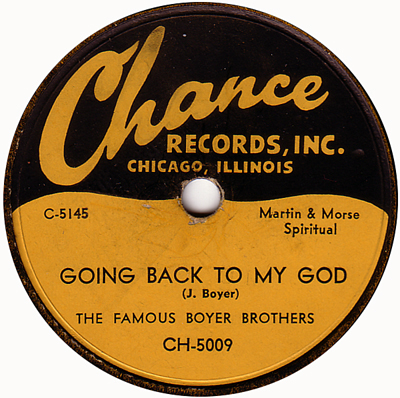
The very last gospel session for the label was made by The Famous Boyer Brothers. James Buchanan Boyer and Horace Clarence Boyer were born in Winter Park, Florida. James was born on April 3, 1934; Horace was born on July 28, 1935. Their father, Climmie Boyer Sr., was a pastor in the Church of God in Christ. Horace was a tenor, James was a baritone, and both played piano. In-state, they performed at many of the same churches and halls frequented by Sister Rosa Shaw. According to someone who should know, "the brothers sang two-part harmony on slow songs and used call and response on jubilee and shout songs. Singing in the sanctified style, they were adept at building tension through the use of a vamp" (Horace Clarence Boyer, in his 1995 book How Sweet the Sound: The Golden Age of Gospel). The brothers recorded for Excello in July 1952, when Horace was still in high school.
Their Excellos appear to be much better known than their single release on Chance 5009. It may have been the only Chance 78 with the black on orange label design. Though 5009 was not issued commercially on 45 to our knowledge, the company was considering the move; Big Joe Louis recently located a 45-rpm test pressing with a white label.
According to Hayes and Laughton's Gospel Discography, James played piano on the session, Horace played organ, and they were joined by an unidentified drummer.
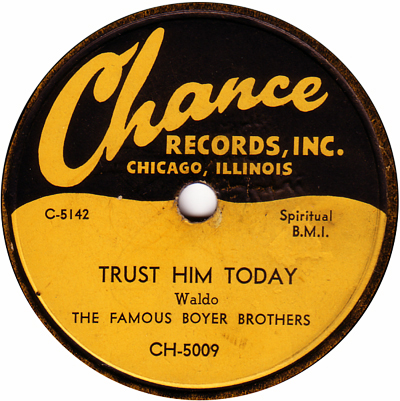
However, on January 19, 1956, the Board of Musicians Union Local 208, which had started policing the involvement of non-Union musicians on gospel sessions, summoned Gerald Spraggins, a pianist and organist who wasn't a member, and grilled him about recording sessions that he had made for Chance and Vee-jay. "He stated that he made another session [for Chance] with the Boyer Brothers and received $25.00" (Board meeting minutes, January 19, 1956, p. 3). Spraggins claimed that he had been working for "Professor Bradford," i.e., pianist and choir director Alex Bradford, who handled all negotiations with the record company (and allegedly withheld some of his pay). So most likely the brothers were accompanied by Bradford at the piano and Spraggins on organ. (Spraggins also recalled recording with the Bradford Singers for Chance, but if his recollection was correct the sides weren't just left unissued—they haven't shown up in any of our sources. The Bradford singers had previously recorded for Apollo in 1951 and 1952; in 1953 and 1954 they made three sessions for Specialty.)
The Boyer Brothers' Chance sides ended up with Vee-Jay a few months later. Chance 5009 crept out as the company was winding down; it was reviewed in Billboard on October 23, 1954 (p. 36). It got a straight-up reissue on Vee-Jay 130, in March 1955 (it was advertised in Cash Box on March 12, p. 29). The other two sides that the brothers had recorded for Chance were used on Vee-Jay 163, which as far as we know came out in December 1955, and Vee-Jay 209, released in October 1956.
In 1957, the Boyer Brothers recorded one more time for Vee-Jay. A decade later they cut 2 LPs for Savoy, in 1966 and 1967. In later years, both went into academia. James became a professor of Education and Ethnic American Studies at Kansas State University. Horace was a professor of Music at University of Massachusetts Amherst from 1973 to 1999. He died in Amherst, Massachusetts, on July 21, 2009. (See Horace Clarence Boyer's obituary in the Amherst Republican, July 23, 2009 at http://obits.masslive.com/obituaries/masslive/obituary.aspx?n=horace-clarence-boyer&pid=130192723.
Time was growing short. After the Boyer Brothers session, Sheridan recorded four sides by one Johnny Low, maybe a pop singer on the evidence of the titles (it's the only evidence we have). They remain unheard.
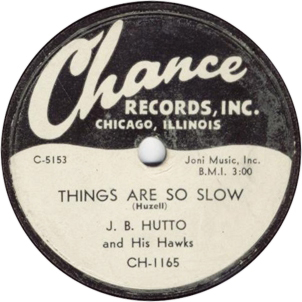
When J.B. Hutto and His Hawks entered Universal Recording on October 19, they had no idea that they were saying farewell to Chance Records. On this occasion the Hawks were augmented with Johnnie Jones on piano. Five sides were recorded. Chance 1165, an intense coupling of "Things Are So Slow" and "Dim Lights," drew little interest upon release. Potential buyers weren't given much time for discovery; it was just six weeks later that Art Sheridan decided to close the company's doors. The first four sides from this session were later dealt to Vee-Jay, which assigned new master numbers (55-366 through 55-369) and entered them into its Master Book in November 1955. But by this time the principals at Vee-Jay had tried Floyd Jones and Sunnyland Slim, and were concentrating their blues efforts on Jimmy Reed; they did not see enough commercial potential in the Hutto sides to warrant releasing them. ne of the unissued sides ("Price of Love") made a belated appearance on a Delta Swing LP in the 1970s. The uniquely titled "Mouth Harp Mambo," which would have made for a two-sided 78, was finally released in 2019 on a Japanese 10-inch LP. "Thank for Your Kindness," unfortunately, may be lost.
Nothing was happening, recording-wise. Hutto got completely out of music for a long stretch, supposedly because in a club one night a woman broke his guitar over her husband's head. J. B. Hutto did not get on record again until 1965, when he was picked up by Vanguard for its Chicago Blues compilation series. He also recorded for Testament, but the key event was the classic Hawk Squat album that he cut for Delmark in 1967. (Eerily, despite more than a decade of changes in recording technology, Hutto's guitar sounds exactly the same for Delmark in 1967 as it did for Chance in 1954.) In 1975, Hutto took over the Houserockers after Hound Dog Taylor died, then started a New Hawks band, which recorded for Varrick. J. B. Hutto died of cancer in Harvey, Illinois, on June 12, 1983.
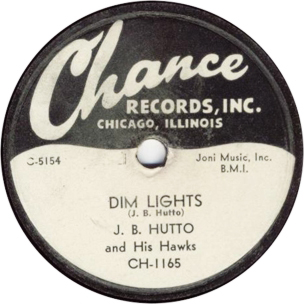
| Matrix | Artist | Title | Release Number | Recording Date | Release Date |
| *C5088 | The Moonglows | Secret Love | Chance 1152 | January 10, 1954 | January 1954 |
| *C-5089 | The Moonglows with Red Holloway Orch. | I Was Wrong | Chance 1156 | January 10, 1954 | June 1954 |
| *C-5090 | The Moonglows | 219 Train | Chance 1161 | January 10, 1954 | October 1954 |
| *C5091 | The Moonglows | My Gal | Chance 1161 | January 10, 1954 | October 1954 |
| *C-5092 | The Moonglows with Red Holloway Orch. | Ooh Rocking Daddy | Chance 1156 | January 10, 1954 | June 1954 |
| *C5093 | The Moonglows | Real Gone Mama | Chance 1152 | January 10, 1954 | January 1954 |
| *C5094 | Ch. Jackson [Chubby Jackson] | ? | unissued | January 1954 | |
| *C5095 | Chubby Jackson | Belinda's Blues | unissued | January 1954 | |
| *C5096 | Chubby Jackson | Blue Note | unissued | January 1954 | |
| *C5097 | Chubby Jackson | Rose Room | unissued | January 1954 | |
| *C5098 | Chubby Jackson | Holiday | unissued | January 1954 | |
| *C5099 | Chubby Jackson | Exactly like You | unissued | January 1954 | |
| S-5100 [*No Number] |
Johnny Miller and His Quintet | I Cover the Waterfront | Sabre SA-109 | prob. January 1954 | August 1954 |
| S-5101 [*No Number] |
Johnny Miller and His Quintet | Always | Sabre SA-109 | prob. January 1954 | August 1954 |
| *No Number | Johnny Miller | Parco | unissued | prob. January 1954 | |
| *No Number | Johnny Miller | Parkview Jump 1 | unissued | prob. January 1954 | |
| *No Number | Johnny Miller | Parkview Jump 2 | unissued | prob. January 1954 | |
| *No Number | Johnny Miller | Tenderly | unissued? | prob. January 1954 | |
| *No Number | Johnny Miller | Jumpin' with Symphony Sid | unissued | prob. January 1954 | |
| *No Number | Johnny Miller | Pretty Eyes | unissued? | prob. January 1954 | |
| *C5102 | The Five Echoes | So Lonesome | Sabre S105 | January 17, 1954 | February 1954 |
| *C5103 | The Five Echoes | Broke | Sabre S105 | January 17, 1954 | February 1954 |
| *C5104 | Wally Wilson [Walter Spriggs] |
If You Don't Love Me | Sabre S106 | January 17, 1954 | February 1954 |
| *C5105 | Wally Wilson [Walter Spriggs] |
The Hunt | Sabre S106 | January 17, 1954 | February 1954 |
| U5116 [*U5050] |
Five Echoes | That's My Baby | (Constellation LP CS-5) (Sabre 111 [boot]) |
January 17, 1954? | |
| U5117 [*U5051] |
Five Echoes | Why Oh Why | (Constellation LP CS-5) (Sabre 111 [boot]) |
January 17, 1954? | |
| C-5108 | Don Miller with Orchestra | Out of My Dreams | Chance 3017 | January 1954 | April 1954 |
| C-5109 | Don Miller with Orchestra | The Wind | Chance 3017 | January 1954 | April 1954 |
| *5118 | J.B. and His Hawks | Pet Cream Man | Chance 1160 | January or February 1954 | c. September 1954 |
| *5119 | J.B. and His Hawks | Lovin' You | Chance 1160 | January or February 1954 | c. September 1954 |
| *C-5120 | J.B. and His Hawks | Now She's Gone | Chance 1155 | January or February 1954 | May 1954 |
| *C-5121 | J.B. and His Hawks | Combination Boogie | Chance 1155 | January or February 1954 | May 1954 |
| *U8792 | The BEL Trio | Toothpicks | unissued | c. February 1954 | |
| *U8793 | The BEL Trio | I Only Have Eyes for You | unissued | c. February 1954 | |
| *8794 | The BEL Trio | More Beer | Chance 3018 | c. February 1954 | after March 1954 |
| *8795 | The BEL Trio | Fine and Dandy | Chance 3018 | c. February 1954 | after March 1954 |
| 54-1416 | Ann Gilbert with the Don Ragon Orchestra | Our Fav'rite Waltz | Chance 3014 | c. February 1954 | March 1954 |
| 54-1417 | Ann Gilbert with the Don Ragon Orchestra | When You Walked By | Chance 3014 | c. February 1954 | March 1954 |
| *C5126 | James Hewitt | Cross My Heart | unissued | c. February 1954 | |
| *C5127 | James Hewitt | Baby Don't Get Rough | unissued | c. February 1954 | |
| *C5128 | James Hewitt | It's All Over Now | unissued | c. February 1954 | |
| *C5129 | James Hewitt | Sorry Baby | unissued | c. February 1954 | |
| *C5130 | Kelly Bros. | Let Me Fly | unissued | c. February 1954 | |
| *C5131 | Kelly Bros. | God Laid His Hands on Me | unissued | c. February 1954 | |
| *C5132 | The Flamingos with Red Holloway Orch. | Cross over the Bridge | Chance 1154 | February 17, 1954 | March 1954 |
| *C5133 | The Flamingos with Red Holloway Orch. | Listen to My Plea | Chance 1154 | February 17, 1954 | March 1954 |
| *C-5134 | The Five Chances | I May Be Small | Chance 1157 | c. April 1954 | August 1954 |
| *C5135 | The Five Chances | California | (Constellation LP CS-5) | c. April 1954 | |
| *C5136 | The Five Chances | Nagasaki | Chance 1157 | c. April 1954 | August 1954 |
| *C5137 | The Five Chances | Make Love to Me | (Constellation LP CS-5) | c. April 1954 | |
| 54-341 | Fred Montell with the Darrell Balasty Orch. | Deep in a Dream | Chance 3021 | May 1954 | Fall 1954 |
| 54-342 | Fred Montell with the Darrell Balasty Orch. | Gypsy Darling | Chance 3021 | May 1954 | Fall 1954 |
| *C-5138 | Jeanne Kassel with Bill Kessler Orch. | Chalo Mio Ray | Chance 3020 | July 1954 | July 1954 |
| *C-5139 | Jeanne Kassel with Bill Kessler Orch. | Can I, Will I | Chance 3020 | July 1954 | July 1954 |
| C-5140 [*U5140] |
Lucy Reed with Chuck Sagle Orch. | A Night Is Dark [Dark Is the Night} |
Chance 3019 | July 1954 | Fall 1954 |
| C-5141 [*U5141] |
Lucy Reed with Chuck Sagle Orch. | Au Revior [sic] | Chance 3019 | July 1954 | Fall 1954 |
| *U5142 | Famous Boyer Bros. | Trust Him Today | Chance 5009 (Vee-Jay 130) |
August 11, 1954 | c. September 1954 (March 1955) |
| *U5143 | Famous Boyer Bros. | Let's Walk Together | (Vee-Jay 209) | August 11, 1954 | (October 1956) |
| *U5144 | Famous Boyer Bros. | I Love to Tell the Story | (Vee-Jay 163) | August 11, 1954 | (December 1955) |
| *U5145 | Famous Boyer Bros. | Going Back to My God | Chance 5009 (Vee-Jay 130) |
August 11, 1954 | c. September 1954 (March 1955) |
| *5146 | Johnny Low | I'm Sweet on You | unissued | c. September 1954 | |
| *5147 | Johnny Low | Lonesome | unissued | c. September 1954 | |
| *5148 | Johnny Low | My Broken Heart | unissued | c. September 1954 | |
| *5149 | Johnny Low | Leave Me Bluest | unissued | c. September 1954 | |
| *U5152 | J. B. Hutto | Price of Love | (Delta Swing LP 379) | October 19, 1954 | |
| *C-5153 | J. B. Hutto and His Hawks | Things Are So Slow [Things Is Tuff] | Chance 1165 | October 19, 1954 | November 1954 |
| *C-5154 | J. B. Hutto and His Hawks | Dim Lights | Chance 1165 | October 19, 1954 | November 1954 |
| *U5155 | J. B. Hutto | Thank You for Your Kindness | unissued | October 19, 1954 | |
| *U5156 | J. B. Hutto | Mouth Harp Mambo | unissued | October 19, 1954 |
In previous histories, the closing of Chance in December of 1954 has been characterized as a business failure. (The standard lore is presented in the liner notes to the 2-CD set on Charly CDGR 146, Chicago Blues: The Chance Era, a valuable set that collects nearly all of the non-JOB Chance blues material. The history of Chance presented there is more reliable, we must note, than the multidimensonally wrongheaded comments about Aristocrat and Chess...) The received view is incorrect. What was really going on was that Sheridan and Abner were getting deeply intertwined in the business dealings of James Bracken and Vivian Carter at Vee-Jay. The discerning collector will even note that Vee-Jay's maroon and silver 78 labels resemble the classic Chance pop series labels in use in 1953. Noted Sheridan, "I just got tired of it, and I was spending a lot of time with Vivian, Jimmy, and Abner, and didn't want to be a producer."
In all probability Sheridan was losing his youthful enthusiasm for the business, and decided to pursue a subsequently highly successful career in real estate. After a brief stay at United Distributors, Abner went over to Vee-Jay to run the company as general manager. Abner was given one-third equity in Vee-Jay, and probably brought some seed money with him. We suspect that Sheridan was a secret investment partner in Vee-Jay. In both a 1992 interview with Robert Pruter and a more recent interview with Nadine Cohodas he strongly implied that this was the case. He is known to have partnered in the Sutherland Lounge when Vee-Jay owned it. Sheridan and Abner were also partners for a time in The Cloister, which they bought in 1960. Besides not wanting to hurt Vee-Jay's image as a successful Black-owned company, Sheridan was acutely aware of Musicians Union hostility—Local 208 actually warned Carter and Bracken not to have anything to do with him—which certainly endured until the Union locals merged in 1966 (and Vee-Jay went out of business).
Many Chance artists moved over to Vee-Jay. Al Smith, who had been responsible for so many of the accompaniments for blues singers and doowop groups, defected to the new company in June 1954. (Smith hedged his bets by handling accompaniments for United/States and Parrot/Blue Lake until those operations went into decline; he may have also picked up some studio work at Chess.) For the next 4 1/2 years Al Smith and guitarist Lefty Bates ran the house band on most Vee-Jay sessions. Red Holloway was the go-to guy on tenor sax through mid-1956, when he was replaced by the great blues player Lucius "Little Wash" Washington. Mac Easton, Horace Palm, and Norman Simmons became regulars at Vee-Jay, along with drummers Al Duncan, Paul Gusman, and (until he joined Ahmad Jamal's trio) Vernel Fournier. King Kolax cut two quintet sessions for Vee-Jay in 1954 and 1955. Tommy Dean became a regular. Even Willie Jones put out a single on Vee-Jay, characteristically titled "My Thing" b/w "My Other Thing" and played in a style midway between Milt Buckner and Cecil Taylor. The Five Echoes also moved to Vee-Jay, while the Five Chances resurfaced at States, the Moonglows went straight to Chess, and the Flamingos ended up recording for Leonard and Phil after a year at Parrot.
What Chance produced during its four years of existence doesn't rank with the output of Chess or Vee-Jay. Still, there are a lot of collector items for both blues and vocal groups in the catalogue and it remains one of the legendary labels of the golden age of rhythm and blues. The pop items have less durability, though the Eddie and Chuck single, or the novelty instrumental "Pizza-Cat-Oh," which featured the versatile Swing violinist Remo Biondi, still warrant a listen, as do Lucy Reed's sides.
For all of its accomplishments, Chance produced few, if any, rhythm and blues records that could be characterized as rock 'n' roll. When the company closed, the rock 'n' roll revolution was just being launched. It was Chess that would take Sheridan's biggest vocal acts, the Moonglows and Flamingos, and turned them into rock 'n' roll stars. Meanwhile, the Chance bluesmen would sink into neglect for a decade, until the blues boom of the mid-1960s.
We have placed the sessions that Chance obtained from other labels or producers in a separate section. At present we know of 42 items that Chance leased or purchased; however, given Chance's lax policy regarding its U and C numbers, which were sometimes pasted onto purchased sides, there could be more acquisitions lurking in the yearly lists.
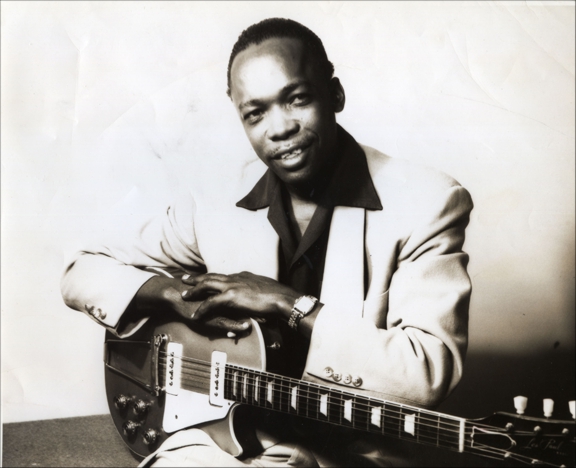
The first tracks to be leased or purchased by the Chance operation were four 1949 recordings by bluesmanJohn Lee Hooker. These were obtained from Joe Von Battle in Detroit. Featuring just Hooker's vocals and guitar, these were reportedly recorded in the back of Von Battle's record store, and they sound like it. The transaction took place at some point in 1951, when Sheridan couldn't do any new recording. The hope was to put some new releases in the bins and generate some reflected sales off Hooker's recent successes on the Modern label. Maybe the Chance releases brought in some revenue, but none of them were advertised or reviewed in the trades. Though Hooker disguised his identity when recording for other labels, going by such handles as Texas Slim and Birmingham Sam, Chance must not have been too worried about lawsuits filed by the Bihari brothers, who ran Modern. Art Sheridan was satisfied with "John Lee Booker," which fooled absolutely no one.
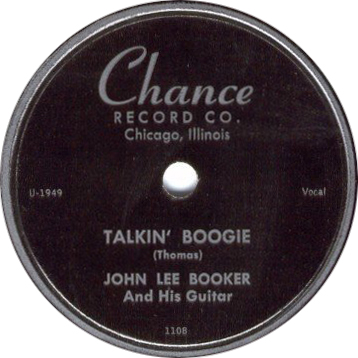
The next year, Chance came up with one more John Lee Hooker single. Chance 1122, attributed to "John L. Booker and His Guitar," is so rare that, according to John Tefteller, only 6 copies are known to exist. That's on 78 and 45—for it was with Chance 1122 that the company started releasing new records on 45 rpm. The sound on both sides is considerably worse than on the other Hooker Chance releases. Hooker is accompanied by James Watkins on piano and Curtis Foster on drums, who often worked with him in clubs at the time, and "609 Boogie" (onto which Chance grafted applause at the beginning and the end) strongly resembles the two takes of this piece that were reissued in 1995 on Pointblank Classics CD 40116, Danceland Years, which preserves the mortal remains of Morry Kaplan's hyperobscure independent label. (The "609 Boogie" that came out on Chance has nearly all the same shouts from the participants, the same tag line from Hooker's guitar, the same paucity of vocalizing from Hooker, and the same shallow, crackly sound. "Road Trouble" was not released on Danceland, but it has the same lineup and same sonics.)
Venturing into John Lee Hooker discography is like competing in an off-road rally on quicksand, but our judgment is that "Road Trouble" and "609 Boogie" were among the pieces that were recorded on a portable disk-cutter in February or March 1949, at a Detroit club (either the Royal Blue or the Blue Heaven). Morry Kaplan claimed to have recorded them himself, but other sources give the responsibility to record store owner Elmer Barbee (who originally claimed co-composer credit on "609 Boogie"—besides, 609 was the address of his store, and he appears to be contributing to the shouts on the record). According to Dave Sax's liners to a release of Hooker titles that were sold to Savoy in 1948 and 1949 (John Lee Hooker Detroit 1948-1949, Atlantic/Savoy 92910), "Road Trouble" and "609 Boogie" were part of a package of 4 sides from this session that Elmer Barbee sold to Savoy in 1949. Neither "Road Trouble" nor "609 Boogie" was issued on Danceland before it went belly-up in 1951, and Savoy didn't use them either. Hence, presumably, Barbee's willingness to offer them to Chance in 1952.
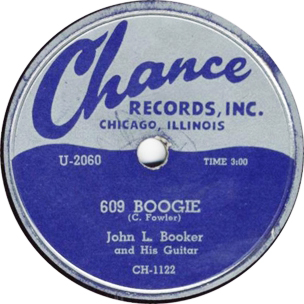
Later in 1952, Art Sheridan bought three sessions from DJ and freelance record producer Al Benson that had previously appeared (at least in part) on Old Swing-Master. But Old Swing-Master had been founded by Egmont Sonderling (of United Broadcasting Studio) to make some money off masters that he had held on to whenVitacoustic went bankrupt; he cut Al Benson in on the label in the hope of boosting sales.
The three T-Bone Walker items, with backing by a studio band led by pianist Marl Young, were recorded for the tiny Rhumboogie label back in December 1945. Two were released on Mercury in 1946 (Mercury distributed Rhumboogie for a while), and two showed up on Old Swing-Master 11 in March 1949 ("She Is Going to Ruin Me" and "My Baby Left Me"). The next step in their tortuous history was their sale to Art Sheridan, who, so far as we know, never put them out on Chance (though years later he did issue them on an LP that came out of his Constellation venture with Ewart Abner, Jr.).
Two sides by the vocal harmony group, the Four Shades of Rhythm ("My Blue Walk" and "Baby I'm Gone") were recorded for the Vitacoustic label at the end of December 1947 and not released at the time (the label ran into financial trouble right after putting out two previous sides by the group). When Vitacoustic filed for Chapter 11 bankruptcy in February 1948, the masters remained in the hands of Egmont Sonderling, whose studio hadn't been paid for them. These two sides came out on Old Swing-Master 13, also in March 1949. Al Benson sold them to Chance, but again Sheridan appears not to have released them on his label. "Everything I Have Is Yours" came from the same source.
On December 28, 1952, Chance is sometimes thought to have recorded a Detroit-based R&B singer named Kitty Stevenson (she was identified in Sheridan's documents as "Stevens"). According to Marv Goldberg's article at https://www.uncamarvy.com/KittyStevenson/kittystevenson.html, she was born Katherine Louise Moore in Thomson, Georgia, on May 30, 1920; her family moved to Detroit at an unknown date. In 1936 she married William Stevenson in Detroit. She began working in Detroit clubs, as a singer or a dancer, in 1939. In November 1947 she opened Lee's Club Sensation with T. J. Fowler's combo. With the Fowler ork (not Todd Rhodes as we once thought), she recorded at least 8 sides in Chicago for Vitacoustic, around December 15, 1947. Kitty Stevenson opened the Flame Show Bar in Detroit on June 24, 1949, remaining there through January 1950; for about three months, Todd Rhodes' combo was the house and. She recorded with Rhodes for the Sensation early in 1950. Shen made one more session with the Rhodes band for King, in May 1951. Unfortunately, Kitty Stevenson was diagnosed with breast cancer shortly after that session. She was able to return to work in November 1951 but was rehospitalized in February 1952. Kitty Stevenson died at Detroit Memorial Hospital on May 31, 1952. She was the mother of Mickey Stevenson, a producer for Motown in the 1960s, and Lonny Stevenson, an actor and director.
Chance obviously couldn't have recorded Kitty Stevenson. What happened on December 28 is that Sheridan bought her Vitacoustic masters from Al Benson, who had operated Old Swing-Master along with recording studio owner Egmont Sonderling. Two of the titles, "Hold 'Em Joe" and "With You," had previously appered in May 1949 on Old Swing-Master 20. "I'm Satisfied" is another title that she had recorded for Vitacoustic (it was issued on Old Swing-Master 10 in January 1949) and "Sleeping by Yourself" is the original title for what was later called "Blues by Myself" (also on Old Swing-Master 10).
The first release of any of Stevenson's unissued sides took place in 1977 on the Chance-derived P-Vine PLP-708, a Japanese LP titled Chance Vintage Blues R&B Crops Volume 4: Kitty Stevens/Tampa Red, Bobby Prince. Unfortunately, the recording date shown in the liner notes was 5 years too late, and the four sides that had been released on Old Swing-Master were not recognized as such. Much later, some Kitty Stevenson sides were included in an Ace compilaton on CDCHD 1087.
Nine tracks by jazz trumpeter Howard McGhee were entered into the list around this same point. These had been recorded in late December 1947, again by the Vitacoustic company. They, too, had come under the control of the Old Swing-Master operation after Vitacoustic filed for bankruptcy at the end of February 1948. Old Swing-Master put out one single from this cache of material before Benson sold the items to Art Sheridan.
From research by Art Zimmerman, we know that Howard McGhee cut one session for Vitacoustic on either October 15 or November 10, 1947, while in town with a Jazz at the Philharmonic tour. He returned to Chicago during the last week of December 1947 with his own group, cutting 12 more sides for Vitacoustic on that occasion. Two of those sides showed up on Old Swing-Master 14 in March 1949. Sheridan didn't write down all of the titles, but those that he did mention are all from the late December 1947 sessions. Sheridan never did anything with this material; Benson later sold 12 tracks (plus two alternate takes) to Savoy, which put the 12 master takes out on an LP in 1955. Two other sides did not pass to Savoy in that transaction and have never been issued in any form.
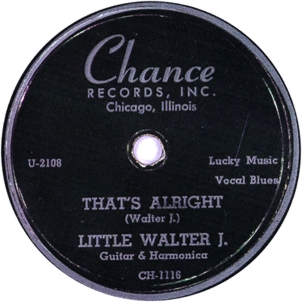
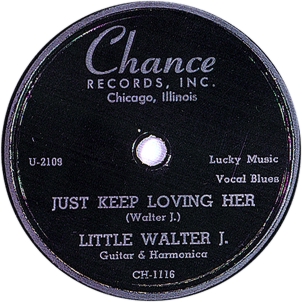
Small Chicago operations provided the two Little Walter sides, originally put out in 1947 on Ora Nelle, and the two Sunnyland Slim sides, first released in 1948 on Joe Brown's Opera label. There was some degree of sharp practice going on here. Only "Just Keep Loving Her" featured Little Walter's singing; "That's Alright" had become a staple of Jimmy Rogers' repertoire, but on its first recording it was sung by another guitarist, Othum Brown. Meanwhile, even though in 1952 Sunnyland was under contract to Joe Brown's JOB label, he was still being referred to as "Delta Joe" on the Chance release. The rationale for this subterfuge is lost in the mists of time.
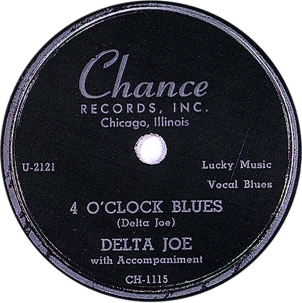
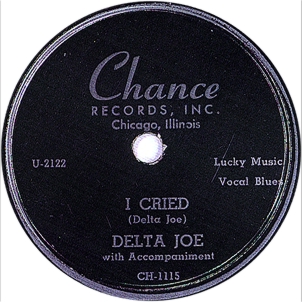
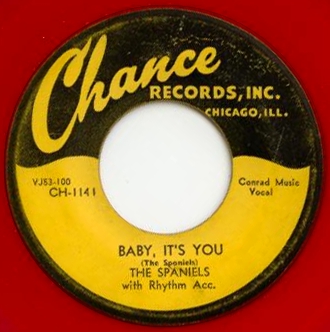
In May 1953 Jimmy Bracken and Vivian Carter conducted the first recording session for their Vee-Jay label. Vee-Jay had not acquired much distribution yet, so in July 1953 Chance stepped in, pressing its own versions of Vee-Jay 101 by The Spaniels and Vee-Jay 100 by Jimmy Reed. (The pickup of The Spaniels' record was announced in Dave Clark's "Rhythm and Blues Tattler," Billboard, July 25, 1953, p. 51.) The Chance releases, 1141 and 1142, carried the Vee-Jay matrix numbers. Although further Chance releases of Vee-Jay material proved unnecessary, Art Sheridan probably began investing in Vee-Jay around this same time.
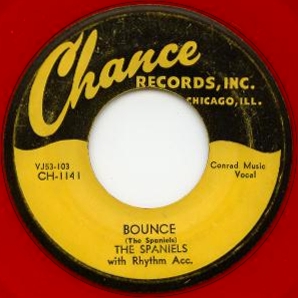
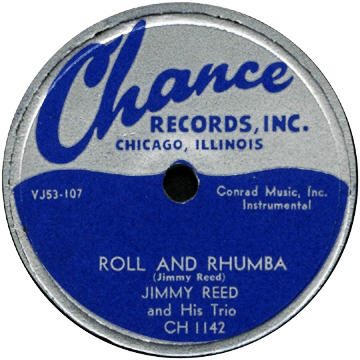
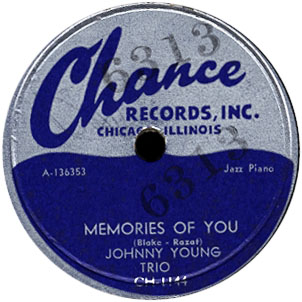
Johnny Young (full name John Merritt Young) was born March 16, 1922 in Little Rock, Arkansas. Young graduated from DuSable High School in 1939. By the time of this recording, he had been on the road with Andy Kirk's Clouds of Joy (1943-1945, then again for a while in 1946 and 1947). Returning to Chicago, he played in Dick Davis's combo (1947-1949), going out with his own trio in 1950. The trio recording that appeared on Chance, the first under Young's own name, features lush, Erroll Garner-style piano on two ballads, with the standard lounge accompaniment of guitar and bass. Jazz piano, but not in John Young's mature style. (John Merritt Young was not related to Johnny "Man" Young, the blues guitarist and mandolinist who recorded for Ora Nelle and Planet.)
The masters to these sides had to change hands twice before Art Sheridan got hold of them. The MR matrix numbers on each side (these are the originals) came from Modern Recording Studio at 55 West Wacker Drive. Chess recorded Claude McLin there in November 1950. JOB made a bunch of sessions there between 1950 and 1952. Most importantly, a tiny label called Seymour, run by Seymour Schwartz out of his record store, used Modern Recording Studio for two or three sessions in September 1950. MR2755-1 and MR2755-4 (in the trailoff for the Johnny Young Trio session) indicate a session at Modern Recording Studio around this time. The Johnny Young 78 also has S95-A and S95-B in the wax—indicating a planned release on... Seymour (it never materialized). In fact, matrix 2755-2 from this same session was used on Seymour 97-B.
As announced in Billboard on December 2, 1950, Discovery Records bought most of the Seymour masters, attaching new A series matrix numbers to them. LeRoy Jackson (who appeared on Lurlean Hunter's "I Hadn't Anyone 'till You" on Seymour 99-B, along with John Young and tenor saxophonist Kenny Mann) was probably the bassist here. Discovery went out of business in 1952, enabling Sheridan to obtain the sides by a pianist who was already an established presence on the Chicago scene.
After the Seymour session, Young recorded with Eddie Chamblee's group for Premium (1951), Coral (1952), and United (1953). Putting out his first LP as a leader in 1956, John Young would subsequently record as a leader for Argo, Delmark, and other labels. He retired from playing in 2005 and died in Chicago on April 16, 2008. For a complete John Young discography, see http://www.jazzdocumentation.ch/john_young/young.html
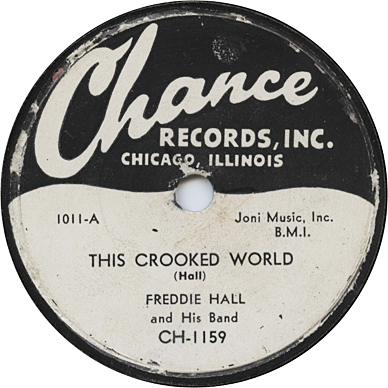
Freddie Hall was a rather coarse-voiced baritone blues shouter, who originally cut his single for J. Mayo Williams' tiny Ebony label, in its High Fidelity incarnation. The first release was Ebony 1011. According to the florid label copy on the Ebony, Hall was originally from Gadsden, Alabama. He played piano on the session, and was backed by unidentified musicians on tenor sax, guitar, bass, and drums. "This Crooked World" is one of many sides inspired by "I Don't Know" and "I'm Mad," which had been big hits for Willie Mabon on Chess. In 1954, Williams, 1952-1958 edition of Ebony had no distribution to speak of, cut a few deals with Joe Brown: Brown reissued an Ebony single by a doowop group called the Eagle-Aires, and picked up an isolated side by Sunnyland Slim that he reissued on another JOB single. Most likely it was Joe Brown who, in turn, brokered the Freddie Hall masters to Chance. (Hall's next release would take place in 1956, on Abco 103. Abco was part-owned by Joe Brown.) The joint venture had ended in October 1953, but, as happened with the first J. B. Hutto session, Brown was still transacting a little business with Art Sheridan.
In this case, the reissue, on Chance 1159, didn't get to spend much time on the market; it was released in August 1954, as Chance was putting less and less effort into promotion or distribution. (Chance 1159 was listed in Billboard on August 14, 1954, p. 41).
Our thanks to Bob Buchholz for help with the Young and Hall singles, and to the late George Paulus for locating the very rare original release on the Hall.
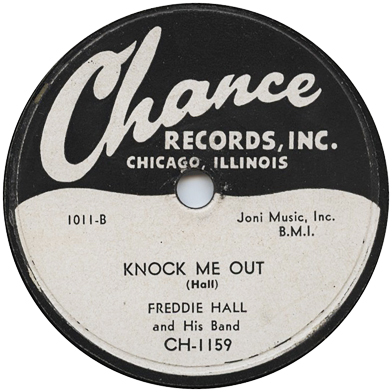
| Matrix | Artist | Title | Source | Release Number | Recording Date | Release Date |
| *No Number | T-Bone Walker | Come Back to Me [Baby] | Rhumboogie (Mercury 8016-B) | unissued on Chance | December 19, 1945 | |
| *No Number | T-Bone Walker | She's Gonna Ruin Me | Rhumboogie (Old Swing-Master 11B) | unissued on Chance | December 19, 1945 | |
| *No Number | T-Bone Walker | I Can't Stand Being Away from You | Rhumboogie | unissued on Chance | December 19, 1945 | |
| *U-2108 | Little Walter J. | Guitar & Harmonica | That's Alright [Ora-Nelle Blues*] | Ora Nelle 711A* | Chance 1116 | 1947 | May 1952 |
| *U-2109 | Little Walter J. | Guitar & Harmonica | Just Keep Loving Her | Ora Nelle 711B | Chance 1116 | 1947 | May 1952 |
| *No Number | Kitty Stevens [sic] | Train No. 1 | Vitacoustic | (P-Vine Special [J] PLP 708) | December 1947 | |
| *No Number | Kitty Stevens | Comes the Day | Vitacoustic | (P-Vine Special [J] PLP 708) | December 1947 | |
| *No Number [prob. V1941] |
Kitty Stevens | Sleeping by Yourself [Blues by Myself*] |
Vitacoustic (Old Swing-Master 10*) |
(P-Vine Special [J] PLP 708) | December 1947 | |
| *No Number | Kitty Stevenson | With You | Vitacoustic (Old Swing-Master 20) | (P-Vine Special [J] PLP 708) | December 1947 | |
| *No Number | Kitty Stevenson | Hold 'Em Joe | Vitacoustic (Old Swing-Master 20) | (P-Vine Special [J] PLP 708) | December 1947 | |
| *No Number [V1943] |
Kitty Stevenson | I'm Satisfied | Vitacoustic (Old Swing-Master 10) | (P-Vine Special [J] PLP 708) | December 1947 | |
| *No Number | Kitty Stevens [sic] | That Jive | Vitacoustic | (P-Vine Special [J] PLP 708) | December 1947 | |
| *No Number | Kitty Stevens | Things Will Change | Vitacoustic | unissued | December 1947 | |
| *No Number | Kitty Stevens | Someday | Vitacoustic | unissued | December 1947 | |
| *No Number | Howard McGhee | Les [prob. Merry Lee] | Vitacoustic | unissued on Chance | late December 1947 | |
| *No Number | Howard McGhee | Down Home [Down Home Jump] | Vitacoustic | unissued on Chance | late December 1947 | |
| *No Number | Howard McGhee | Sweet and Lovely | Vitacoustic | unissued on Chance | late December 1947 | |
| *No Number | Howard McGhee | Mood for Love | Vitacoustic | unissued on Chance | late December 1947 | |
| *No Number | Howard McGhee | Talk of the Town | Vitacoustic | unissued on Chance | late December 1947 | |
| *No Number | Howard McGhee | unidentified tune | Vitacoustic | unissued on Chance | prob. late December 1947 | |
| *No Number | Howard McGhee | unidentified tune | Vitacoustic | unissued on Chance | prob. late December 1947 | |
| *No Number | Howard McGhee | unidentified tune | Vitacoustic | unissued on Chance | prob. late December 1947 | |
| *No Number | Howard McGhee | unidentified tune | Vitacoustic | unissued on Chance | prob. late December 1947 | |
| V1950 Sw | Four Shades of Rhythm | My Blue Walk | Vitacoustic (Old Swing-Master 13) |
unissued on Chance | late December 1947 | |
| V1953 Sw | Four Shades of Rhythm | Baby I'm Gone | Vitacoustic (Old Swing-Master 13) |
unissued on Chance | late December 1947 | |
| No Number [B-5130] |
Four Shades of Rhythm | Everything I Have Is Yours | Vitacoustic unissued | unissued on Chance | late December 1947 | |
| OP8-B (*U-2121) | Delta Joe [Sunnyland Slim] | 4 O'Clock Blues [Train Time^] | Opera 5^ | Chance 1115 | prob. December 1947 | 1952 |
| OP8-A (*U-2122) | Delta Joe [Sunnyland Slim] | I Cried [Roll, Tumble and Slip^] | Opera 5^ | Chance 1115 | prob. December 1947 | 1952 |
| U-1943 [sic, on label] U-1948 [in vinyl] |
John Lee Booker [sic] and His Guitar | Miss Lorraine | Joe Von Battle | Chance 1108 | 1949 [Detroit] | 1951 |
| U-1949 | John Lee Booker and His Guitar | Talkin' Boogie | Joe Von Battle | Chance 1108 | 1949 [Detroit] | 1951 |
| *U1986 | John Lee Booker | I Love to Boogie | Joe Von Battle | Chance 1110 | 1949 [Detroit] | 1951 |
| *U1987 | John Lee Booker | Graveyard Blues | Joe Von Battle | Chance 1110 | 1949 [Detroit] | 1951 |
| JB 1401? *U-2060 |
John L. Booker [sic] and His Guitar | 609 Boogie | Elmer Barbee | Chance 1122 | February or March 1949 [Detroit] | 1952 |
| JB 1405? *U-2061 |
John L. Booker and His Guitar | Road Trouble | Elmer Barbee | Chance 1122 | February or March 1949 [Detroit] | 1952 |
| E2-CB-5680 | Jack Teter & His Trio | Going Around in Circles | Chance 3000 [Demo 1009] |
1952 [RCA Studios] | June 1953 | |
| E2-CB-5681 | Jack Teter And His Trio | In the Mood | [Demo 1010] | 1952 [RCA Studios] | ||
| E2-CB-5683 | Jack Teter & His Trio | I'm the Guy [Demo 1009] |
Chance 3000 | 1952 [RCA Studios] | June 1953 | |
| A-136351 (on label and in wax), MR-2755-1, S95-A (in vinyl) | Johnny Young Trio | You Go to My Head | Seymour [via Discovery] | Chance 1144 | September 1950 | September 1953 |
| A-136353 (on label and in wax), MR-2755-4, S95B (in vinyl) | Johnny Young Trio | Memories of You | Seymour [via Discovery] | Chance 1144 | September 1950 | September 1953 |
| VJ 53-100 | The Spaniels with Rhythm Acc. | Baby, It's You | Vee-Jay 101 | Chance 1141 | May 4, 1953 | July 1953 |
| VJ 53-103 | The Spaniels with Rhythm Acc. | Bounce | Vee-Jay 101 | Chance 1141 | May 4, 1953 | July 1953 |
| VJ 53-104 | Jimmy Reed and His Trio | High and Lonesome | Vee-Jay 100 | Chance 1142 | poss. June 6, 1953 | August 1953 |
| VJ 53-107 | Jimmy Reed and His Trio | Roll and Rhumba | Vee-Jay 100 | Chance 1142 | poss. June 6, 1953 | August 1953 |
| HF 1011-A | Freddie Hall and His Band | This Crooked World | Ebony 1011-A | Chance 1159 | early 1954 | August 1954 |
| HF 1011-B | Freddie Hall and His Band | Knock Me Out | Ebony 1011-B | Chance 1159 | early 1954 | August 1954 |
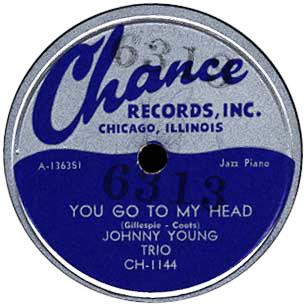
The matrix numbers preceded by an asterisk were provided to Marcel Chauvard by Art Sheridan. While Sheridan recalled most of the entries accurately, he left some items out, did not indicate all releases, and did not provide any recording dates.
To get this discography beyond the draft stage, we have drawn from voluminous sources:
Collectors Dr. Robert Stallworth, Robert Javors, and Bob Buchholz gave us additional help on some rare releases, and the late Eric LeBlanc helped with dates for the artists. Without Dr. Robert Stallworth's contributions we would not have release information on most of the 3000 series pop singles; in some cases we would not even know about the sessions, as Art Sheridan (who had sold the masters to Chance 3014 and probably never owned the masters to Chance 3021) didn't write all of his pop material down for Marcel Chauvard. Bob Koester made some further corrections, and Simon Evans unearthed a magazine reference to Kitty Stevenson's death. Finally, Bob Buchholz alerted us to the previously unknown blue Meteor label.
Besides its main 1100 series, Chance put out a 3000 series (for White pop records) and a 5000 series (for gospel). Meteor had a 100 series, and after that one was quickly abandoned Sabre also ran a 100 series.
We have fully tracked the Chance 1100 series, which extended from 1100 through 1165. Only 3 potential issues in this series are missing: we have not encountered Chance 1113, 1118, or 1164. The gaps appear to be genuine, as the 1100 series was already tallied pretty accurately in the pages of Blues Research, back in 1963. Just 1106, which eluded rediscovery till 2008, missed being listed in those days. We think 1113 was a deliberate omission for superstitious reasons, and 1118 and 1164 just got lost in the shuffle..
According to Bob Sladek, there are three bogus 1100-series Chance singles. While the "Chance 1166" by the Moonglows at least contains Chance material, there are copies of "Chance 1164" in circulation that consist of two sides recorded in Detroit by the doo-wop group, The Fascinators. The Fascinators did record in Chicago, for Parrot in March 1955; they never had any connection with Chance. A good deal more bogus is a "Chance 1167" featuring a latter-day doo-wop group with the edifying moniker, The Five Shits; an East Coast record dealer is said to have been the perpetrator.
The Chance 5000 gospel series has been previously misidentified in a few sources as a Sabre 5000 series. The gospel series ran from Chance 5000 through 5009. There are still items from it we would like to hear, as the 78s are all hard to locate today.
We know of just one Meteor release, on Meteor 100. This is so rare that no standard discographical source had previously mentioned it.
The Sabre 100 series appears to have run from 100 through 109. No Sabre 107 has turned up, and 110 and 111 are boots.
We didn't list the bootleg Sabre SA-110 above because none of the tracks on it are derived from the Chance operation. This 45 rpm EP consists of the Ebony Moods' "I Have News for You," as the first item on Side A, followed by "Drink Wine Spoodeodee" (Wynonie Harris); Side B consists of "I'm Just a Ladies Man" (Jimmy Witherspoon) and "Feelin So Sad" (Joe Turner). Only the Ebony Moods track is derived from a Chicago indie (it originally appeared on Theron 108). Our thanks to Konrad Nowakowski for alerting us to this bootleg (titles are spelled as on Nowakowski's copy).
In a search that took 15 years, with considerable help from Dr. Robert Stallworth, Marv Goldberg, Bill Daniels, Bill Jones, Andrew Brown, Marc Roberts, Mark Seganish, and Rod Branham, we have located all 21 Chance pop releases in the 3000 series. The series ran from 3000 through 3021. We haven't found a Chance 3013. We don't think there was one, for the same reason there is no 1113 in the main Chance series.
In 2007, a set of 16 78-rpm lacquers by the Four Shades of Rhythm turned up at an estate sale in La Crosse, Wisconsin. They carried stick-on labels from C. H. Bomgardner's Custom Sound Recordings in Evanston, Illinois. One of the songs on the lacquers, "I Apologize," was a hit for Billy Eckstine in 1951. The lacquers had been stored in two 78-rpm albums, one with 4 pockets for the four 10-inch lacquers, and one with five pockets (enough to hold the four 12-inch lacquers, along with an unrelated commercial release). There were two prints of a Spicer/Collins/McAfee/Lindsay photo, one autographed by the musicians. (There was also a postcard photo of the Lambert/Collins/Morris/Lindsay lineup from the Bar o' Music in Chicago, with autographs on the back. This can be seen above, in our description of the Four Shades and their 1952 session for Chance.)
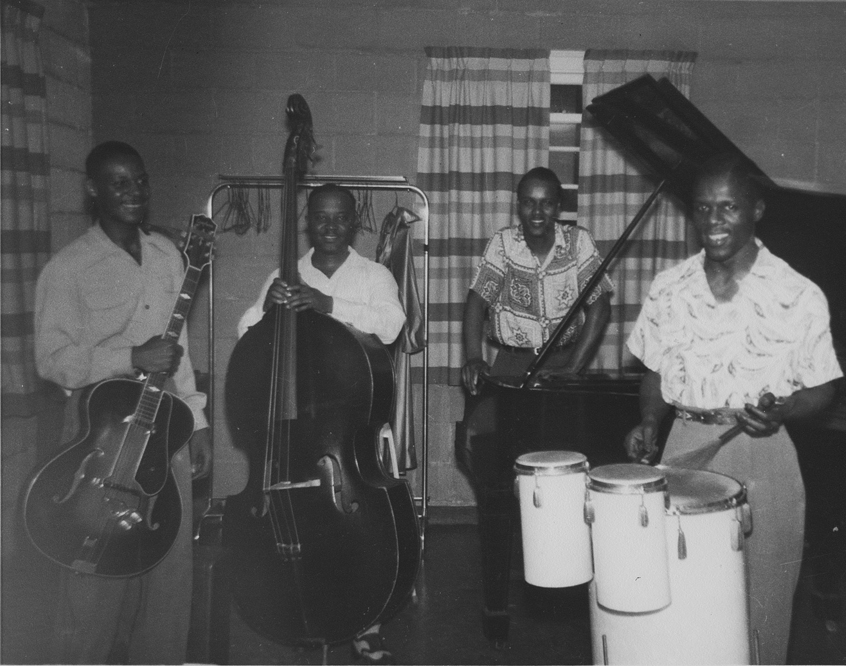
None of the sides on the lacquers has ever been released. It is not known whether the lacquers were cut direct to disk or dubbed from tape, but, if the latter was the case, we have no idea where the tapes are or were.
The lacquers appear to have been made in a studio but are semi-professional in quality. The vocal/instrumental balance is usually acceptable, but the guitar tends to be too loud, and sometimes unintentionally distorted. Oscar Lindsay's cocktail drums are sometimes too close to the mike, making for an occasional thump. A kind of studio echo was available, and it was occasionally applied, with results that vary in artistic value. There are a few jumps in recording level, but the session as a whole was underrecorded, and the lacquers were all cut at a low level.
What's more, the albums appear to have spent many years in a Wisconsin basement, and the lacquers in the 12-inch album all suffered some degree of mold damage. (The 10-inch lacquers fared much better and their playing surfaces are nearly clean.) A couple of the acetates have other mechanical flaws. The labels have darkened and, in some cases, decayed around the edges.
The lacquers do preserve a broad cross-section of the band's working repertoire in 1951, and the quality of the performances is pretty high. Using 12-inch blanks allows performances between 3 1/2 and 5 minutes in length to be included (7 of the sides on the 12-inch lacquers really needed the larger disks; the 3 minute "Satchel-Mouth Baby" could have been put on a 10-inch.)
We have given the lacquers letter indications (A through H) to preserve the couplings. This is strictly a cataloguing device—there are no numbers or letters on the labels, which carry just the song titles.
The Four Shades of Rhythm: Ed "Bones" McAfee (p, voc); Emmett Spicer (eg, voc); Booker Collins (b, voc); Oscar Lindsay (cocktail drums, lead voc).
Custom Sound Recordings, Evanston, Illinois, 1951
| [Get up the Stairs] Mademoiselle | 10-inch acetate A (unissued) | ||
| [Stompin' at the] Savoy | 10-inch acetate A (unissued) | ||
| Without a Song | 10-inch acetate B (unissued) | ||
| Old Black Magic | 10-inch acetate B (unissued) | ||
| Rockin [Good Rockin' Tonight] | 10-inch acetate C (unissued) | ||
| Perdido | 10-inch acetate C (unissued) | ||
| 12th Street Rag | 10-inch acetate D (unissued) | ||
| Robin's [sic] Nest | 10-inch acetate D (unissued) | ||
| I Apologize | 12-inch acetate E (unissued) | ||
| 100 Years from Today | 12-inch acetate E (unissued) | ||
| Too Soon to Know | 12-inch acetate F (unissued) | ||
| Boozie Woozie | 12-inch acetate F (unissued) | ||
| Satchel-Mouth Baby | 12-inch acetate G (unissued) | ||
| I've [sic] Got It Bad | 12-inch acetate G (unissued) | ||
| Ol' Man River | 12-inch acetate H (unissued) | ||
| Cottage for Sale | 12-inch acetate H (unissued) |
The Four Shades, these recordings show, were definitely not just a vocal group. Four sides ("12th Street Rag," "Robbin's Nest," "I Got It Bad" and the jokingly named "Boozie Woozie") are purely instrumental. "Perdido" and "Stompin' at the Savoy" are jazz performances with scat vocals. On "Perdido" the band sings the standard bop paraphrase, which is known as "Wahoo" when performed by itself; "Savoy" also becomes a scat vehicle, closing with its bop contrafactum "Byas a Drink."
There are sentimental ballads ("Cottage for Sale," "I Apologize," and "Without a Song") featuring Oscar Lindsay's vocal lead. "A Hundred Years from Today," which an earlier edition of the band had recorded for Vitacoustic, still features a lead from Ed McAfee, indicating that he remained in the group at this juncture; McAfee also gets the call on "Too Soon to Know." At a brighter tempo, "Old Black Magic" puts Lindsay in direct competition with Bill Samuels, whose trio recorded the song for Miracle in 1949; Lindsay's rendition also has a rhumba beat, but is more convincing than Samuels', which was not issued. "Ole Man River" has been rearranged into a quasi-operatic scena for Lindsay. Finally, "Satchel-Mouth Baby" and "Mademoiselle" are Swing numbers for vocal ensemble (the former written and introduced by Mary Lou Williams in 1944 and taken up by Four Jumps of Jive in 1945, the latter a risqué number borrowed from the Big Three Trio, which recorded it in 1946), and "Good Rockin' Tonight" is uptown rhythm and blues, programmed to prove that the group wasn't always genteel.
The occasion for recording so many lacquers—more than enough for a 12-inch LP—is unknown. When trying to interest record companies, most groups would make 1 or 2 demo disks, not 8. So we don't know whether copies were provided to Chance, or to other independent labels in business at the time. Or whether the group was hoping for an LP (Chance closed without ever issuing one).
Click here to return to the Red Saunders Research Foundation page.